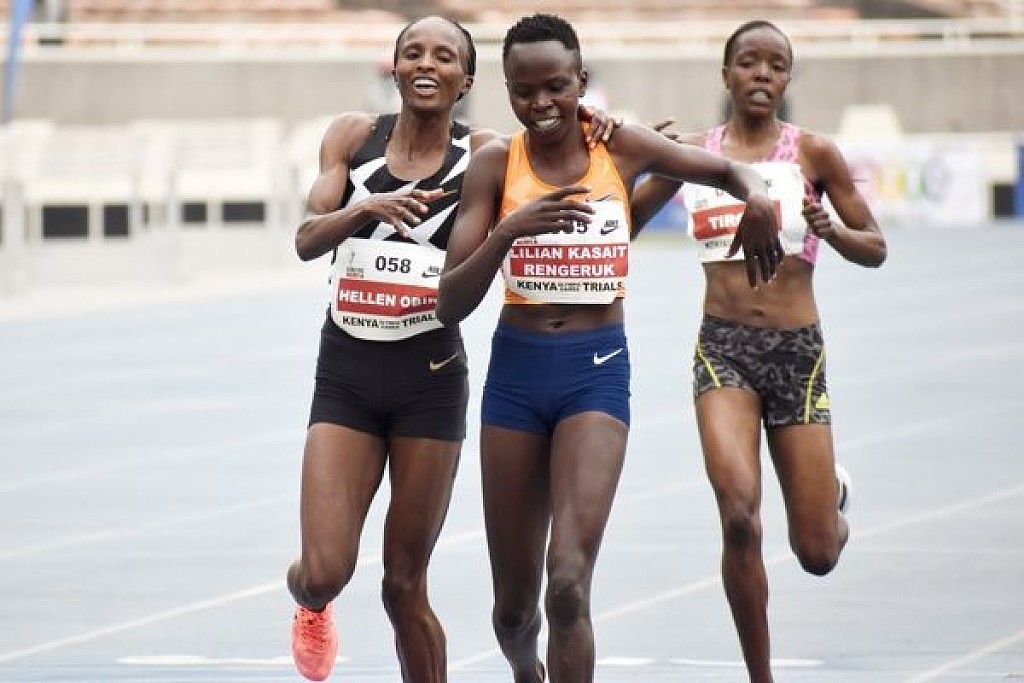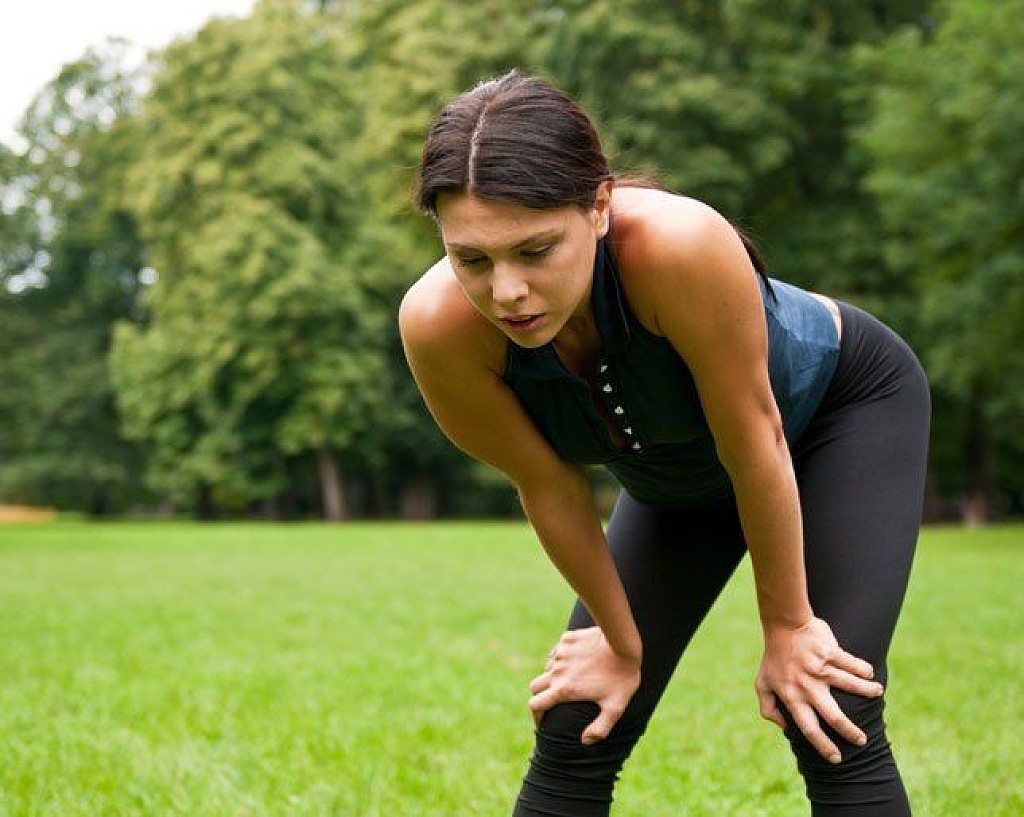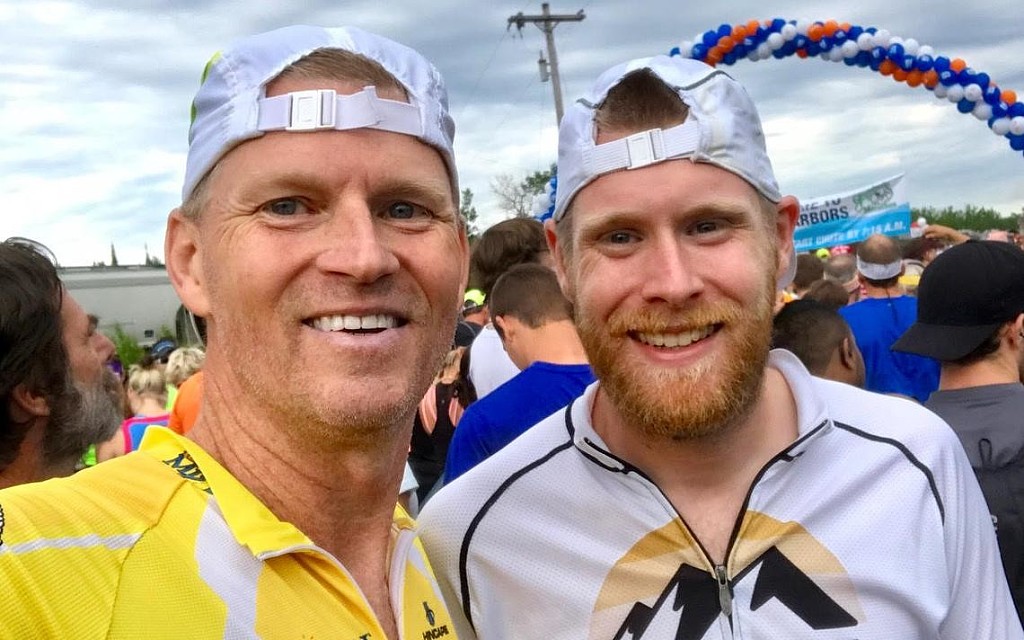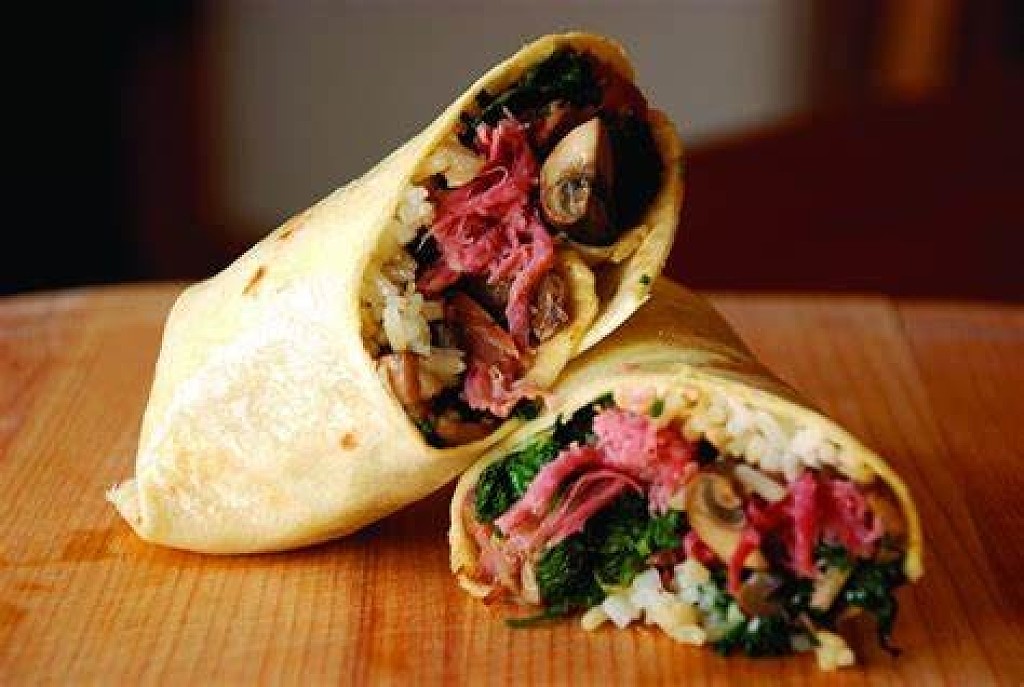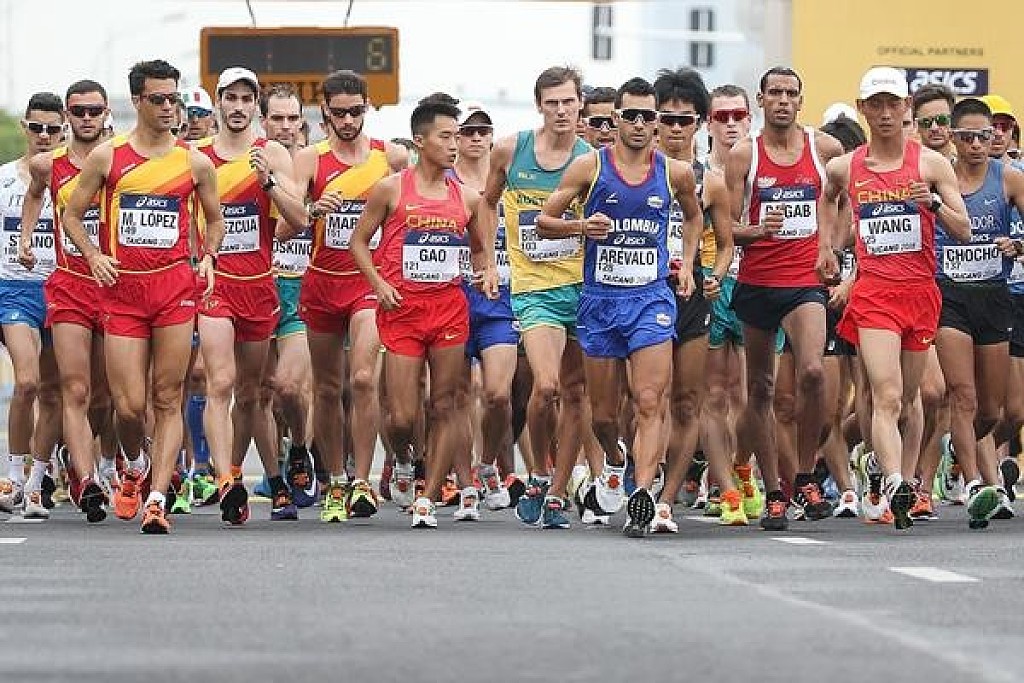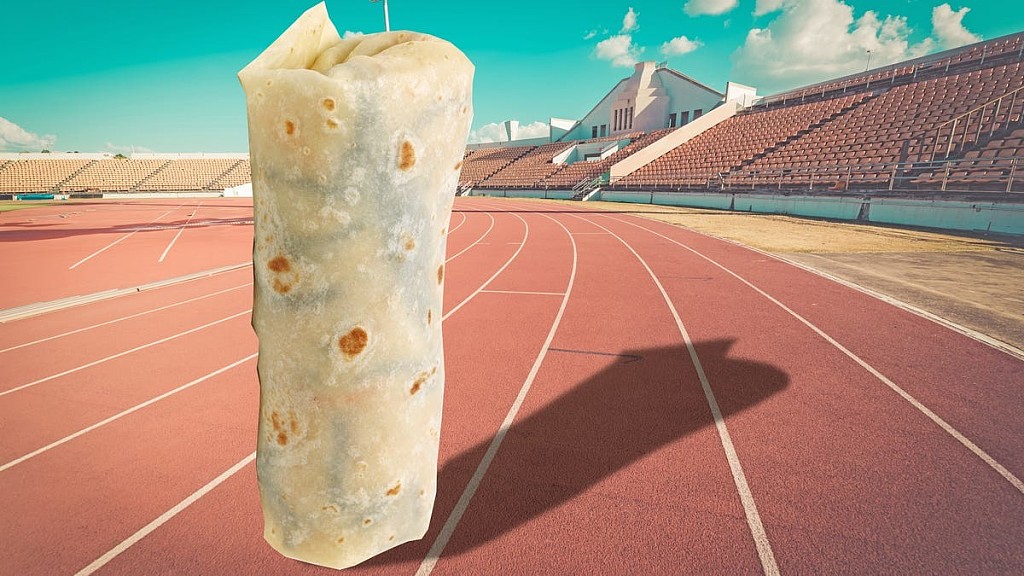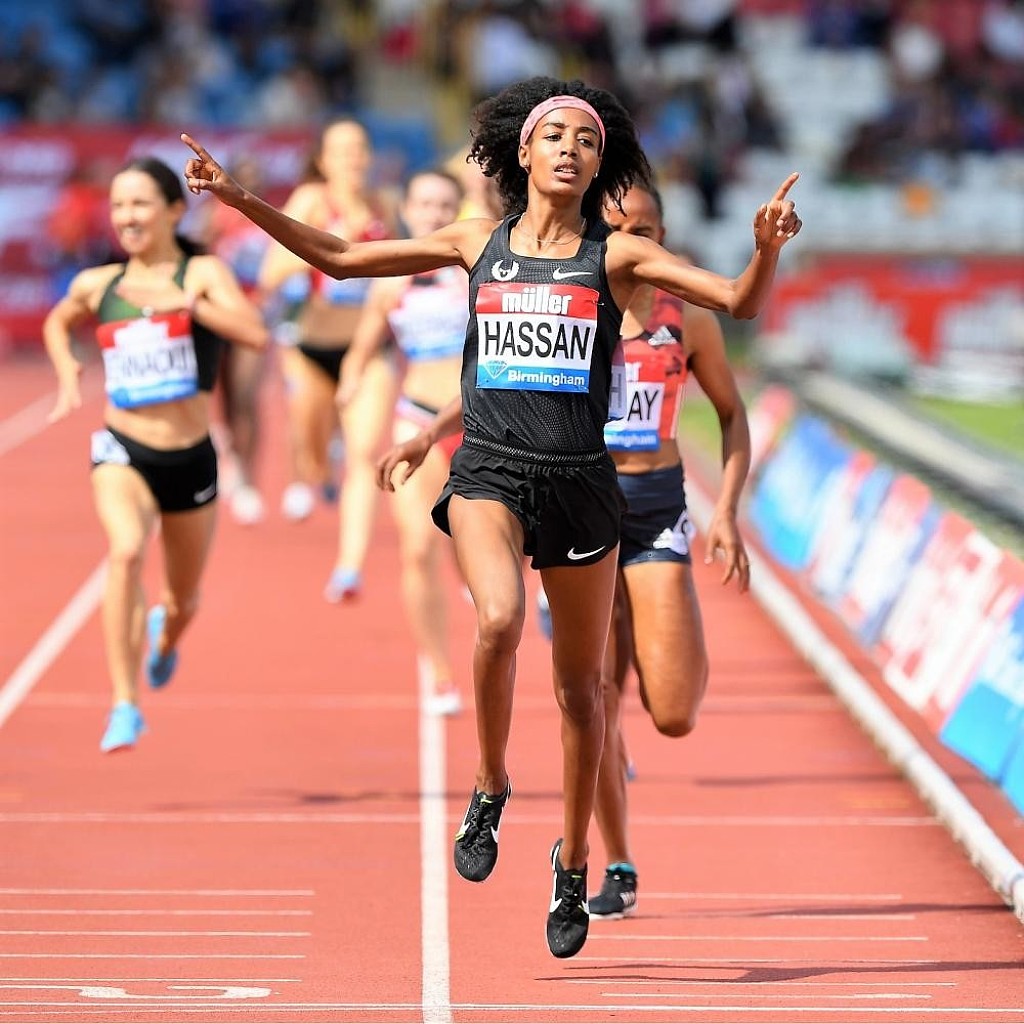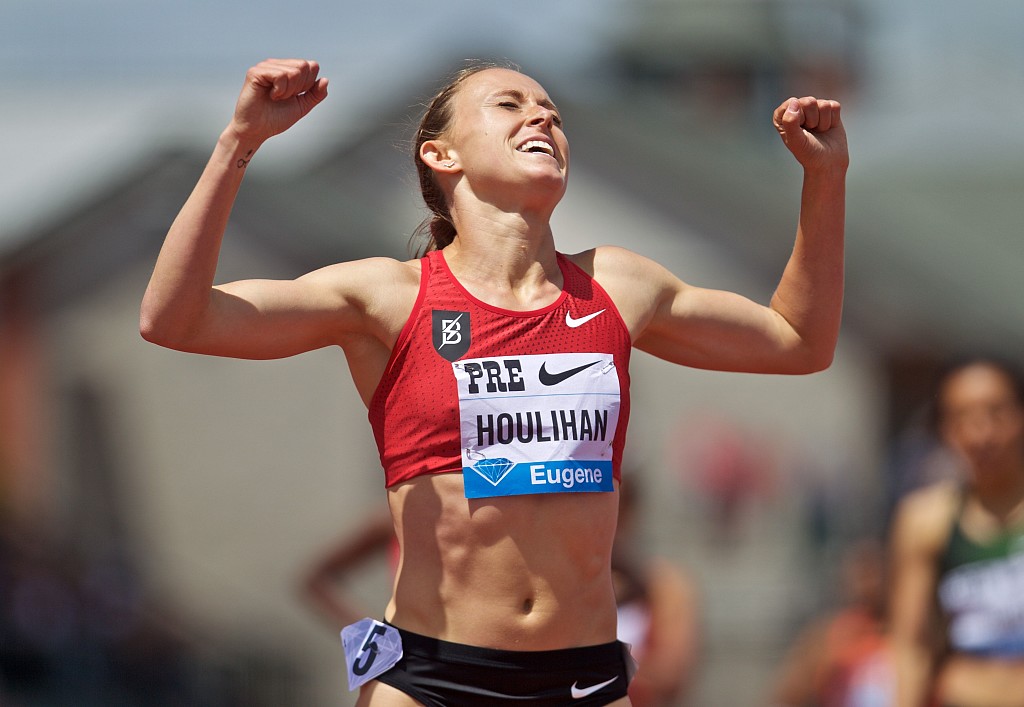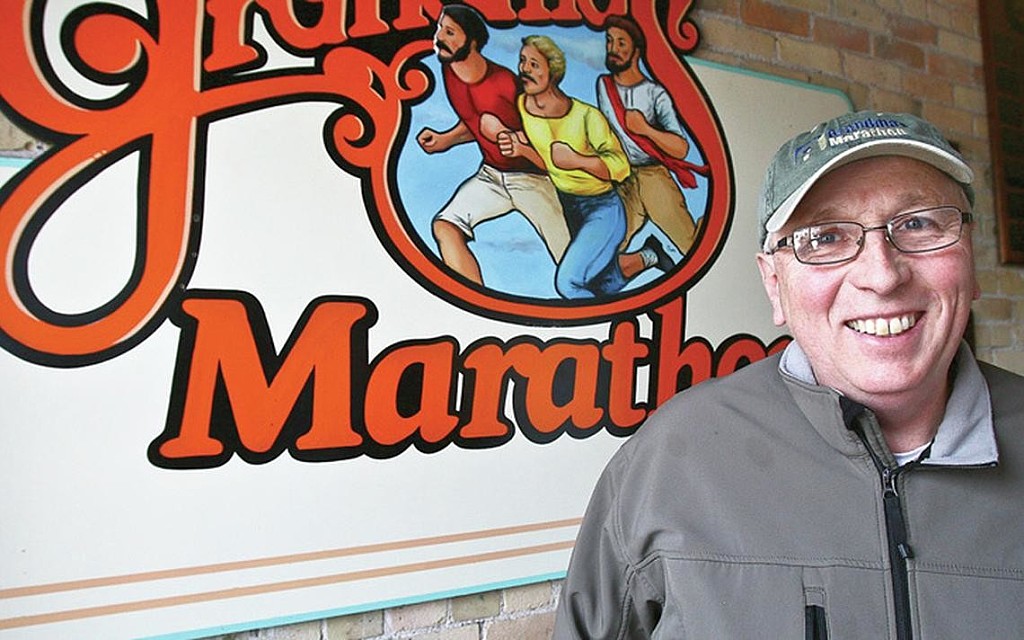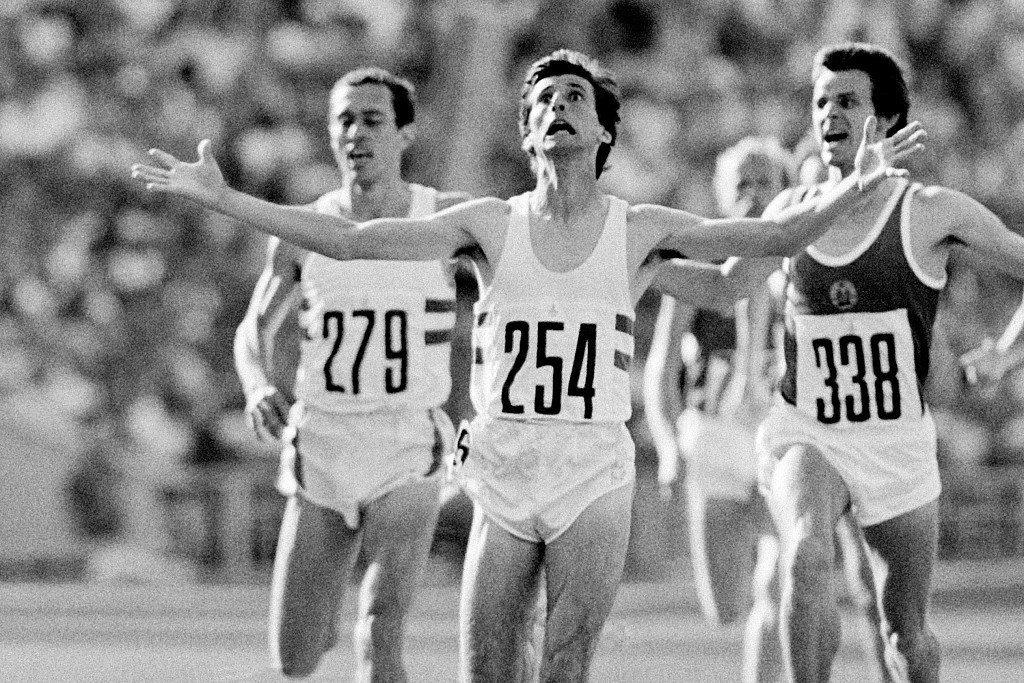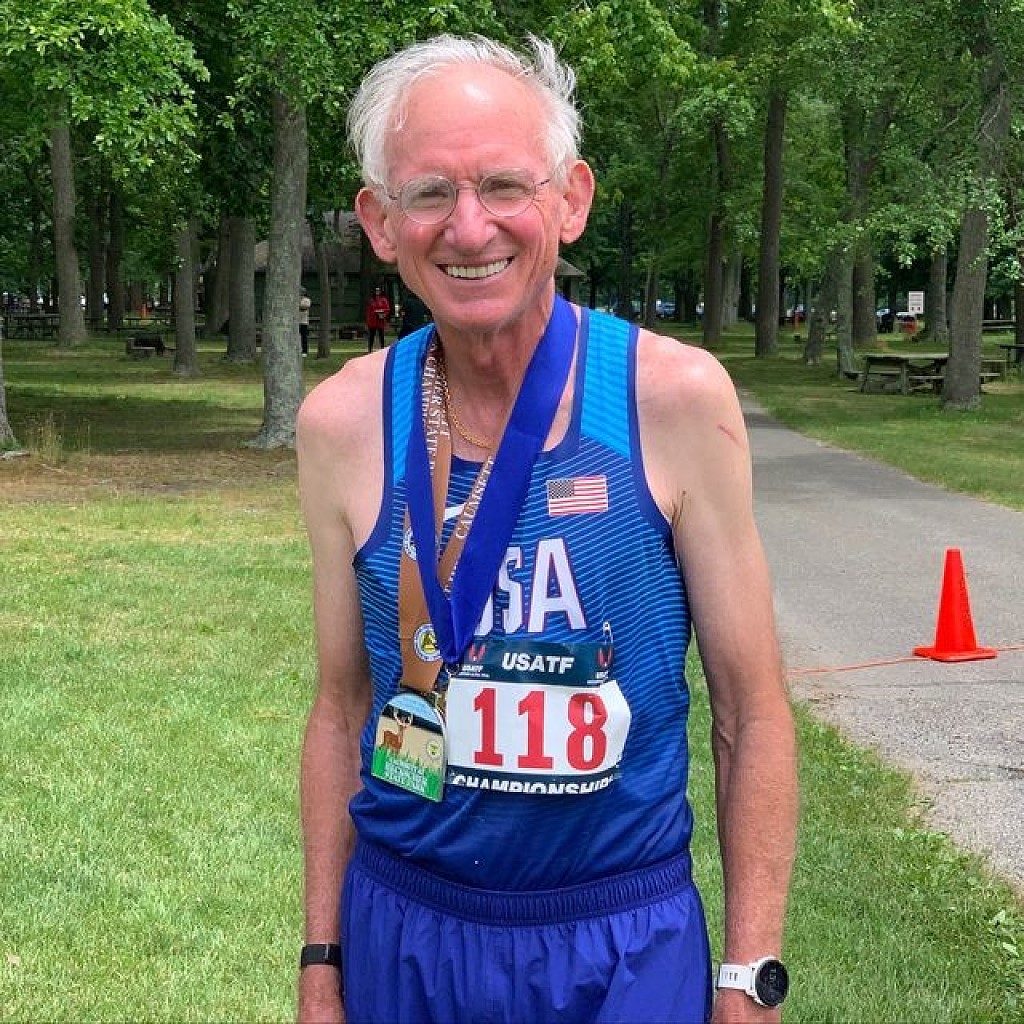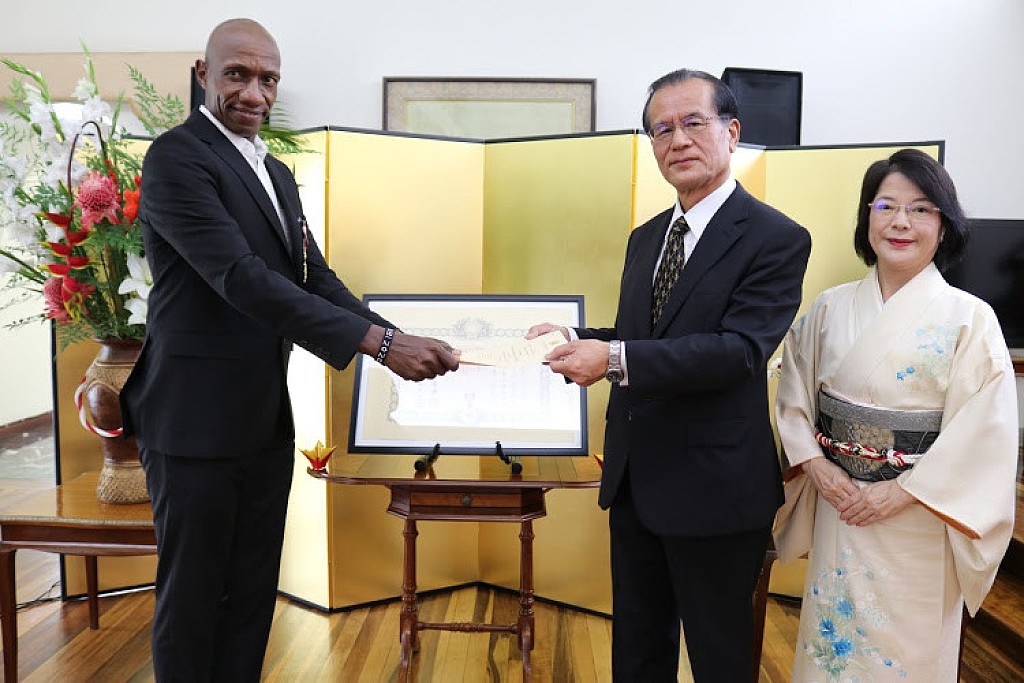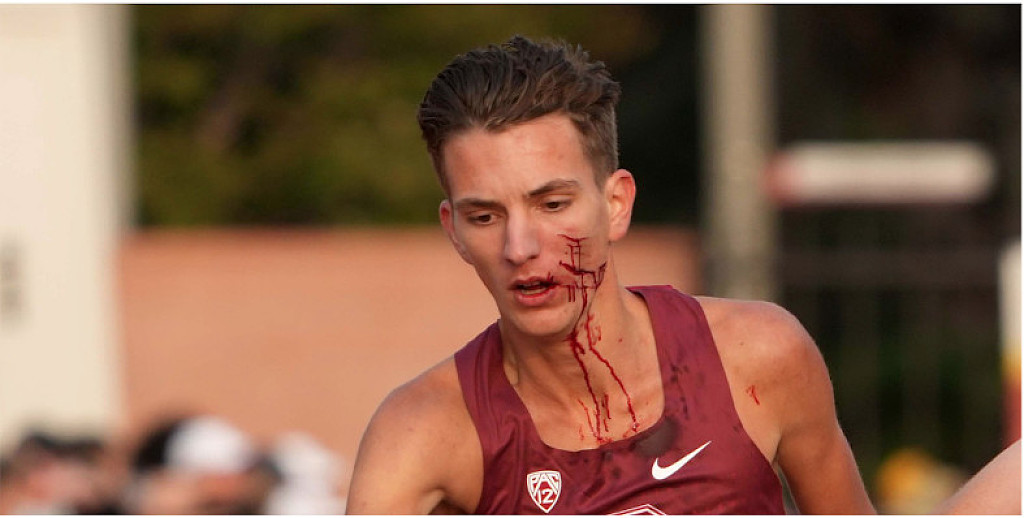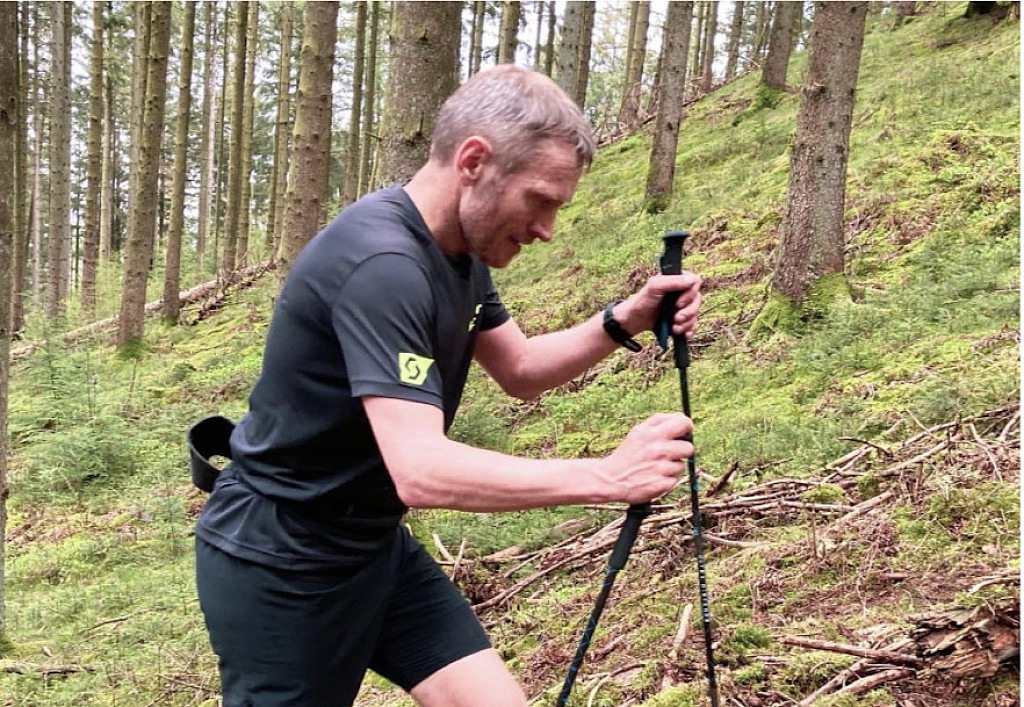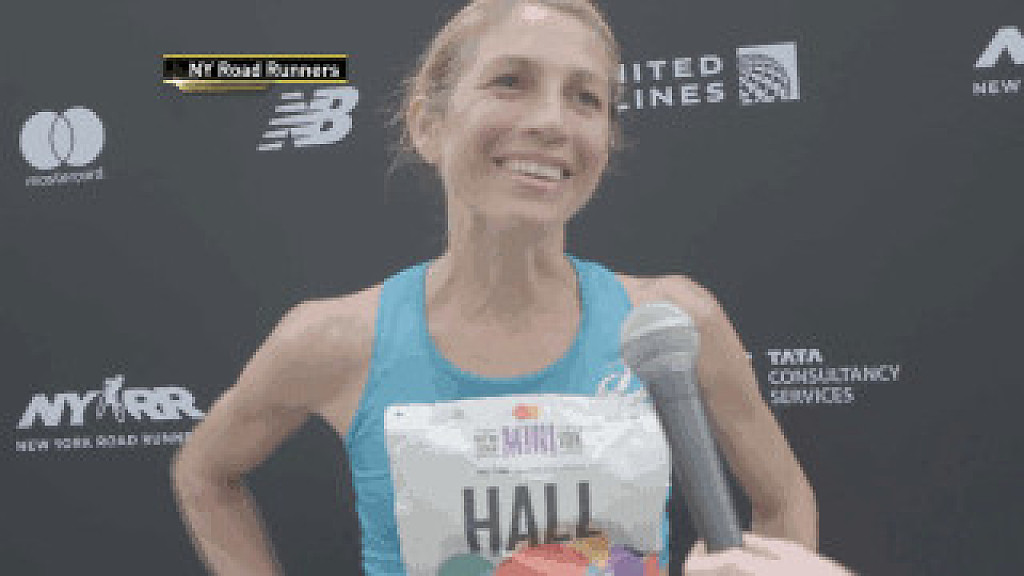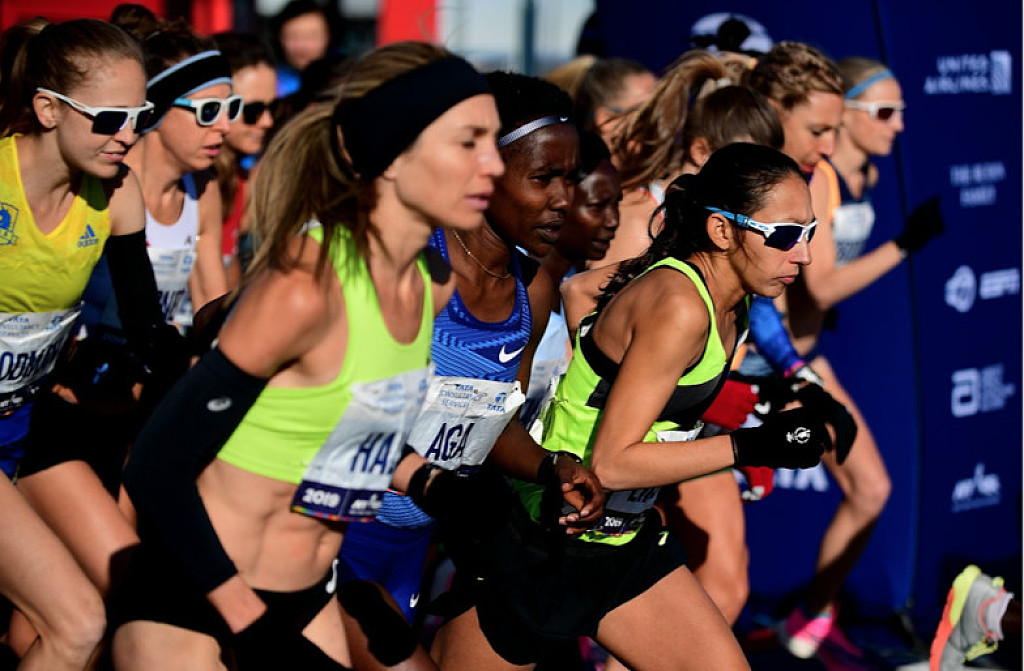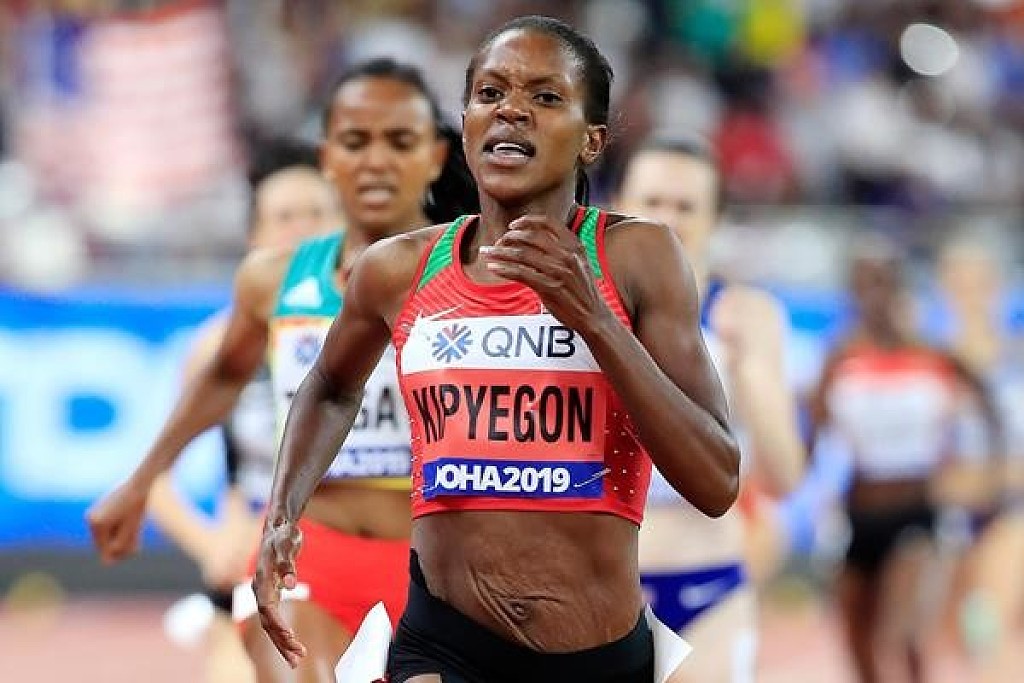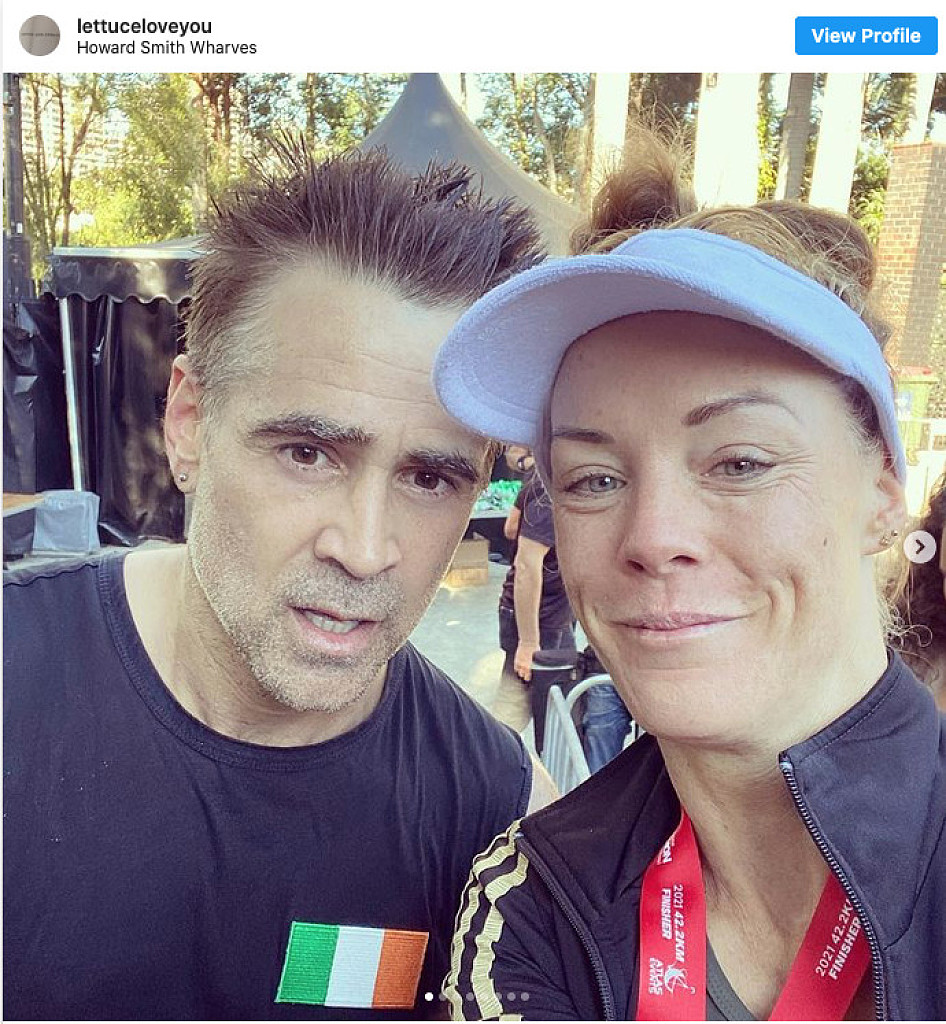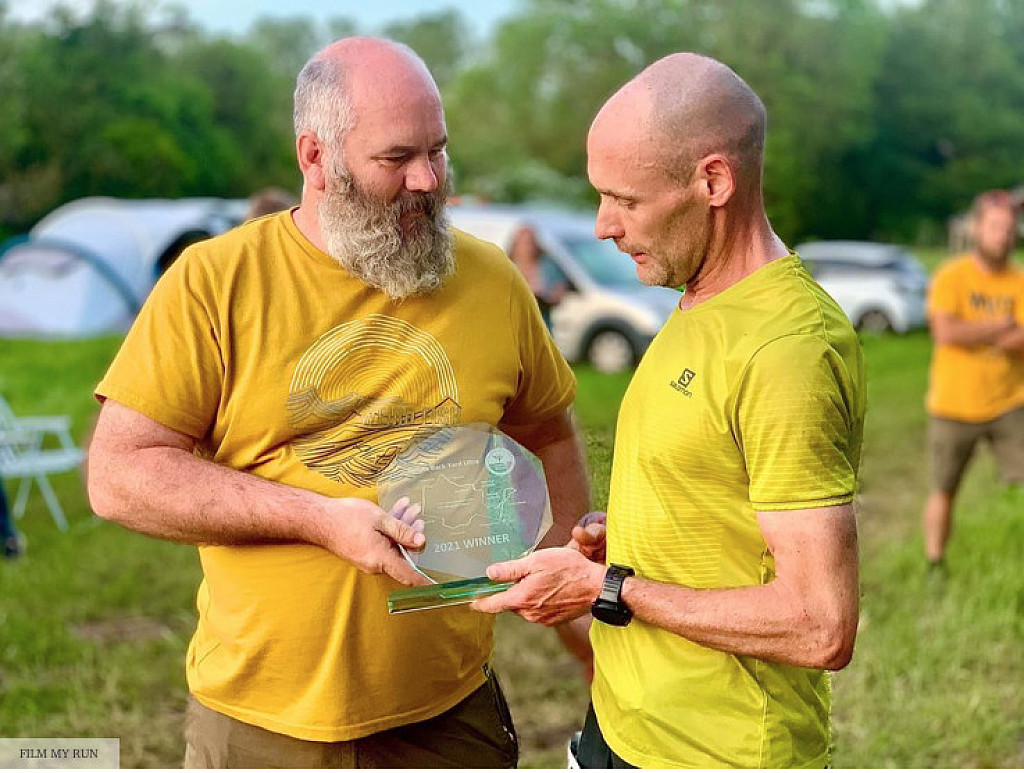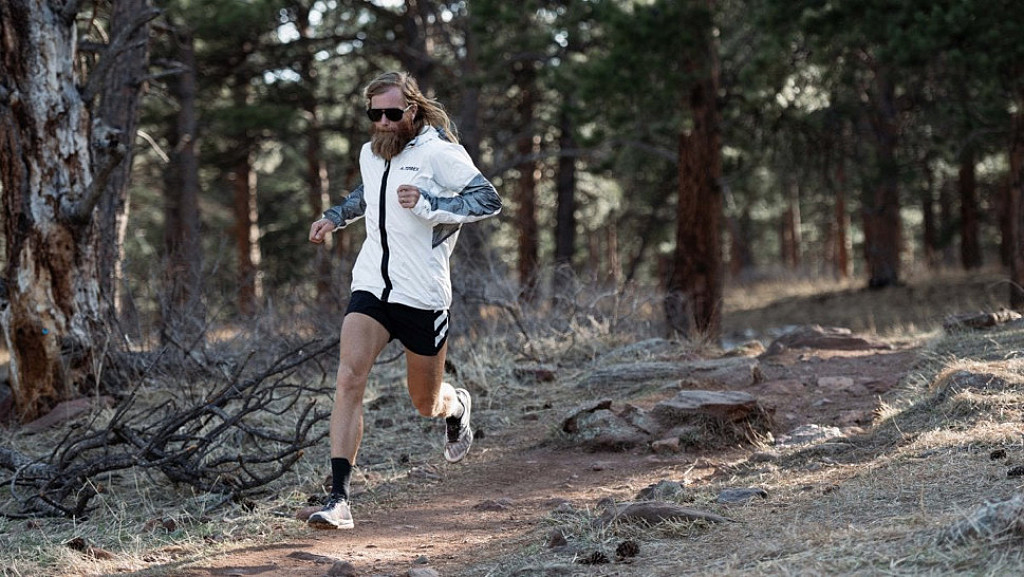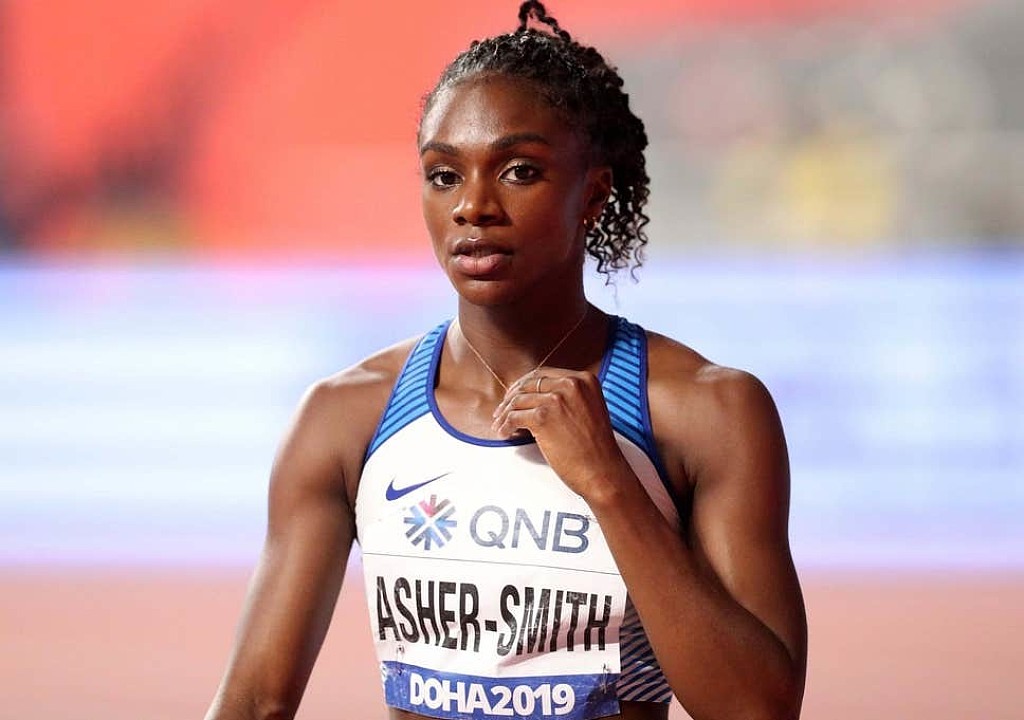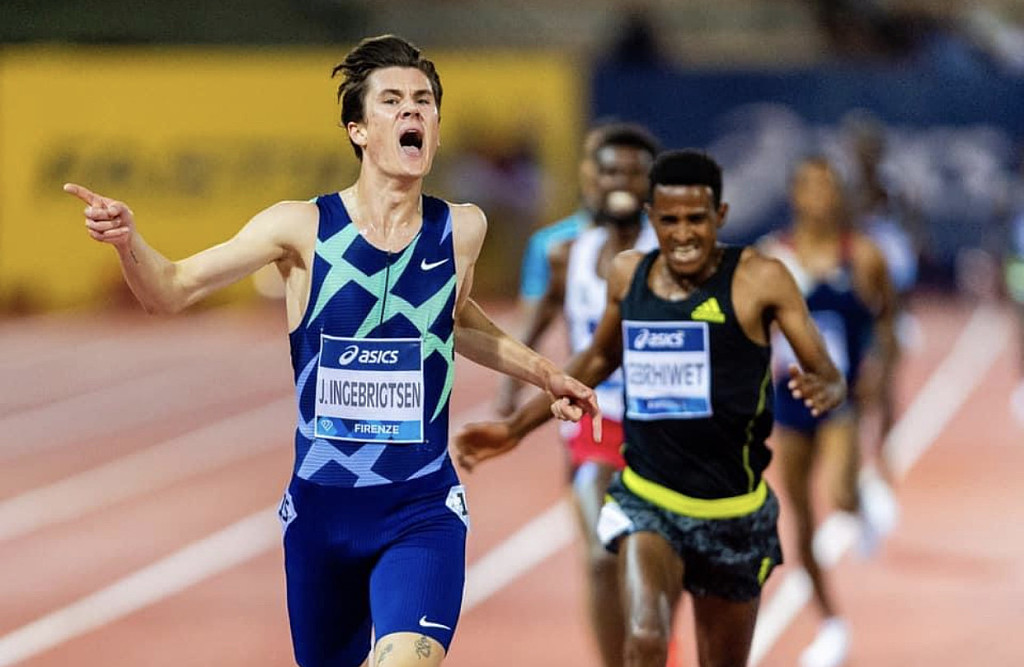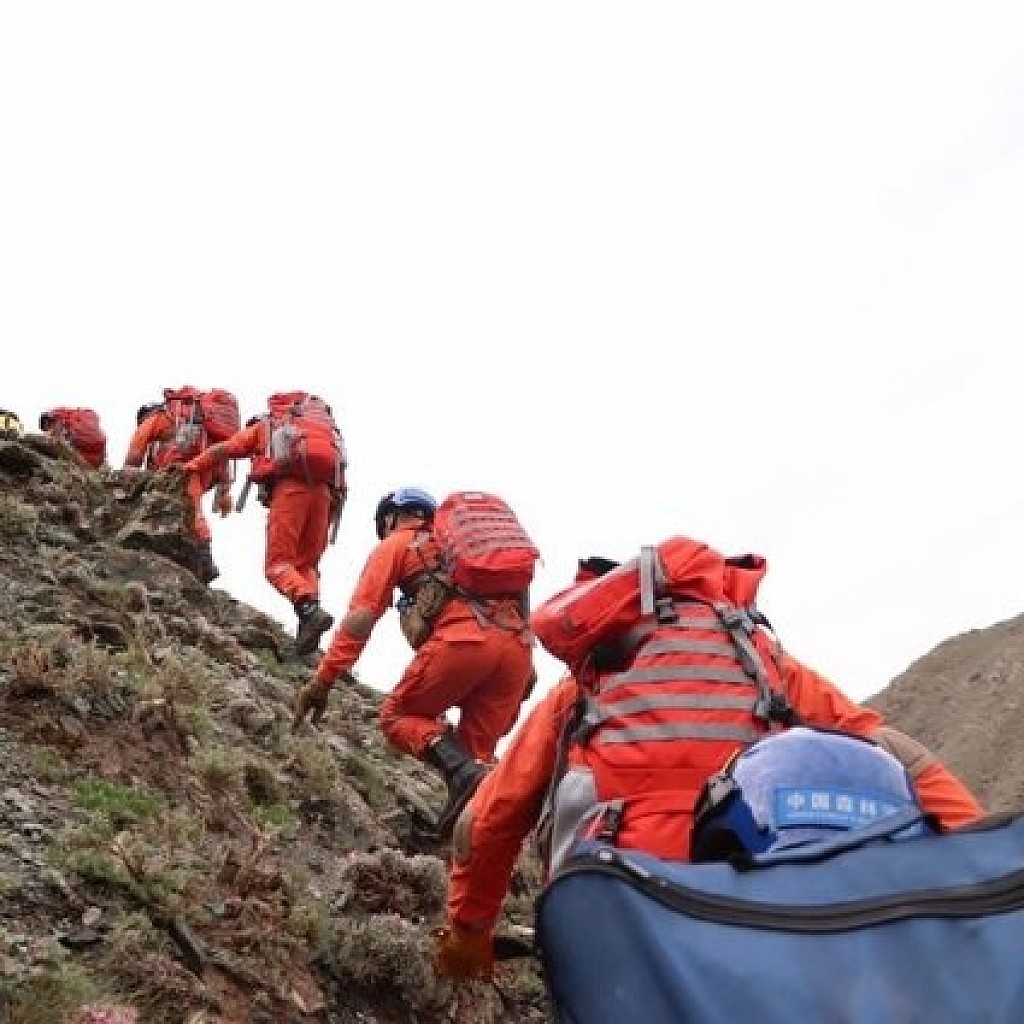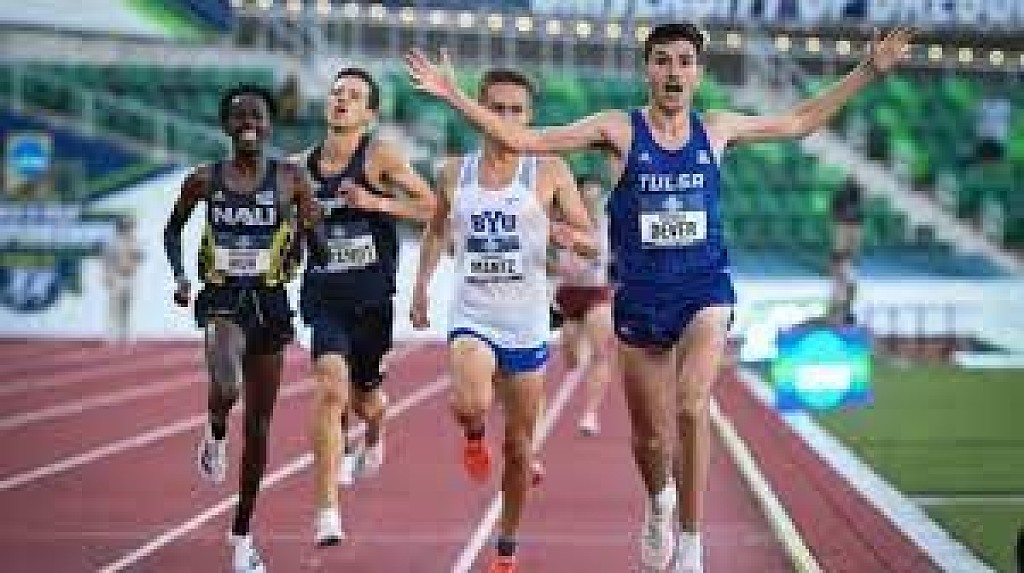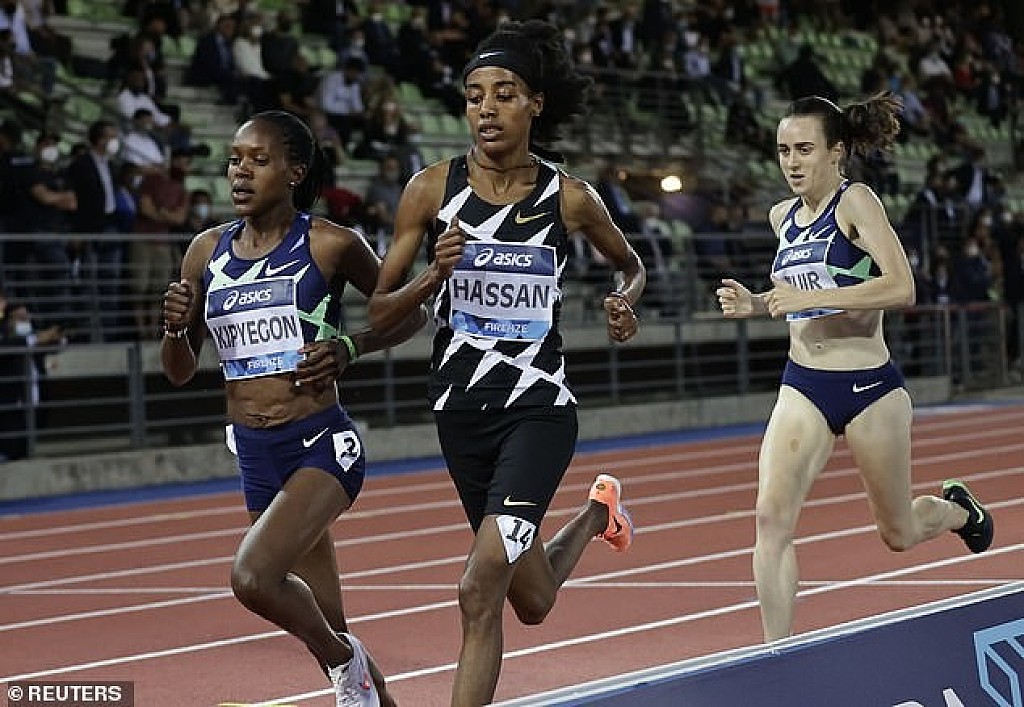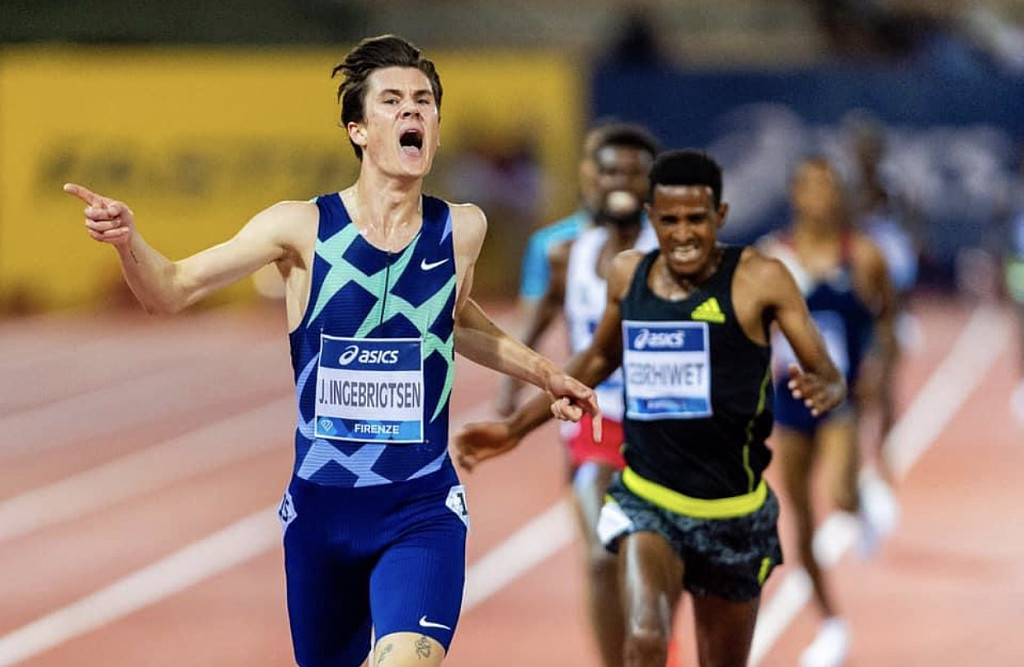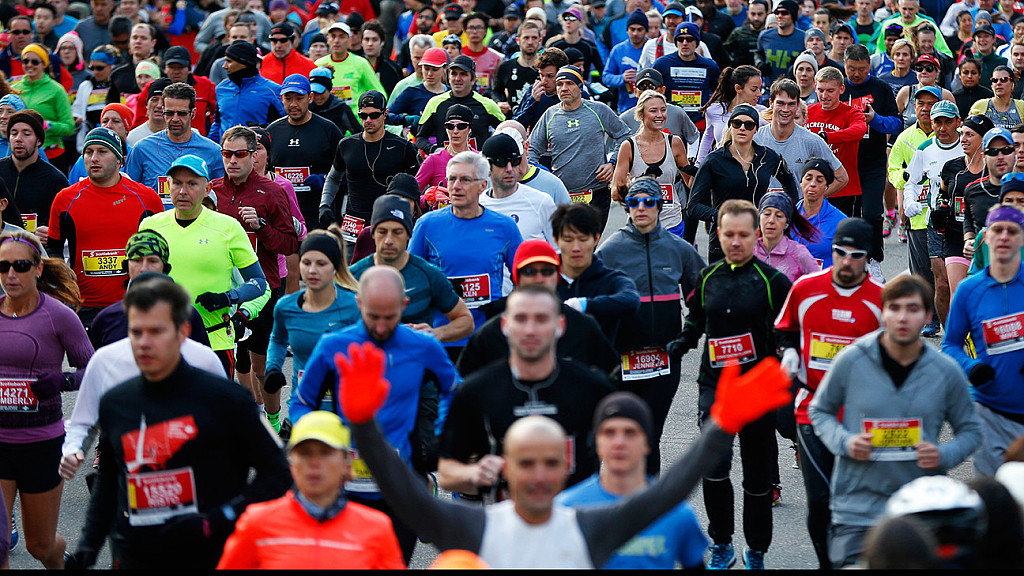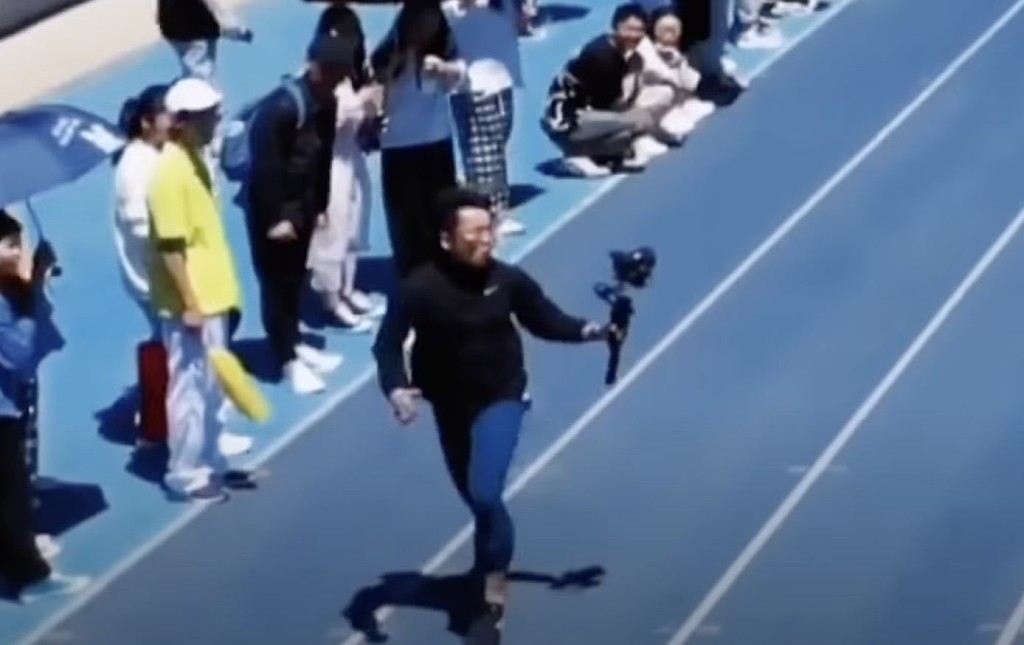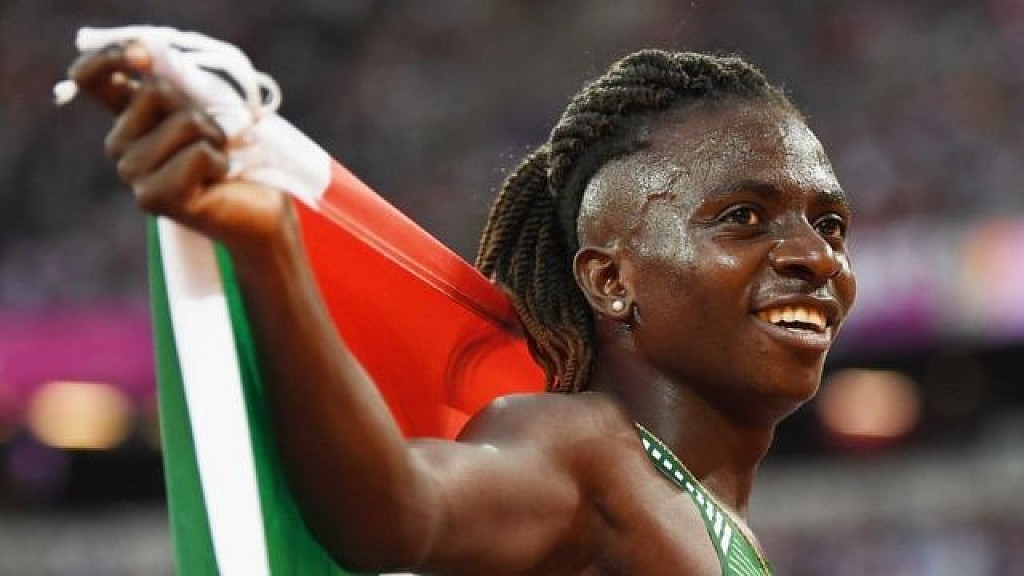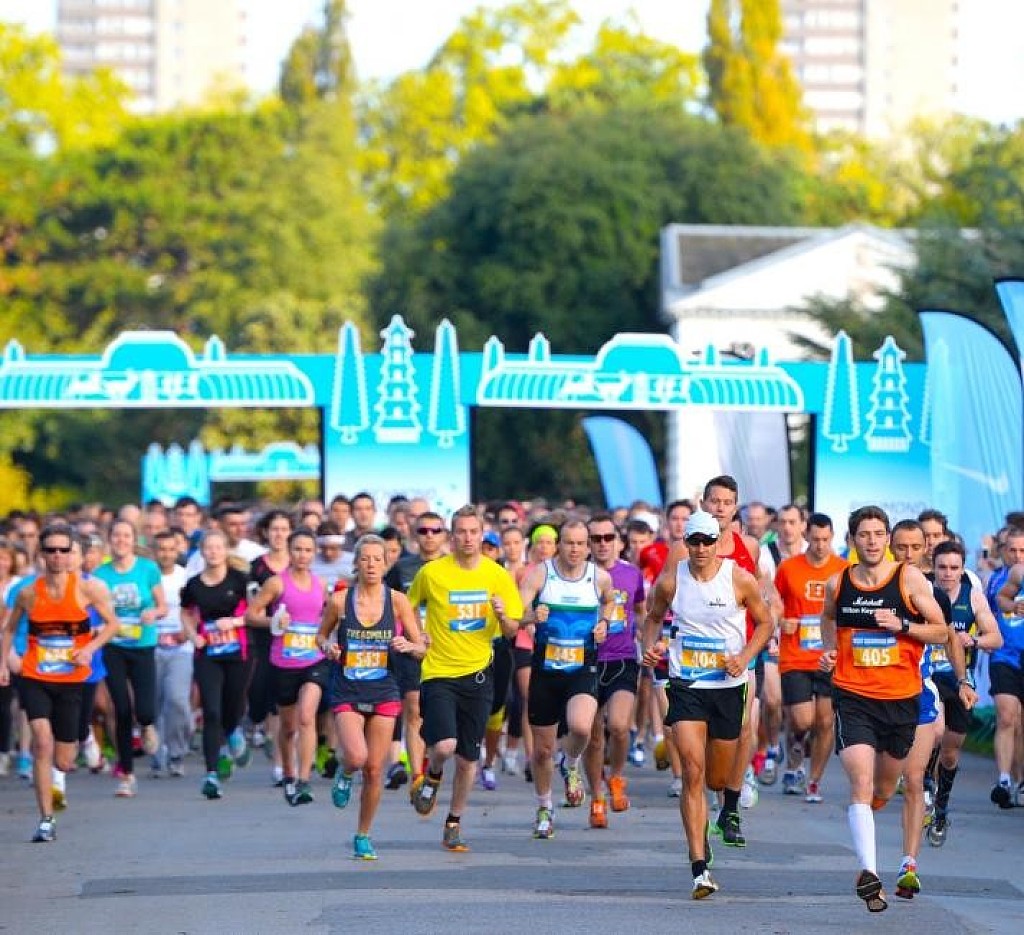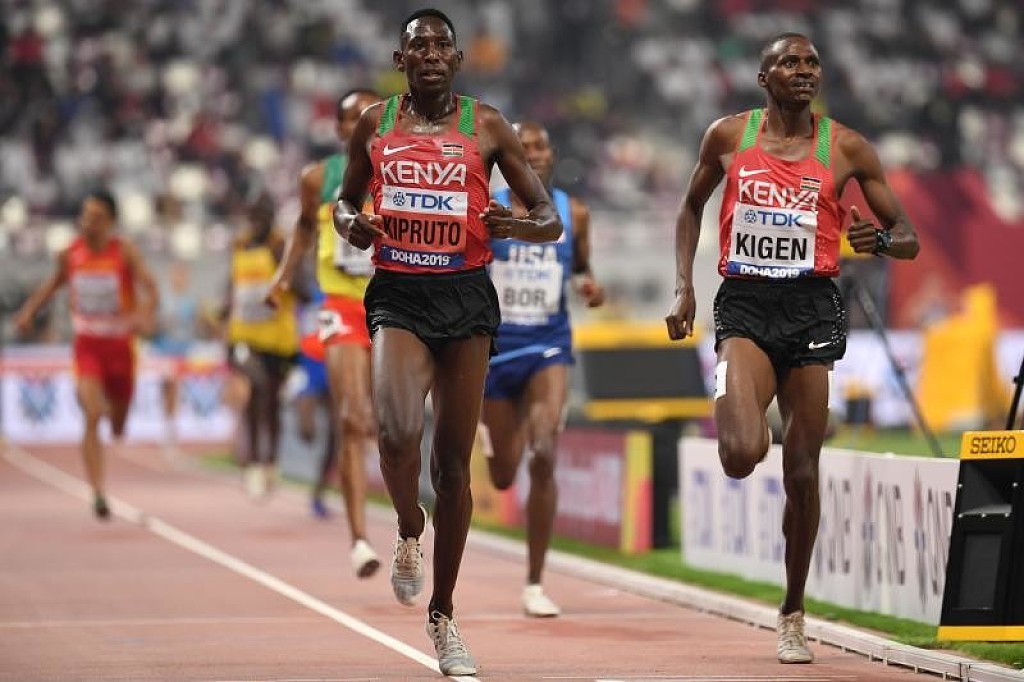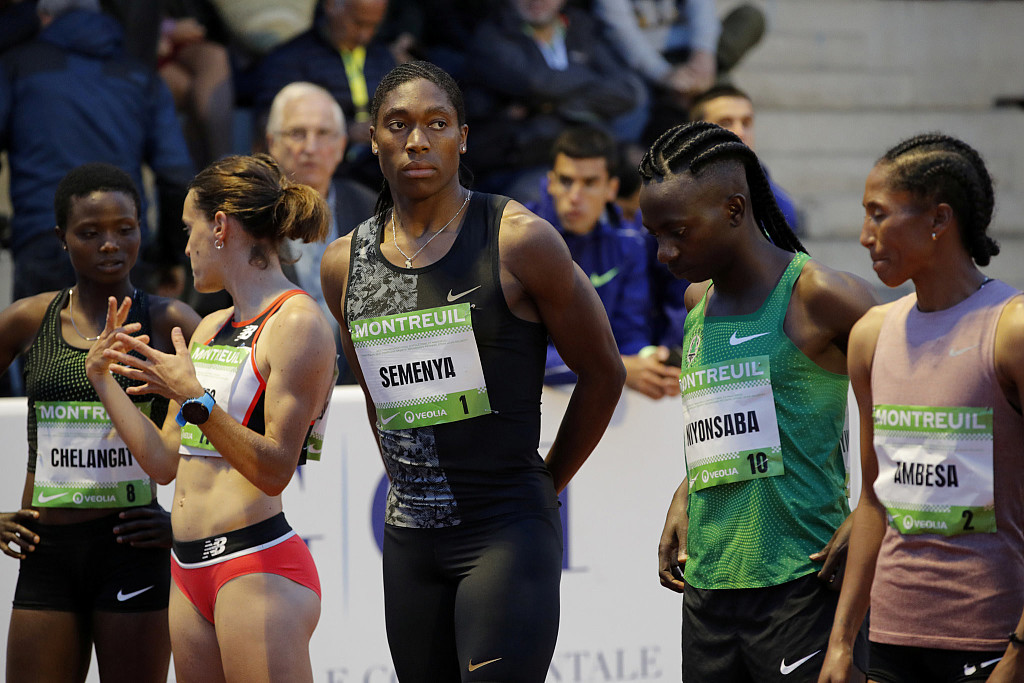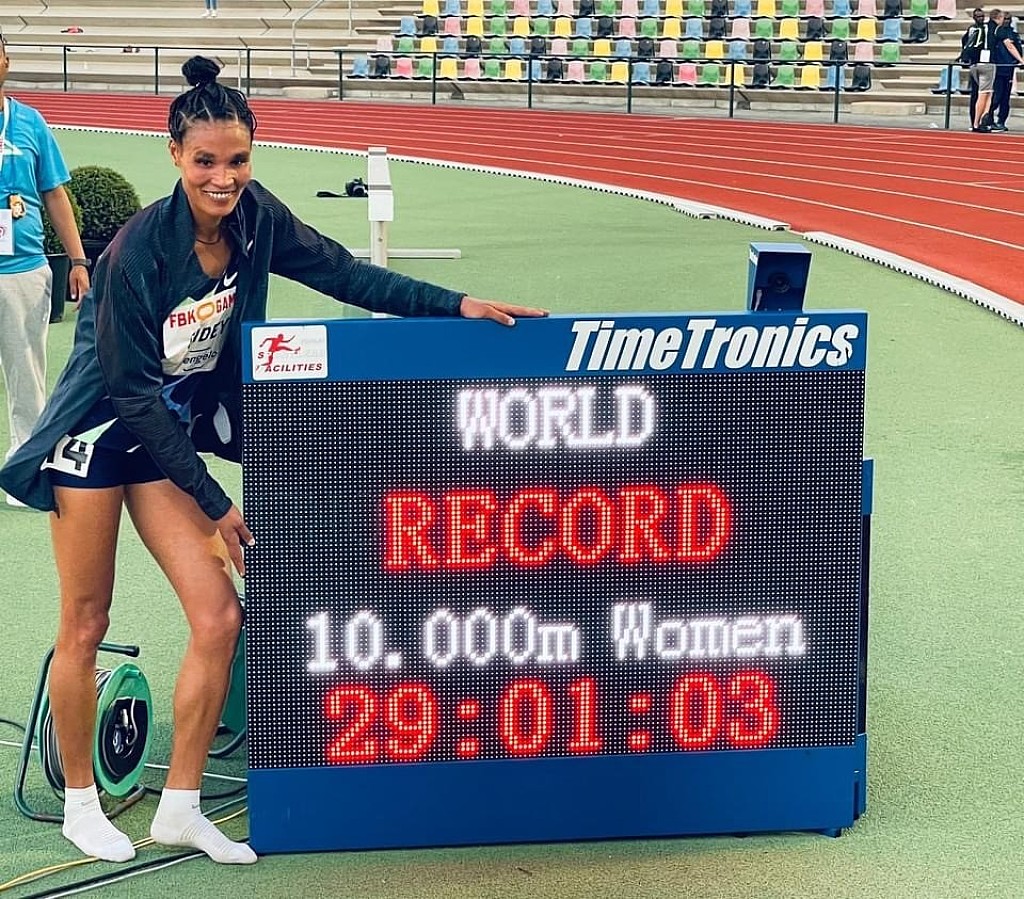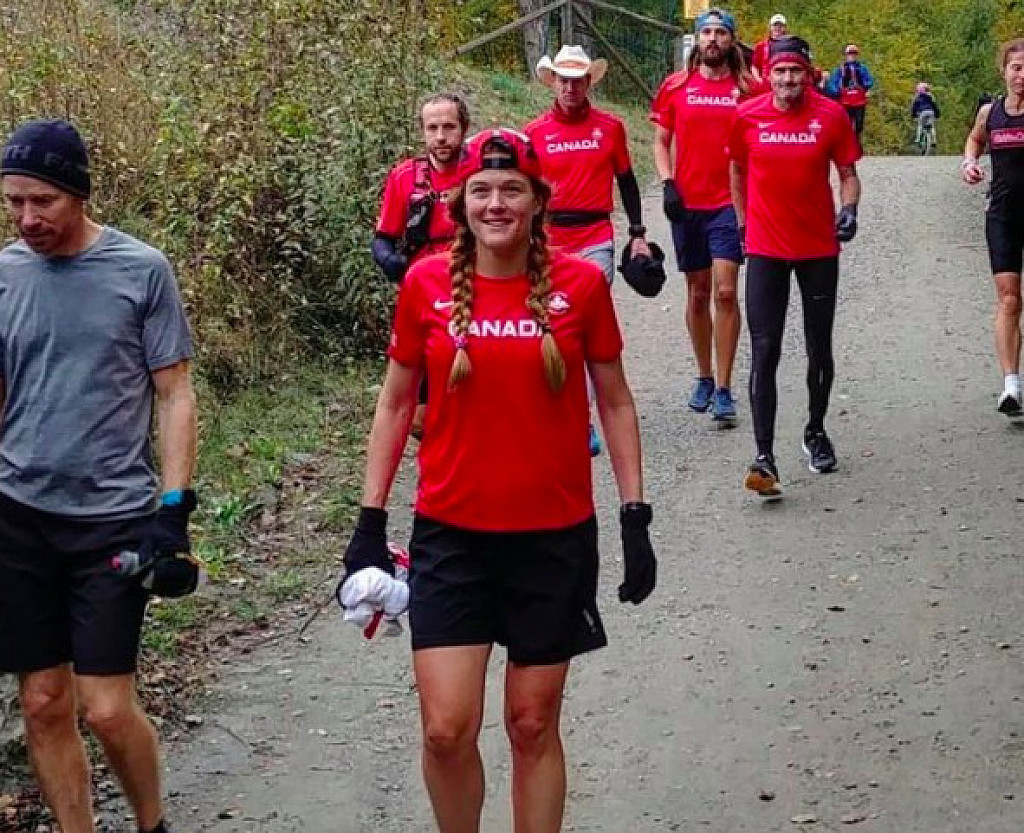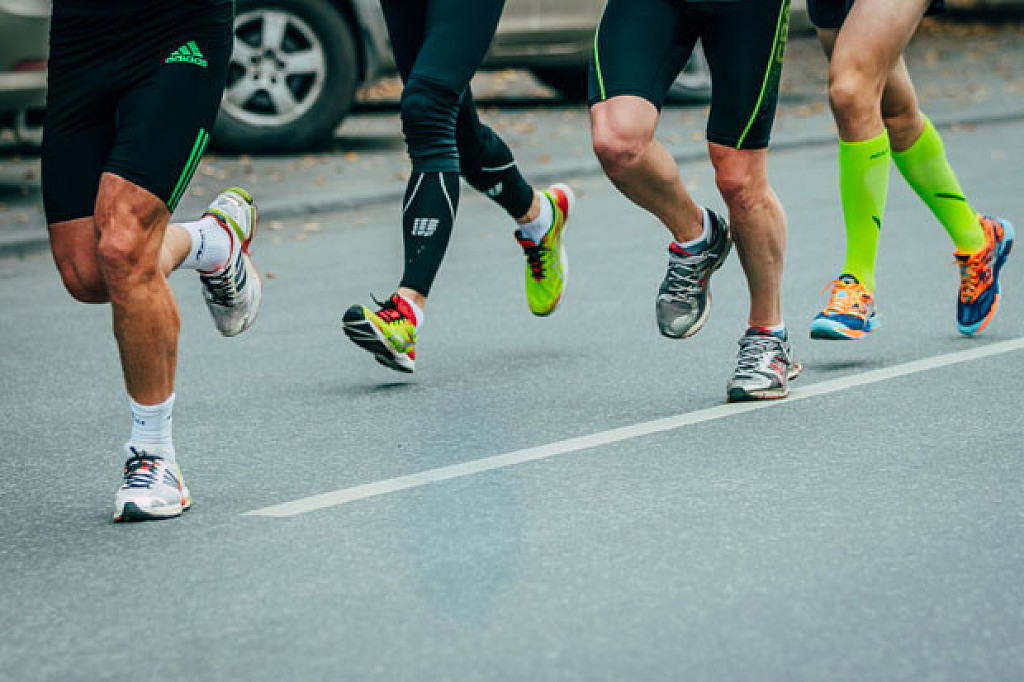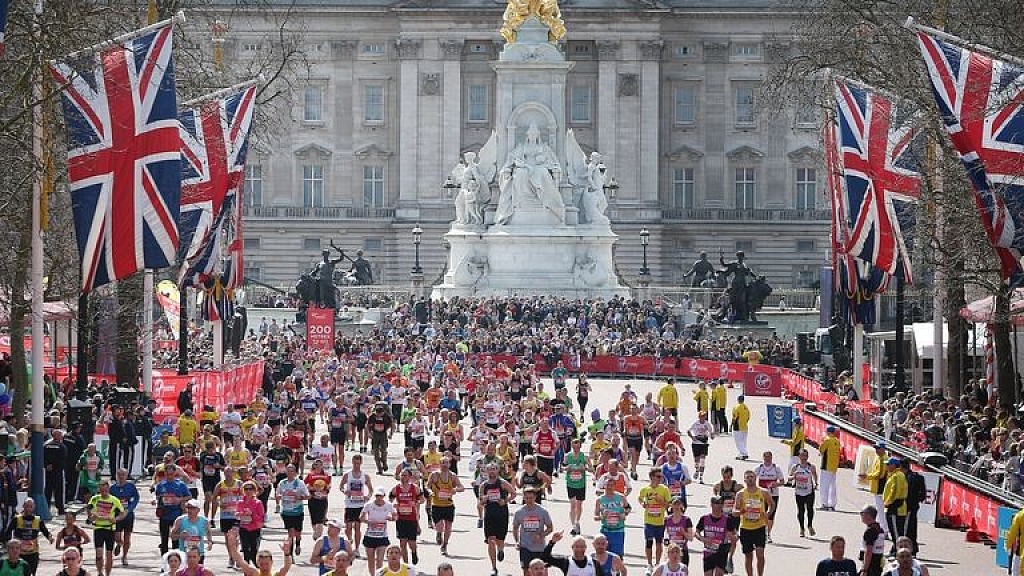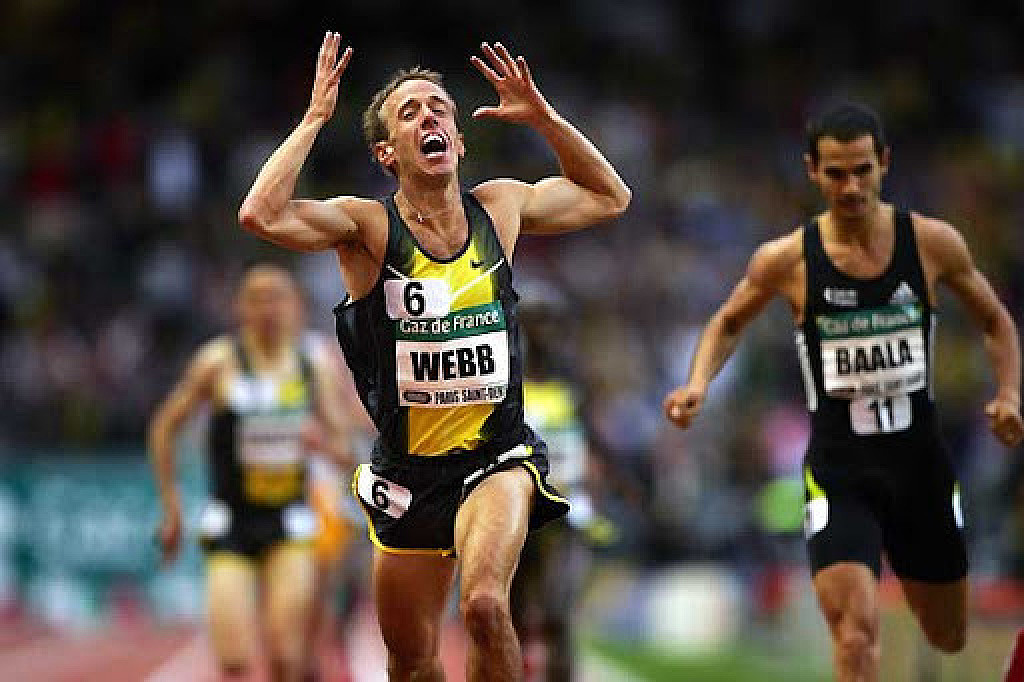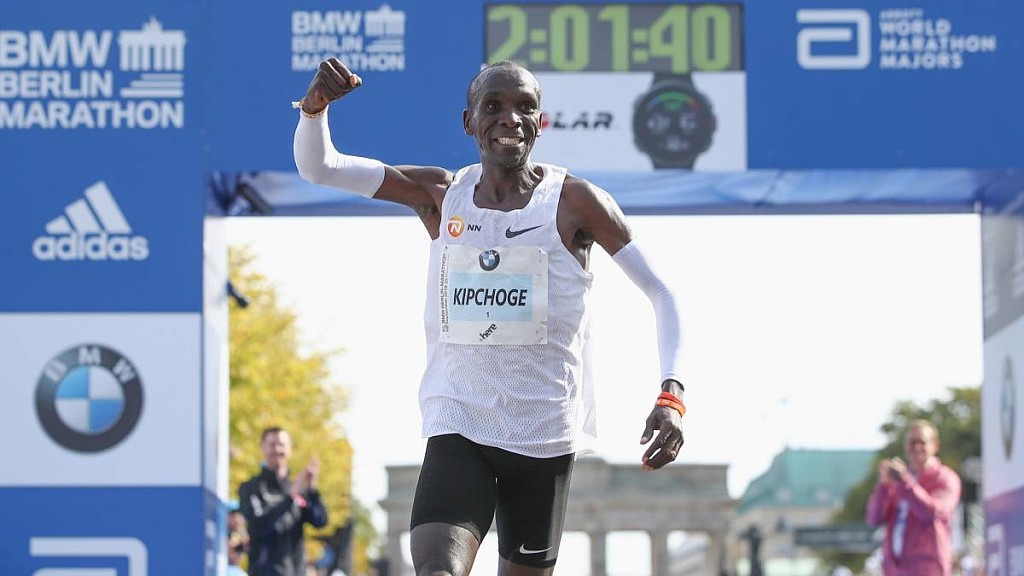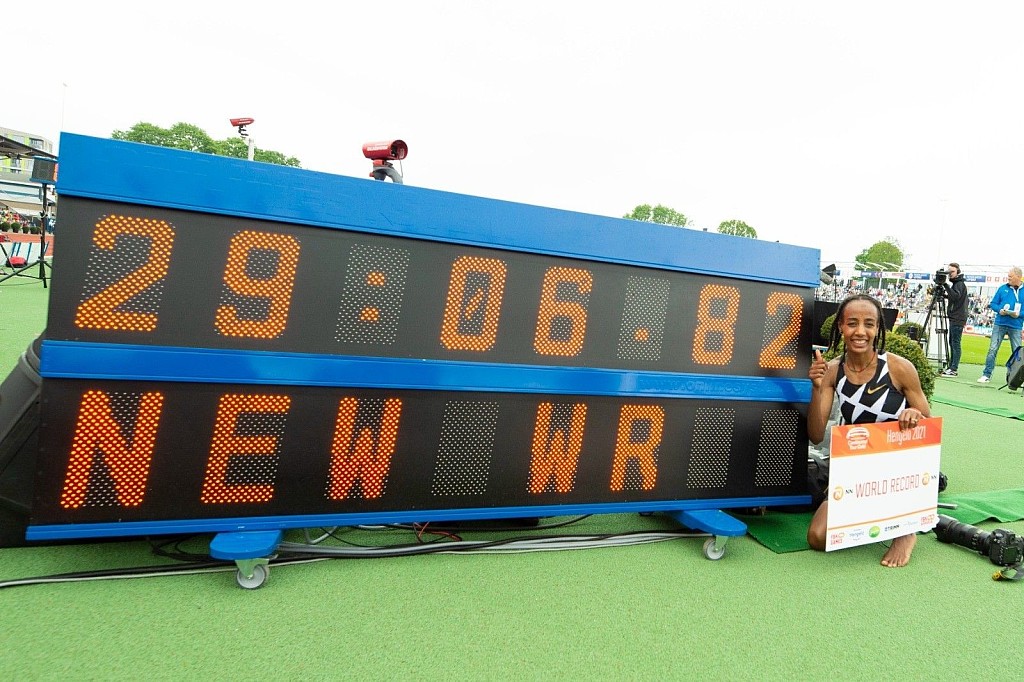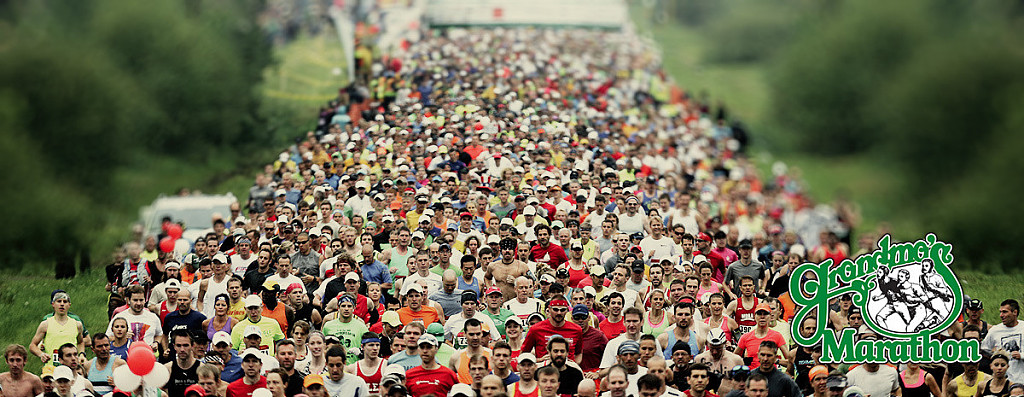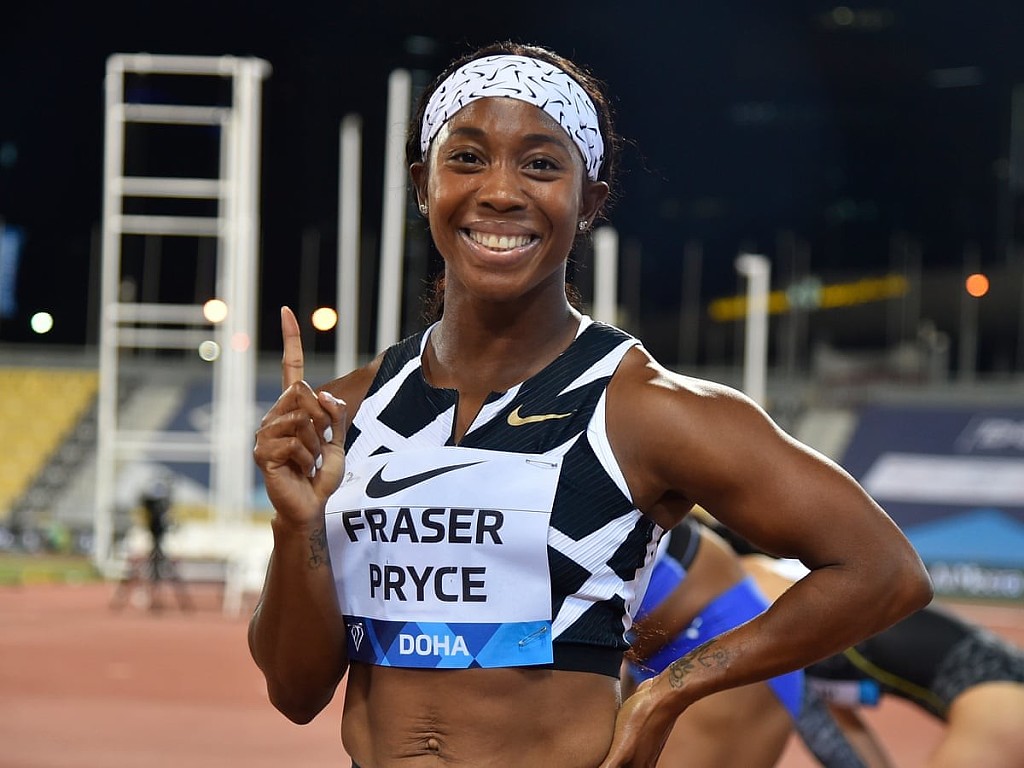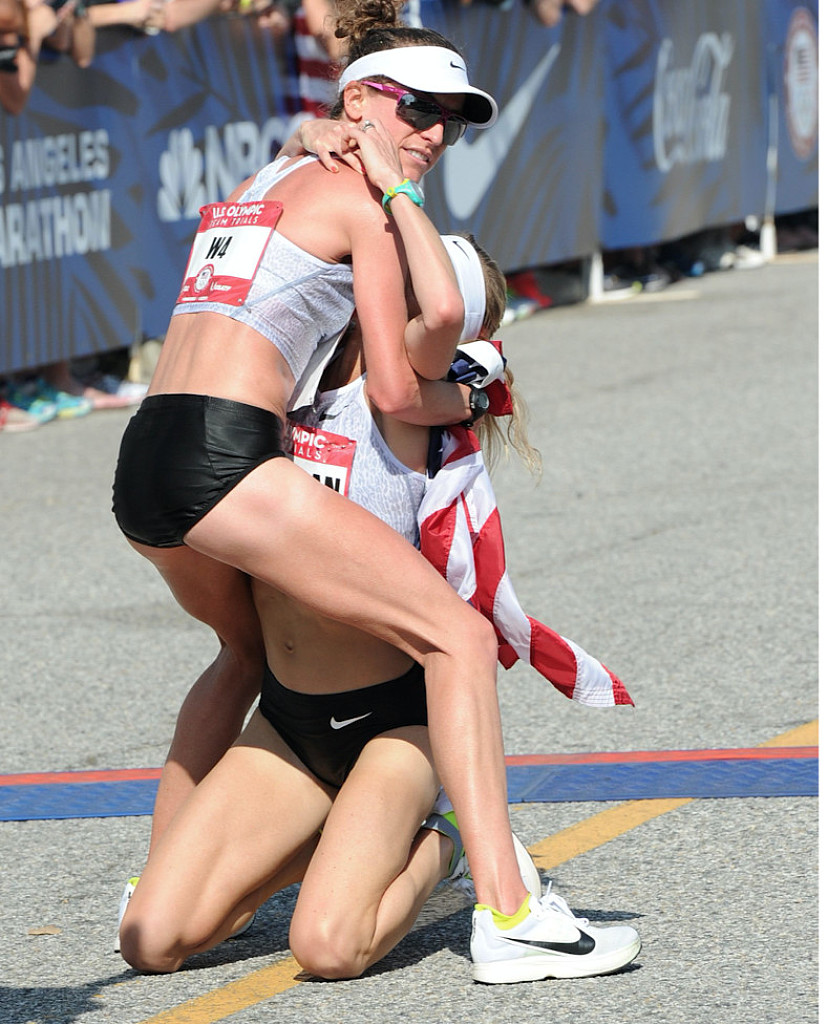Running News Daily
Running News Daily is edited by Bob Anderson in Mountain View, California USA and team in Thika Kenya, La Piedad Mexico, Bend Oregon, Chandler Arizona and Monforte da Beira Portugal. Send your news items to bob@mybestruns.com Advertising opportunities available. Over one million readers and growing. Train the Kenyan Way at KATA Running Retreat Kenya. (Kenyan Athletics Training Academy) in Thika Kenya. Opening in june 2024 KATA Running retreat Portugal. Learn more about Bob Anderson, MBR publisher and KATA director/owner, take a look at A Long Run the movie covering Bob's 50 race challenge.
Index to Daily Posts · Sign Up For Updates · Run The World Feed
Rengeruk and Obiri claim Tokyo 5000m places at Kenyan Championships
Lilian Kasait Rengeruk and Hellen Obiri secured their Tokyo Olympic Games places by finishing in the top two of a women's 5000m final which saw four women dip under 15 minutes at the Kenyan Championships in Nairobi on Thursday (17).
On the first day of action at the Kasarani Stadium, the session got under way with Rengeruk running 14:52.18 for victory as a total of seven athletes finished under the Olympic qualifying standard of 15:10.00.
A group of eight had remained together until the pack approached the final lap, when five athletes – led by Rengeruk and Obiri – started to move away. Rengeruk picked up the pace with Obiri in pursuit, but the 2017 world cross country bronze medallist managed to hold off two-time world 5000m champion Obiri down the home straight. Obiri finished second in 14:52.51.
Two-time world 10,000m bronze medallist Agnes Tirop was just behind them, clocking 14:53.91, and world 5000m silver medallist Margaret Chelimo Kipkemboi also went sub-15:00 with 14:58.61 to finish fourth. World U20 champion Beatrice Chebet was fifth in 15:01.86.
“I didn’t expect to win. I thank God for victory and good health,” Rengeruk told Athletics Kenya. “The race was tactical. I didn’t have many races (in the lead-up) but my preparation was uninterrupted. My wish is to work as a team in Tokyo to ensure we deliver podium finishes.”
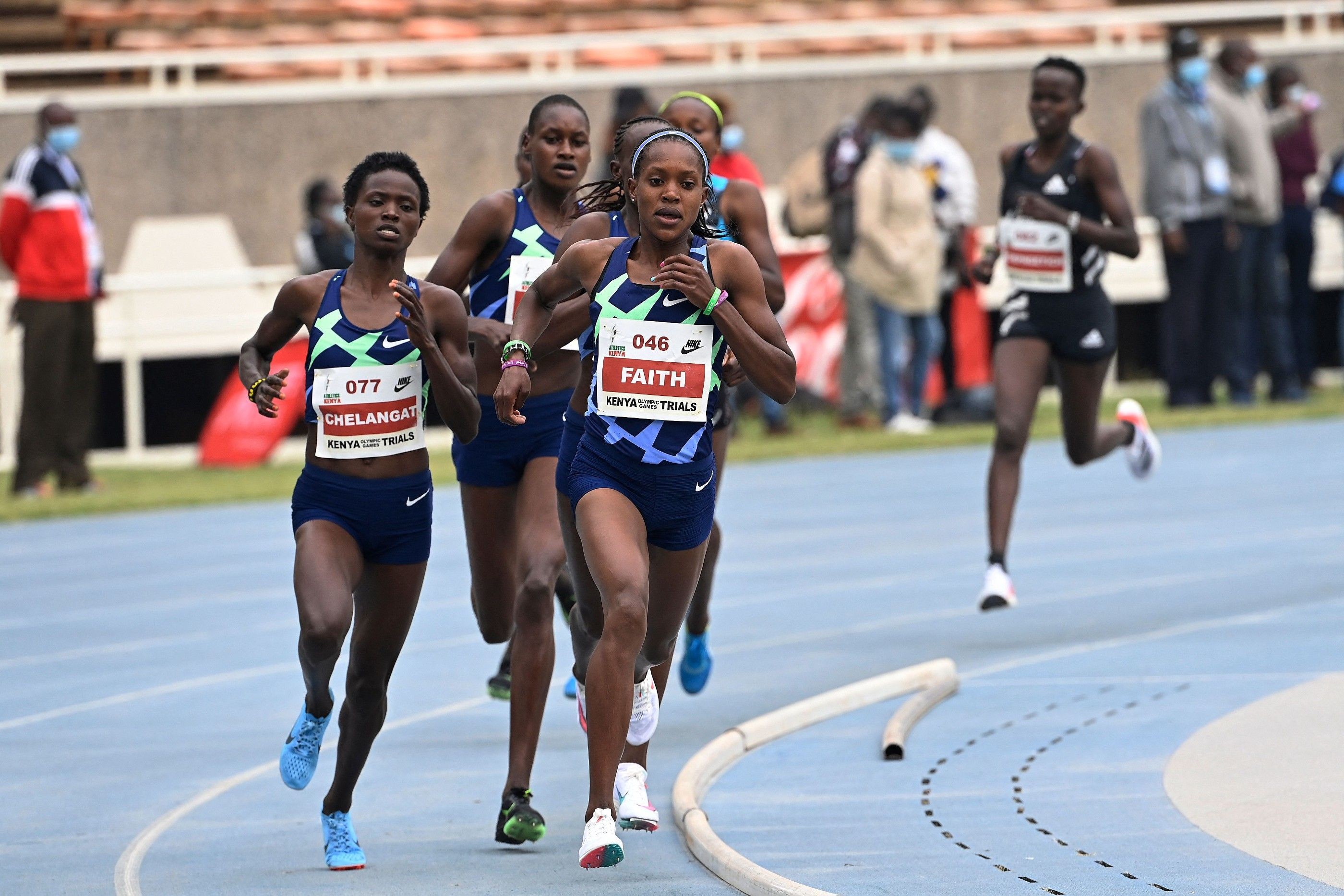
Joining her in Japan will be Obiri, who made her half marathon debut with a 1:04:51 performance in Istanbul in April and in Nairobi explained how she may switch her focus to road races after this year.
“I’m satisfied with my second place finish, what matters most was to finish in the top two,” she said. “I will go back and work hard in training to ensure I do well in Tokyo.”
Kipyegon wins 1500m
Faith Kipyegon remains on track for an Olympic title defence as she comfortably won the 1500m trials race in 4:02.10, with African champion Winny Chebet also claiming a team place thanks to her runner-up finish and Edinah Jebitok placing third.
Faith Kipyegon on her way to 1500m victory at the Kenyan Championships (© AFP / Getty Images)
“My focus is to defend my Olympic title in Tokyo,” said Kipyegon, also the 2017 world gold medallist. “It was a really good race here, which I really wanted to win. I know I will meet many good athletes in Tokyo but I have prepared really well.”
The men’s 100m saw Ferdinand Omanyala improve on the Kenyan record with a time of 10.02 (1.5m/s), with Mark Otieno second in 10.05 to also achieve the Olympic qualifying time.
(06/17/2021) ⚡AMPby World Athletics
Tokyo 2020 Olympic Games
Fifty-six years after having organized the Olympic Games, the Japanese capital will be hosting a Summer edition for the second time, originally scheduled from July 24 to August 9, 2020, the games were postponed due to coronavirus outbreak, the postponed Tokyo Olympics will be held from July 23 to August 8 in 2021, according to the International Olympic Committee decision. ...
more...Whoop Data Shows These 2 Simple Habits Can Speed Up Recovery After a Tough Run
Two specific modalities had the biggest effects on important recovery metrics for WHOOP users.
Over the past few years, many athletes have ditched the go-go-go mentality for one that prioritizes recovering just as hard as you train. Without recovery, runners now know, your body can’t adapt to the work you’re putting in. But while other aspects of training—splits, volume, intensity—are more easily measured, there hasn’t really been a clear way to determine how all that time shivering in an ice bath or rubbing CBD balms into sore muscles is actually affecting your body’s recovery.
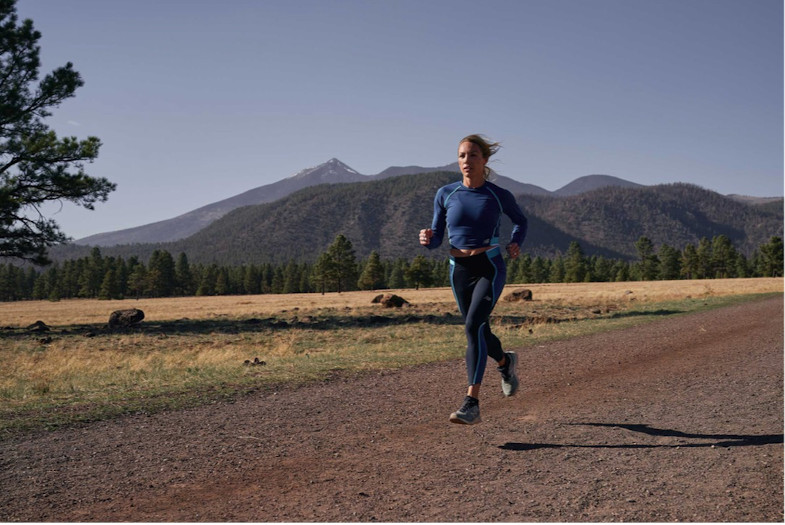
Now, though, there’s some insight from Whoop, the activity tracker that quantifies recovery. Whoop researchers analyzed data from members who recorded 30 or more runs between February 1, 2021 to April 30, 2021 in the Whoop Journal, a customizable feature that allows members to log more than 40 specific behaviors that may impact performance on a daily basis. They looked at over 450,000 entries across 18 different practices and substances, from acupuncture and cryotherapy to CBD and magnesium, to determine which ones have the biggest effect on recovery.
The researchers found that melatonin use resulted in the largest average improvement on recovery scores, heart rate variability (HRV) and resting heart rate (RHR). Thirty-two percent of runners recorded using melatonin, making it the second highest recorded recovery modality after stretching.
Melatonin is a naturally produced hormone that tells your body when it’s time to hit the sheets. For those struggling with sleep, it’s become a popular supplement, too. But “a relationship and causal effect are two different things,” says W. Christopher Winter, M.D., president of Charlottesville Neurology and Sleep Medicine and author of The Sleep Solution.
Melatonin doesn’t actually put you to sleep, 2019 research published in the journal Frontiers in Endocrinology confirmed; it’s more about subtly shifting your circadian rhythm, or internal clock, so your body knows its time for bed—which may make you fall asleep easier. For example, melatonin reduced the amount of time it took people with sleep disorders to fall asleep by an average of seven minutes in a 2013 meta-analysis published in Plos One.
There’s also the placebo effect: “Sleeping pills, in general, tend to alleviate anxiety about sleep,” says Winter. “We can’t underestimate the power of belief when it comes to sleep quality.” That ritual aspect of taking a melatonin supplement every night may make you feel like you’re doing something to promote a better night of shuteye—which can actually lead to more Zzz’s. 

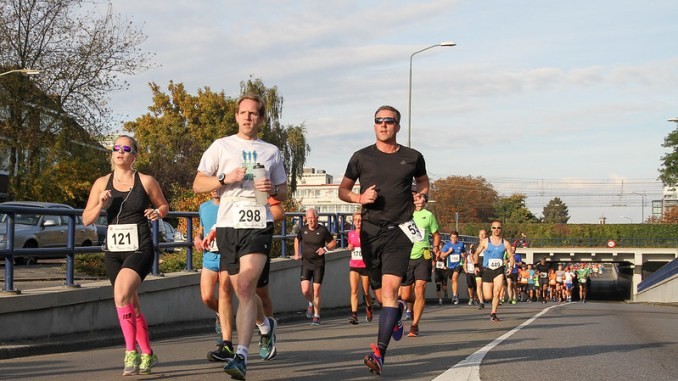
Considering that experts say sleep may actually be the single most important factor in exercise recovery, according to research from the International Journal of Sports Medicine, incorporating any habits that help your body better prepare for a good night’s sleep is worthwhile.
When it comes to practices, breathwork resulted in the second highest average impact on increased recovery scores and increased heart rate variability (HRV) and also reduced resting heart rate (RHR), two key indicators of recovery state. Approximately 17 percent of runners logged breathwork as a recovery modality at a frequency of about 6.4 times per month.
Frankly, more runners should be doing this more often, especially because it is so easy and accessible to do. Breathwork is a type of active mediation, explains Ally Mazerolle, a lead breathwork teacher at mindfulness studio Open. “The active part is that you’re really focusing on your breath, which helps your mind focus,” she says.
This kind of practice is so important for runners because if running puts your body in a stress (or fight or flight) response, “breathwork stimulates your parasympathetic nervous system, relaxing the heart rate and signaling the body that it’s time to rest and digest and recover,” says Mazerolle. And that recovery period is when your body rebuilds and repairs itself from the stress of exercise.
If you spike the nervous system with a workout then go straight into meetings or other high-stress scenarios, your body never has a chance to relax—or recover. And piling on cumulative fatigue like that is a recipe for overtraining or burning out.
Don’t be intimidated by the idea of adding another element to your training regimen. Breathwork can easily be incorporated during your cooldown stretching, says Mazerolle. It can be as simple as taking 10 to 15 slow inhales through your nose followed by slow exhales through your mouth, or something more intentional like box breathing, where you inhale for four counts, hold your breath for four counts, exhale for four counts, and hold there for four counts, then repeat.
It’s as easy as that—and the proof will be in your fitness tracker metrics or your next performance.
(06/17/2021) ⚡AMPby Runner’s World
Reasons why you might feel nauseated at the end of a run
Feeling like throwing up after running—or actually doing it—is not fun, nor is it uncommon. Nausea or vomiting during or after a run can happen for a few different reasons.
Most of the time, while unpleasant, it's not serious, and it's usually something you can manage. If you get nauseous after running while training for a race, consider it an opportunity to determine the cause and fix it before the event.
Reasons Why You Feel Sick to Your Stomach

Even if you usually have an iron stomach, intense exercise can reduce the flow of blood to your digestive system. The result is that queasy feeling, especially when paired with these common causes of post-run nausea.
Pre-Run Meal Timing

If you ate less than an hour before your run, that's too close to your workout and it's possible that you'll feel nauseous and even throw up whatever you ate. It's OK to have a light, healthy snack about 90 minutes before your run.
Try to eat something that is easily digestible, such as toast with peanut butter or a banana. If you eat something that takes longer to digest, like fatty or fried foods, you should wait at least 2 hours before running.
Dehydration
Nausea is also an early symptom of dehydration. Be sure to drink water before your run. You should be fully hydrated before you start running. While running, obey your thirst and drink when you are feeling thirsty.
In general, that means about 6 to 8 ounces of fluid for runners running faster than an 8-minute per mile pace, and 4 to 6 ounces of fluid every 20 minutes for those running slower than that. But also be aware that drinking too much water can also cause nausea.
During longer workouts of 90 minutes or more, some of your fluid intake should include an electrolyte sports drink to replace lost sodium and other minerals. And don't forget to rehydrate with water or a sports drink after your run, too. If your urine is dark yellow after your run, you're dehydrated and need to keep rehydrating. Aim for urine the color of light lemonade.
Some runners don't drink during their runs because they don't have access to water if they're running outdoors. An easy solution to that problem is to run with a hand-held water bottle or belt carrier made specifically for runners. If you really don't like to carry water with you, plan your route so that you have access to water fountains or a strategically placed water bottle.
Hot Weather
Use caution when the conditions are extremely hot and humid. Even if you attempt to stay hydrated when running in those conditions, you could still be at risk for nausea, dehydration, and other heat-related illnesses. Run indoors or reduce the distance or intensity of your workout to help you stay safe when running in the heat.
Your Sports Drink or Energy Gel
If you've consumed a sports drink or energy gel product while running, your nausea could be a reaction to the food or beverage. Some runners find that their stomachs are sensitive to sugary sports drinks or energy gels. This is often the case if you combine a drink and a gel. Together, they provide too much sugar for your stomach to handle.
To mitigate this issue, try making your own rehydration drink by adding 4 tablespoons of lemon juice, a couple of pinches of salt, and 2 tablespoons of honey to 16 ounces of water. Instead of energy gels, try dried fruit, nuts, or honey (which is available in portable Honey Stinger packets).
Overdoing It
Another possible cause of nausea during or after running is that you simply ran too hard and overexerted yourself. You may also feel more tired than usual, or moody and irritable, or slow to catch your breath. This feeling can be a sign that you are lacking some fitness for the pace you were running.
Avoid this problem by making sure you're warmed up before starting an intense run, and running at a pace that you're ready for. (Tip: During a distance run, you should be able to hold a conversation while running.) Always increase your pace, distance, or time slowly and gradually—and never all three at once.
What to Do When Nausea Strikes
If you feel like you might throw up after a run, sip some water very slowly, in case you are dehydrated. If heat is a likely culprit, make sure you get into an air-conditioned space as soon as possible to cool off.
Whatever the suspected cause may be, don't force yourself to continue running (although you should not skip your cool-down, as it may help you feel better). Just rest. If you're still feeling sick or throwing up after several hours, you may want to consult a healthcare professional.
If your post-run nausea was short-lived, and you feel pretty confident that you know what caused it, you should be able to run again within a day or two. If your nausea was due to overexertion, scale back your intensity and be sure to warm up and cool down adequately.
If you think your pre-run meal or on-the-go nutrition was the culprit, experiment to see what foods and what timing work better for you. It's always better to experiment when you are training so that you will be comfortable during a race, if you have one planned. Consider adding notes on nutrition to your training log so you can look for patterns and keep track of successes and failures.
(06/16/2021) ⚡AMPby Christine Luff
Missouri man returns for another ‘Grandma’s Double,’ running the course twice in one day
The first 25-26 miles are “the easy ones,” said Eric Strand, 60. “Then you have the benefit of aid stations, the crowd and fellow runners to commiserate with on the way back. It’s a fun way to get a training run in.”
Before runners hit the starting line, before volunteers set up aid stations and before the sun rises, Eric Strand is running Grandma’s Marathon.
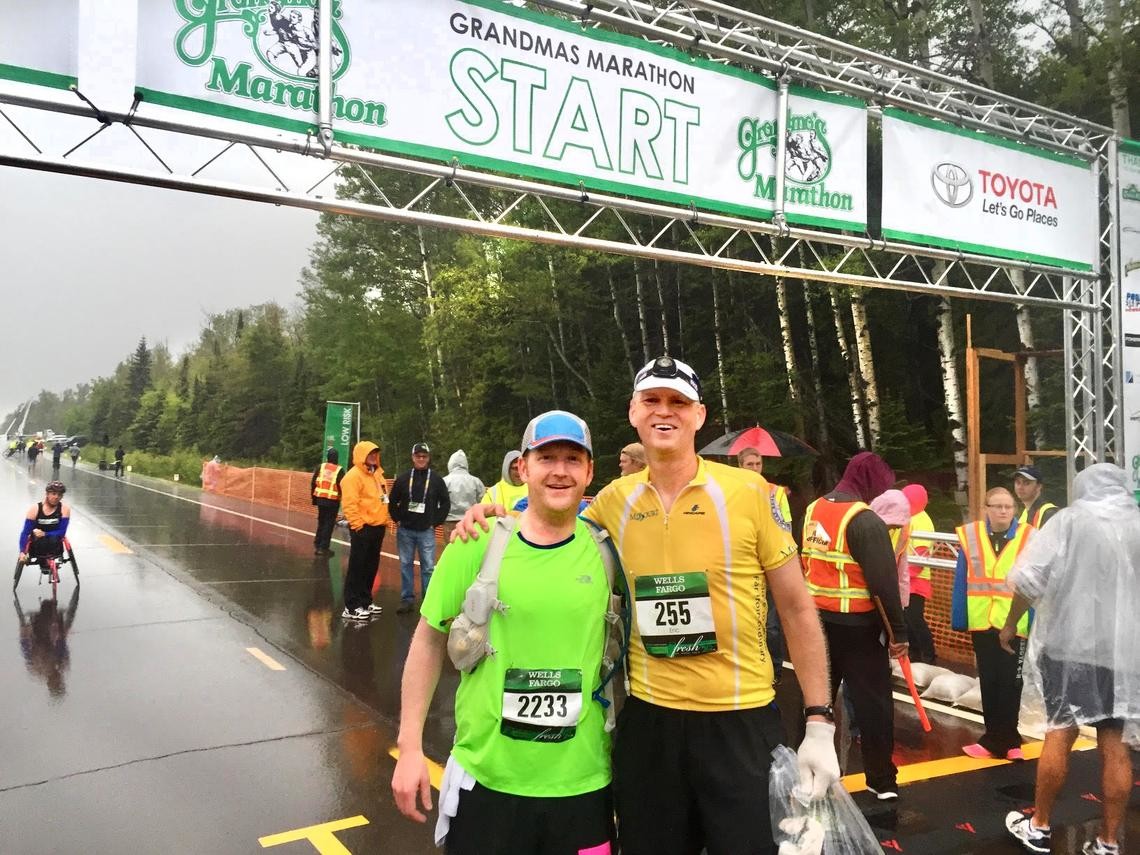
Backwards. And then back again.
The “Grandma’s Double” is a long-running tradition for Strand.
About 3 a.m. on race day, his wife drops him off in Canal Park. He runs 26.2 miles to Two Harbors — and joins the other marathoners for Round 2.
The first 25-26 miles are “the easy ones,” said Strand, 60. “Then you have the benefit of aid stations, the crowd and fellow runners to commiserate with on the way back. It’s a fun way to get a training run in.”
It started as a way to prepare for the 100-mile Leadville Trail ultramarathon. Grandma’s landed on a weekend that Strand needed to get in a 50-mile run. Instead of spreading it out, he decided to pack it into one day.

“It was very interesting running the course backwards, especially when the bars had people filing out. You had an interesting crowd," Strand said in a 2012 News Tribune story.
Strand gets to see things other marathoners don’t: the race course waking up and volunteers getting ready, and some of the aid station captains are there every year.
He has heard his fair share from passersby about going the wrong way, and it happens even more now.
“They've all learned their lines,” he said with a laugh.
The Missouri man, formerly of St. Paul, grew up hearing about Grandma’s, but on New Year’s Eve before his 40th birthday, he registered for it.
He trained for six months and made every mistake.
“There’s euphoria. You hit new distance markers … you get this in your mind that you are invincible. The next day, you wake up, and you have plantar fasciitis or shin splints or your knee hurts, and you very quickly realize you aren't,” Strand said.
But you slow down, heal up, maybe bike for a while and you get back to running, he added.
Strand recalled the end of his first Grandma’s Marathon: “As I was enjoying the runner’s high, my kids reminded me that there were three 70-year-olds that beat me that day. It brought me down to earth; they’re really good at doing that.”
Strand said tying training into a race is one way to make it fun. He averages about 2,500 miles a year; that’s typically 7 miles a day, but sometimes, it’s 100 miles at a time.
Strand ran his first five Grandma’s Doubles solo, save for one year with Ben McCaux. Since then, he has been joined by his son, Zach.
They’ve tackled the Double three times; they ran their first father-son Leadville 100 in 2017.
In a 2017 video of the latter, the pair are seen trekking across Colorado terrain.
“Zach’s doing great,” Eric Strand says into the camera. “He’s fun to run with. As long as he keeps his fueling and hydration in good shape, he’s down for a buckle.”
They have tallied 25 marathons and ultramarathons together.
“He’s better than me now, which he’s quick to point out,” he said.
During training, Strand mostly listens to audiobooks, but, if he needs motivation, there’s Britney Spears and Miley Cyrus — music his kids listened to when they were teens.
As for his powerhouse song, that’s Eminem’s “Lose Yourself.”
He doesn’t listen to anything during races; he likes to interact with others.
His race-day eats were pretty standard: Gatorade and gels; but for ultramarathons, his wife brings him a cheeseburger at mile 50.
Saturday will be his 22nd Grandma’s Marathon — his 10th Grandma’s Double — and there’s no end in sight.
There’s a cadence to the year — the Boston Marathon in April, Leadville in August, Chicago in October, a mix of others — but June will always be Duluth.
“There will be a day when I won’t be able to do this,” Strand said, “but it’s not today, and hopefully won’t be for a long time. I hope to enjoy it as long as I can.”
(06/16/2021) ⚡AMPby Melinda Lavine
Grandmas Marathon
Grandma's Marathon began in 1977 when a group of local runners planned a scenic road race from Two Harbors to Duluth, Minnesota. There were just 150 participants that year, but organizers knew they had discovered something special. The marathon received its name from the Duluth-based group of famous Grandma's restaurants, its first major sponsor. The level of sponsorship with the...
more...Seven questions runners are tired of hearing
You can’t understand the sport of running unless you’re personally into it. No one who doesn’t run can wrap their head around training, racing and the other aspects of running, and because of that, non-runners sometimes ask silly questions. Some of these questions are more common than others, and you might hear the same few over and over again. Here are seven of those questions that runners everywhere are tired of hearing.
1. Why do you run?
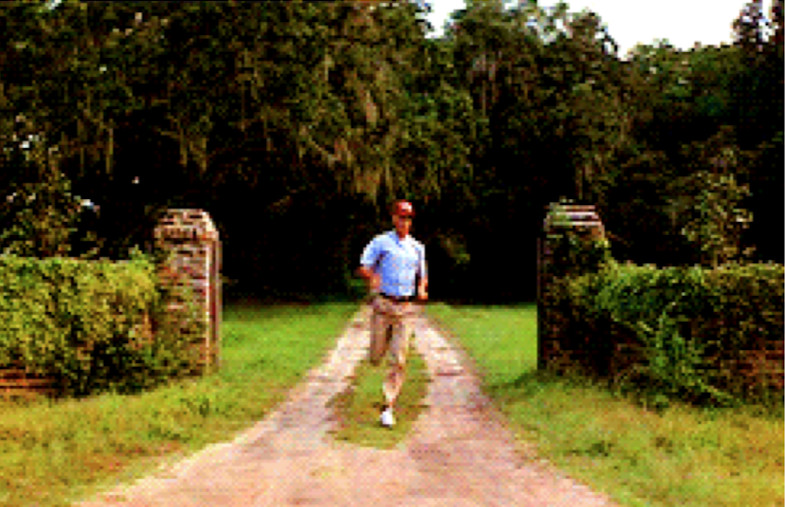
This isn’t some deep question — the person asking it isn’t looking to hear about the joy you get from running. Instead, they have no idea why anyone would waste their time going for a run, and if you tell them that you enjoy it and find it fun, they’ll scoff at you. Odds are at least one person has asked you this before, and it’s likely that some runners have heard it multiple times.
2. Did you win your race?
Some people go to races with the sole purpose of winning, but most of us will never get the chance to break the tape at a race. Non-runners don’t know this, and many of them will ask if you got the win at your most recent competition. If someone asks you this, kindly explain that, no, you didn’t win, but you race for much more than standing on the podium.
3. Could you make the Olympics?

This might seem like a joke, but depending on how clueless your friends are, they could think you have a chance at making the Olympics. If you actually are an Olympic hopeful, that’s pretty cool — good luck with qualifying. Most of us, though, don’t have a shot at the Games, but some of our friends might think, “Well, I know you’re pretty fast, so I assumed you could make it.”
4. Do you ever wear normal clothes?
As runners, many of us wear running gear wherever we go. Whether we’re sporting short-shorts, bright running shoes or any other part of a race uniform, we’re just happy in those clothes. The answer is yes, we do wear other clothes, but we prefer athletic wear.
5. Do you want to race?
Some non-runners feel the need to challenge runners they meet to a race. Since you’re probably wearing your running gear already, you’re ready to race, so that’s good, but it can be annoying when someone randomly challenges you and says, “I bet I can beat you.”
6. Don’t you get bored?
Sure, sometimes we can get bored, but we love running, so the few instances of boredom we might face are well worth it in the end.
7. Have you run a marathon?
This question is asked by a lot of people, non-runners and runners alike. The marathon is viewed as the race, and everyone wants to know if you’ve run one. If you have, that’s great, but if not, don’t feel like you’re any less of an athlete because of it. You’re a runner, not a marathoner, so be proud of the races you do run and don’t worry about the marathon unless you choose to register for one.
(06/16/2021) ⚡AMPby Running Magazine
The study confirmed that eating pork might induce some false accusations of the abuse of nandrolone in anti-doping.
What is nandrolone? As defined by the National Library of Medicine, nandrolone is a synthetic, anabolic steroid analog of testosterone.
The NIH states nandrolone can be used for testosterone replacement therapy to increase nitrogen retention and fat-free muscle mass.
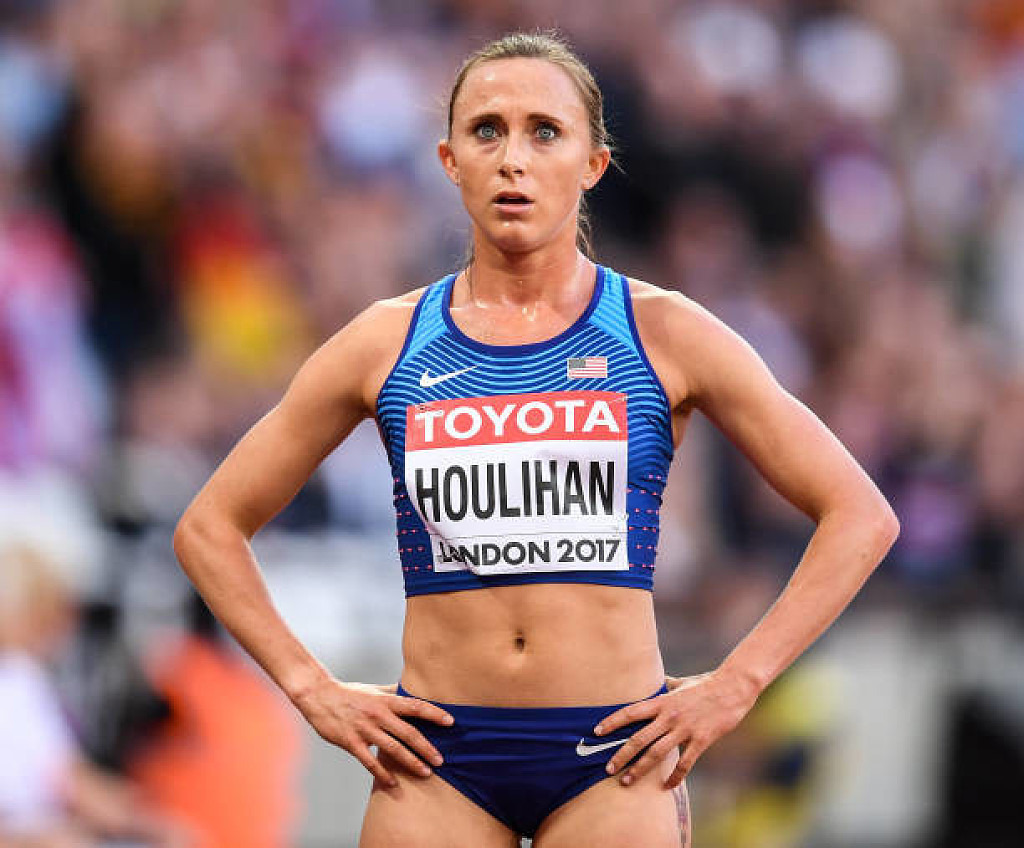
In bodybuilders, the use of androgenic-anabolic steroids to increase muscle mass is common.
Nandrolone decanoate is one of the most popular misused androgenic-anabolic steroids, although the effects on body composition are equivocal.
The use of androgenic-anabolic steroids, such as nandrolone, is common in bodybuildersCredit: Getty
Is it found in pork?
A study by the National Library of Medicine revealed that the consumption of pork can cause irregularly high levels of nandrolone.
Then NLM conducted a study using the urine of three male volunteers who consumed 310 grams of pork, which could be the meat, liver, heart and kidney.
According to the study, the three individuals delivered urine samples before and during 24 hours after meal intake.
Nearly 10 hours after the participants ate pork, the report showed high levels of nandrolone.
The consumption of pork can cause a high level of nandrolone within a 24-hour period of consumptionCredit: Getty
"19-NA and 19-NE concentrations in urine reached 3.1 to 7.5 microg/L nearby 10 hours after boar tissue consumption," the NLM reported in their study.
The study confirmed that eating pork might induce some false accusations of the abuse of nandrolone in anti-doping.
What did Shelby Houlihan say caused the high level of nandrolone?
In an Instagram post announcing her suspension, Houlihan claimed she had “never even heard of nandrolone” and blamed a contaminated pork burrito she ate 10 hours before the positive test in January.
Houlihan insisted that ingesting the anabolic steroid must have inadvertently come from eating a burrito “from an authentic Mexican food truck that serves pig offal near my house in Beaverton, Oregon” 10 hours before a 6am drugs test last December.
(06/15/2021) ⚡AMPRace walking mixed team to debut at Paris 2024 Olympics
A race walking mixed team event is set to make its Olympic debut at Paris 2024, following confirmation from the International Olympic Committee (IOC) Executive Board that it will be the mixed-gender contest added to the athletics programme.
The IOC Executive Board previously decided that the number of athletics events should stay at 48 for Paris - which led to the men's 50-kilometre race walk being dropped in favour of a mixed-gender event in the quest for gender equality.
World Athletics and the IOC have agreed that this will be a race walking event, although the competition format - including the distance and the number of athletes in each team - has not been chosen yet.
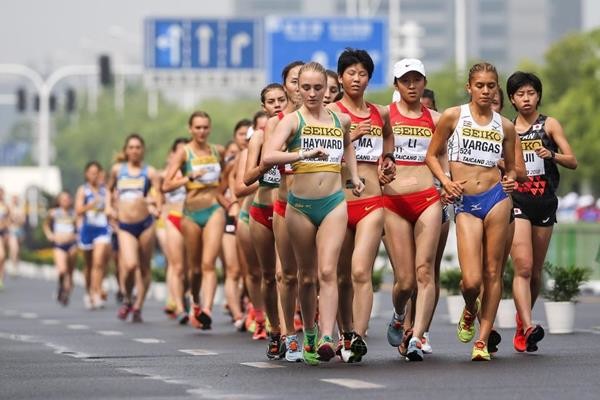
A proposal for the format is due to be presented to the IOC Executive Board in December.
The Executive Board has also approved World Sailing's proposal to scrap the mixed kiteboarding event and instead have men's and women's contests.
This was World Sailing's first alternative option in place of mixed offshore, which was removed from the programme after concerns were raised by the IOC.
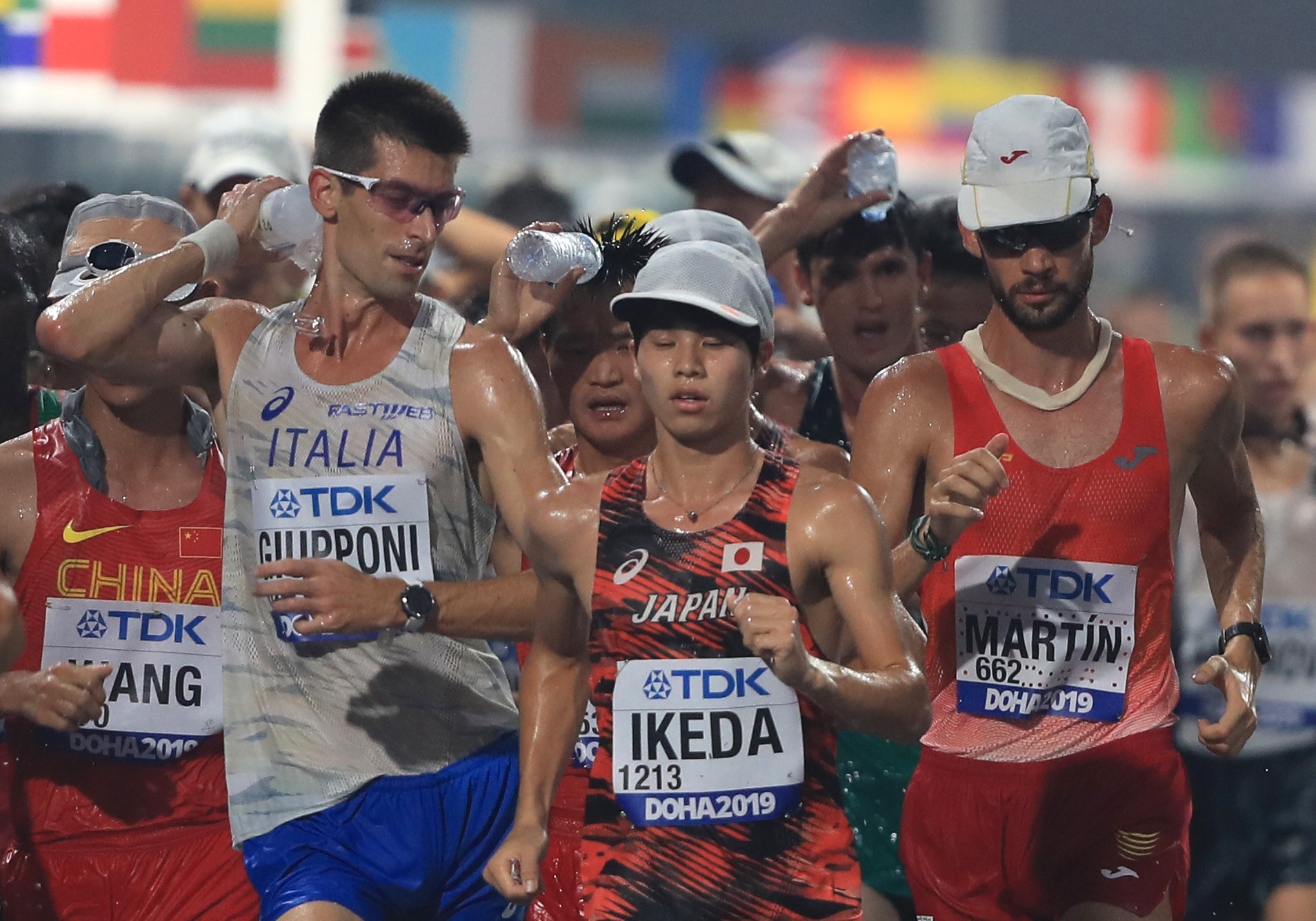
These included additional broadcasting costs and the field-of-play security.
Sailing will maintain 10 medal events, with kiteboading - set for an Olympic debut at Paris 2024 - now accounting for two of them.
Additionally, the IOC Executive Board approved the new competition format for modern pentathlon, which is set to be based in one venue.
As proposed by the International Modern Pentathlon Union, this 90-minute competition begins with riding, followed by the fencing bonus round and swimming, before closing with the laser-run.
Breaks of between five and 15 minutes will occur between each discipline.
The equestrian leg lasts 20 minutes, followed by 15 minutes of fencing, 10 minutes of swimming and 15 minutes for the laser-run.
The Paris 2024 Olympics, scheduled to take place from July 26 to August 11, will be the first fully gender-balanced Games, with exactly 50 per cent male and female participation, says the IOC.
(06/15/2021) ⚡AMP
by Michael Houston
Paris 2024 Olympic Games
For this historic event, the City of Light is thinking big! Visitors will be able to watch events at top sporting venues in Paris and the Paris region, as well as at emblematic monuments in the capital visited by several millions of tourists each year. The promise of exceptional moments to experience in an exceptional setting! A great way to...
more...Shelby Houlihan says she ate a pork burrito before her drug test and this is why she tested positive.
Olympic runner Shelby Houlihan said she has been banned from the sport for four years following a positive test for anabolic steroids that she attributes to eating a pork burrito.
Houlihan said she was devastated to learn of the suspension from the Athletics Integrity Unit (AIU), an independent body that combats doping, after she tested positive for nandrolone.
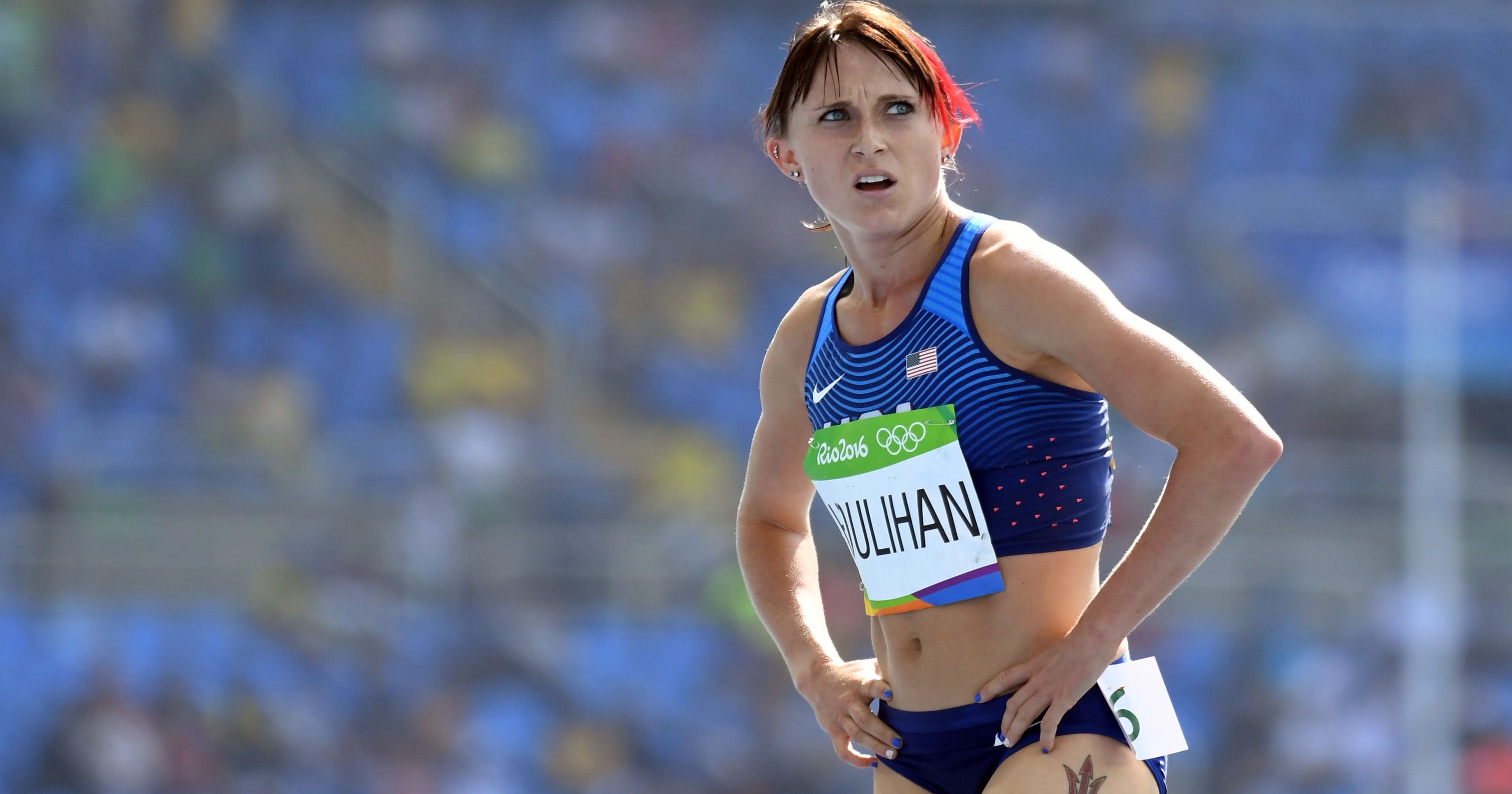
Houlihan said in a post on Instagram Monday that a burrito she ate before the test contained pig organ meat, or offal, which she said can lead to a positive test for nandrolone. A study funded by the World Anti-Doping Agency (WADA) found trace amounts of nandrolone can be found in that kind of meat and warned about the possibility of a false positive.
The ban will prevent the 28-year-old from competing in upcoming US Olympic Trials and the Tokyo Olympic Games. Doping accusations and investigations have led to multiple bans of athletes and even entire countries from competing, including a two-year ban on Russia from the Court of Arbitration for Sport (CAS).
The runner said she received an email from AIU on January 14, 2021, informing her that a drug test she took December 15, 2020, returned positive for nandrolone.
"When I got that email, I had to read it over about ten times and google what it was that I had just tested positive for," she said in the post. "I had never even heard of nandrolone."
(06/15/2021) ⚡AMPSifan Hassan will turn her attention to the mile in Gateshead
Sifan Hassan will test her speed once again when she races the mile at the Muller British Grand Prix – a Wanda Diamond League meeting – at Gateshead International Stadium on 13 July.
The world 1500m and 10,000m champion holds the world mile record with 4:12.33 and last weekend set a world record for 10,000m with 29:06.82 at the World Athletics Continental Tour Gold meeting in Hengelo, although it survived only two days before being beaten by Letesenbet Gidey of Ethiopia.
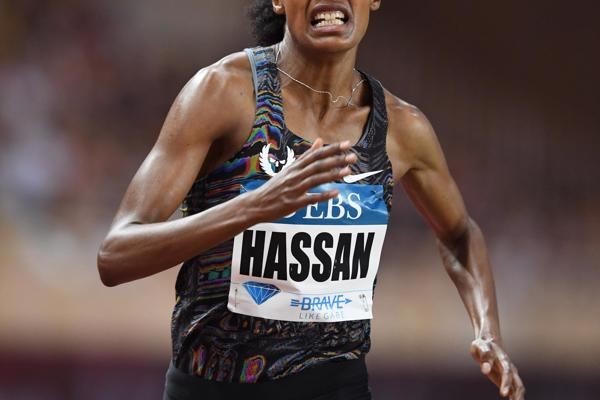
The Dutch athlete is clearly in form to challenge her world mile record if conditions are good in Gateshead. In addition to her 10,000m world record in Hengelo, she beat Olympic 1500m champion Faith Kipyegon of Kenya and European champion Laura Muir of Britain over 1500m at the Diamond League in Florence on Thursday night, clocking 3:53.63.
“I’ve raced several times in the past at events in the UK – at the Anniversary Games in London, meetings in Birmingham and Glasgow and of course the 2017 World Championships and 2018 World Indoor Championships. There is always a warm welcome, a great atmosphere and the fans have good knowledge of the sport,” said Hassan.
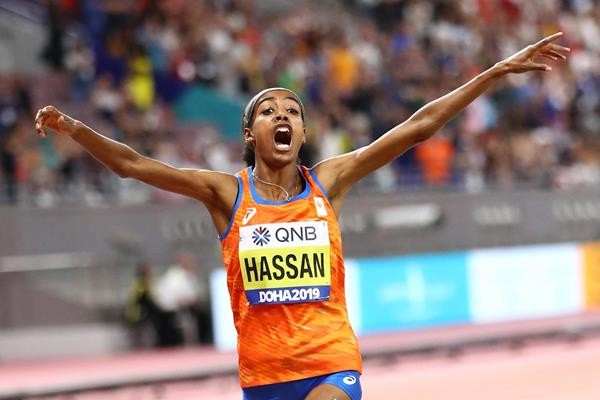
“Running over one mile in Gateshead on 13 July gives me a chance to test my speed ahead of the Olympic Games. Maybe I can run a good time too although much will depend on the weather. Hopefully it will be warmer and drier than it was for the Diamond League in Gateshead last month!”
Gateshead staged the first Wanda Diamond League event of 2021 after it was moved from Rabat in Morocco to the North East of England and now the same venue will host the seventh Diamond League of the season after it was moved from its original home of London.
(06/15/2021) ⚡AMPby World Athletics
American record holder Shelby Houlihan receives four-year ban week before Olympic track trials
Accomplished distance runner Shelby Houlihan was handed a four-year ban exactly one week before the start of U.S. Olympic Track and Field Trials.
Houlihan was considered an Olympic medal contender entering this year. The 2016 Olympian holds American records in both the 1500m and 5000m. In 2018, she became the second woman ever to win both distances at the U.S. outdoor championships.
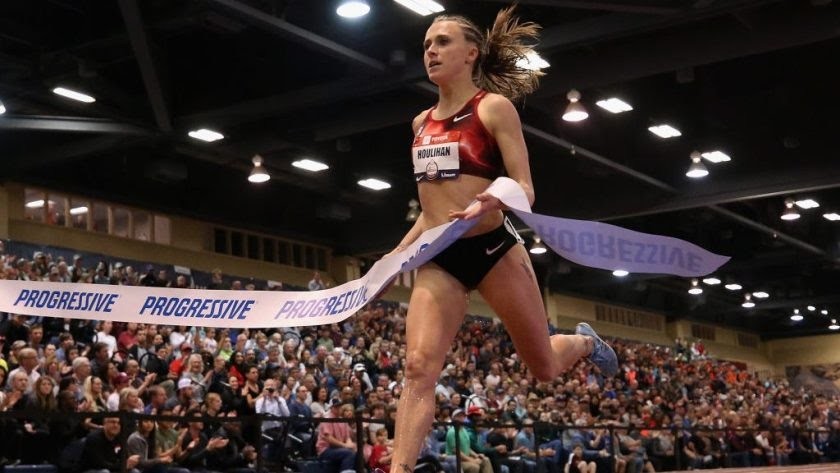
Houlihan placed fourth in the 1500m at the 2019 World Championships.
The 28-year-old had not competed yet this year, which was explained on Monday evening.
Houlihan tested positive for nandrolone in an out-of-competition urine test administered by the World Anti-Doping Agency on Dec. 15, 2020.
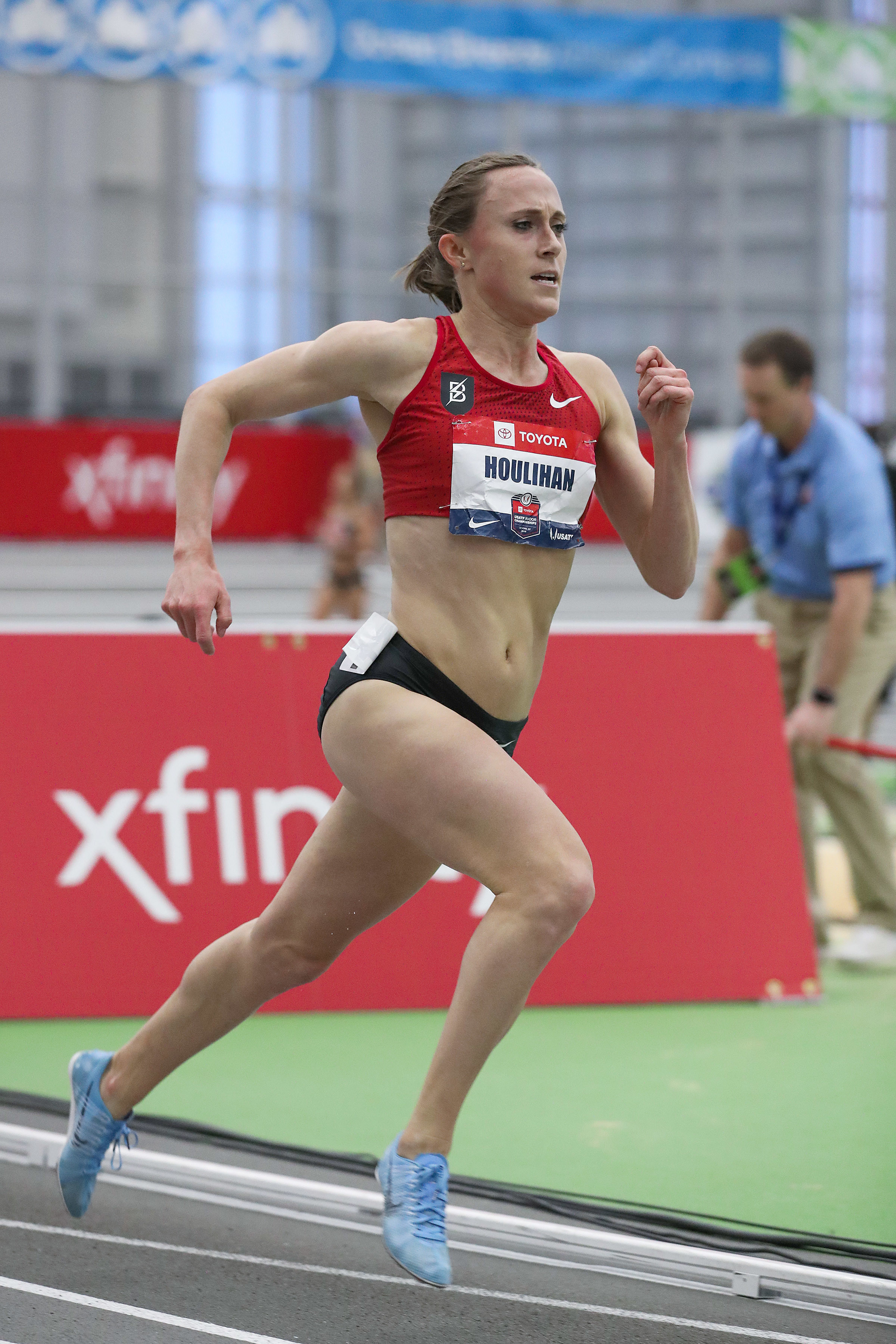
Nandrogen is an androgen and anabolic steroid known to increase muscle mass.
In a virtual press conference, well-known sports attorney and founder of Global Sports Advocates Paul Greene walked reporters through Houlihan’s case, alongside Houlihan and Bowerman Track Club coaches Jerry Schumacher and Shalane Flanagan, an Olympic silver medalist in the 10,000m.
“Shelby is an innocent athlete,” Greene declared. “What happened to her is entirely unjust.”
“I don’t have the words to articulate the depth of sadness I feel for you,” head coach Schumacher said in his statement.
After being notified of the positive test in January, Houlihan created a food log of everything she had consumed the week prior to the test.
Her team believes the result came from a pork burrito Houlihan purchased at a food truck near her home in Beaverton, Oregon, and ate the night before the 6 a.m. test.
It has been noted in WADA documents that consumption of meat, specifically pig offal, can lead to the presence of nandrolone.
Greene explained that Houlihan initially received a provisional suspension of more than three months, which caused them to opt for a single hearing before the Court of Arbitration for Sport.
In the interim, Houlihan had a hair sample tested and passed a polygraph test in an effort to prove her innocence. Greene hired a private investigator and former WADA scientist to help prove their case as well. He pushed for the sample to be tested at a second lab to no avail.
According to Greene, Houlihan has been tested approximately 100 times since 2016 and has never tested positive or missed a test in that time.
The CAS hearing was held the first week of June, with the final ruling of a four-year ban delivered on Friday, June 11. That would take Houlihan out of the running of the Paris 2024 Olympics as well; she said she is currently unsure of what her future holds.
“I feel completely devastated, lost, broken, angry, confused and betrayed by the very sport that I loved and poured myself into just to see how good I was,” Houlihan said as she fought back tears. “I want to be very clear: I’ve never taken any performance-enhancing substances and that includes the one of which I have been accused. … I do this sport because I love it, I have so much fun doing it and it’s always the best part of my day.
“This sport means everything to me. I believe doping and cheating is weak. … I would never disrespect the sport, my competitors, my teammates, my coaches, my family and my fans this way. I love the sport too much. …
“I’ve always wanted to stand at the top of an Olympic podium with a gold medal around my neck, knowing I did that, and now I am not sure that will ever happen.”
Greene is considering an appeal to the Swiss federal tribunal.
(06/15/2021) ⚡AMPGrandma’s Marathon founder Scott Keenan has published a new book documenting his journey of bringing the event from just 150 runners in 1977 to one of the most respected road race in USA
My Journey to Grandma’s Marathon: History and Heroes focuses on the people involved in bringing Grandma’s Marathon to prominence, ranging from early champions like Garry Bjorklund and Dick Beardsley to longtime journalists who covered the race like Kevin Pates.
Keenan, who spoke about his book on the “Gearing Up for Grandma’s” podcast, admitted the writing process came with challenges, but he thought it necessary to chronicle the evolution of the event and recognize lots of the people responsible.
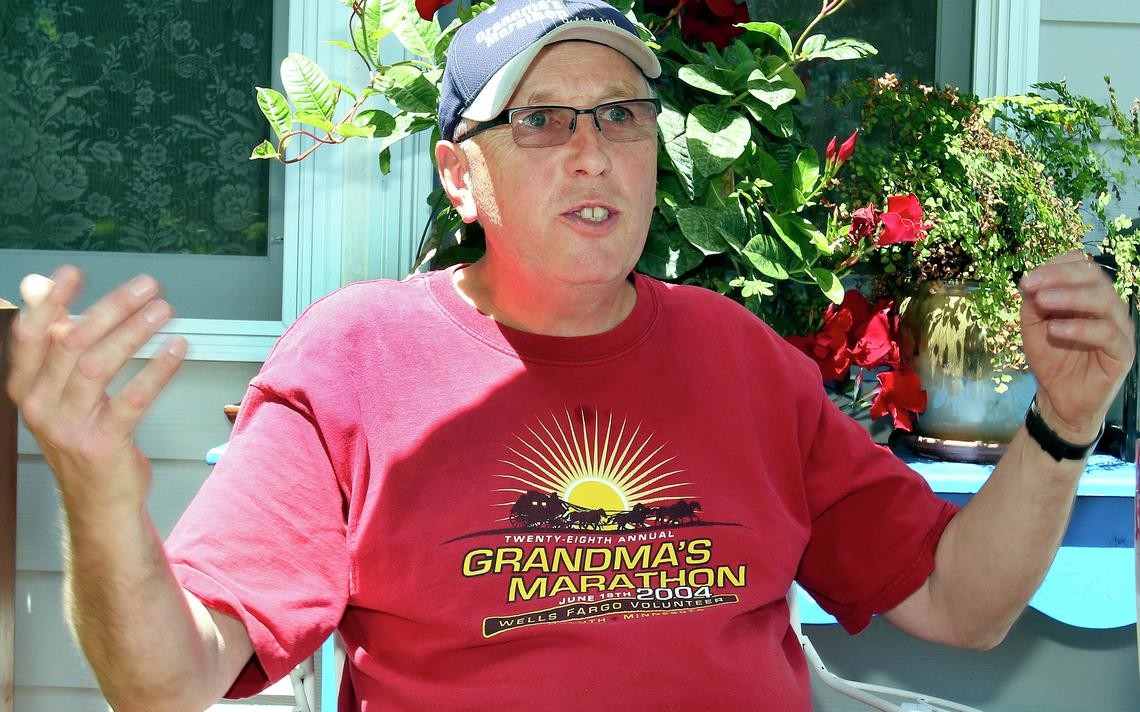
“We had to do something special back then. We had to invite the world to Grandma’s Marathon, and we did,” he said. “We had the great race course, the great location, we just needed the organization to put on a good race. It was very important to me to try and take running to a new level in the Duluth area, and I’m so proud of what’s been built with Grandma’s Marathon.”
The full “Gearing Up for Grandma’s” video podcast featuring Keenan will debut as part of the virtual 2021 Essentia Health Fitness Expo at 2:00 p.m. on Thursday, June 17.
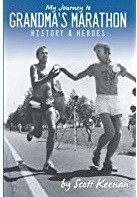
During Keenan’s tenure, Grandma’s Marathon grew to be one of the largest marathons in the country and now welcomes more than 20,000 runners to Duluth and the surrounding region each year. The race also played host to nine national championships, something he points to as one of his proudest moments during his time with the race.
The book costs $17.99 and can be bought online at scottkeenanbooks.com. A portion of all proceeds will go to benefit the Young Athletes Foundation (YAF), which is the charitable piece of Grandma’s Marathon that provides money and resources to local youth organizations to help keep the area’s kids active and healthy.
Keenan, who served as the race’s executive director for 37 years before retiring in 2013, will also be selling and signing copies of his new book during this year’s in-person Essentia Health Fitness Expo on race weekend. He will be available from 10:00 a.m. to 9:00 p.m. on Friday, June 18 in Pioneer Hall at the Duluth Entertainment Convention Center (DECC).
(06/15/2021) ⚡AMPby Running USA
Grandmas Marathon
Grandma's Marathon began in 1977 when a group of local runners planned a scenic road race from Two Harbors to Duluth, Minnesota. There were just 150 participants that year, but organizers knew they had discovered something special. The marathon received its name from the Duluth-based group of famous Grandma's restaurants, its first major sponsor. The level of sponsorship with the...
more...Sebastian Coe's monumental 800 meters
June 10, 1981 remains a red-letter day in the long history of 800m running, for it was in Florence late that night that Sebastian Coe lowered his own world record from 1:42.33 to 1:41.73. Every world record is special, marking as it does an advance on anything previously achieved, but Coe's run was extra-special. That time would not be bettered for 16 long years, itself a record in the annals of the men's 800m event.
When strongly-built Alberto Juantorena won the 1976 Olympic title in a world record 1:43.50 it was widely thought that here was the man to revolutionize two-lap running. And yet, for all his speed (44.26 400m) and power, the Cuban succeeded only in clipping another few hundredths off the record with 1:43.44 at the 1977 Universiade. Instead it was the slight figure of Coe who has gone down in history as the athlete who, like Germany's Rudolf Harbig in 1939 and New Zealand's Peter Snell in 1962, pushed back the frontiers of 800m performance.
It was in 1979 that Britain's Coe established himself as one of the all-time greats of middle distance running when in the space of 41 days he shattered three world records. He started with 1:42.33 in Oslo on July 5, and was as shocked as everyone else by his time. After clocking his fastest 400m of 46.87 at the AAA Championships he returned to Oslo for the star-studded Dubai Golden Mile on July 17. Despite being practically a novice at the distance with a best time of 3:57.67, he moved into the lead shortly before the three-quarter mark (2:53.4) and then proceeded to cover the final quarter in 55.6. He had run 3:48.95, again astonished when told he had broken New Zealander John Walker's world record of 3:49.4. As he related later: "When I looked back twice in the final straight it was fear, it was panic, not pain, that I was feeling. I certainly wasn't in the slightest distress at the finish."
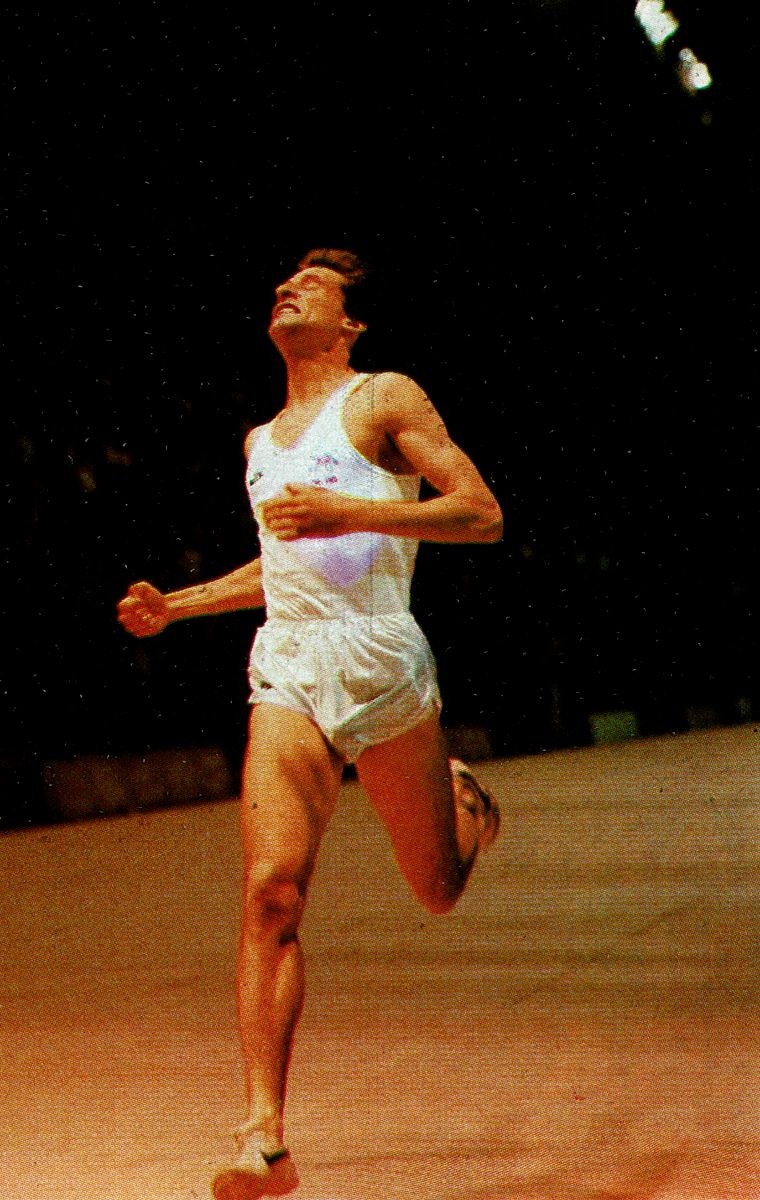
Record number three came about in Zurich on August 15. The target this time was the 3:32.16 1500m by Tanzania's Filbert Bayi. Elated by the knowledge that he had never been faster, having been timed at 45.5 for a 400m relay leg 10 days earlier, Coe shot off at a potentially suicidal pace by clinging to the pacemaker, sweeping through the opening 200m in 25.9 and 400m in 54.3. Before 800m (1:53.19) had been covered, Coe was on his own, nearly 20m ahead of the field. Instead of easing back on the third lap he covered that in 56.3 for 2:49.5 at 1200m and at the finish – almost five seconds clear – his time was a hard earned 3:32.03.
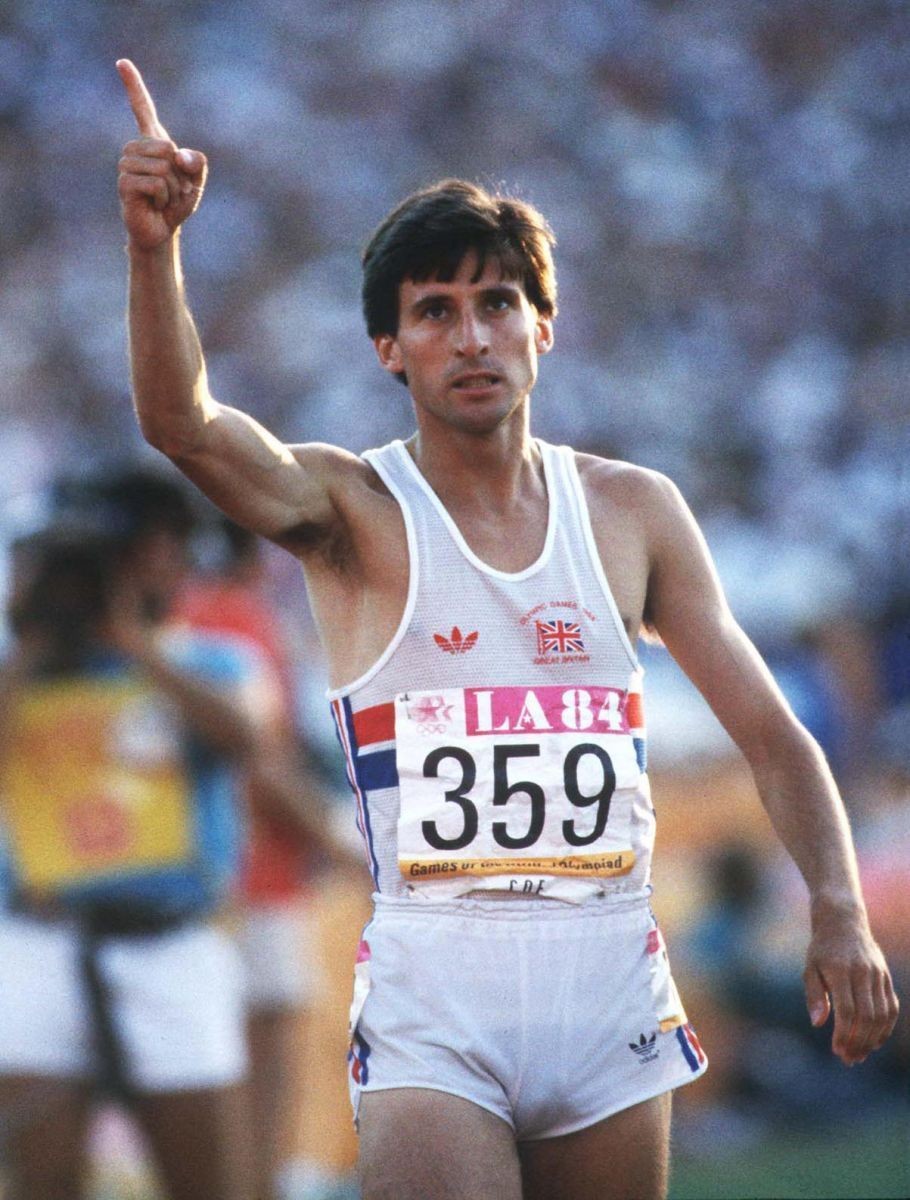
Coe's athletic immortality was sealed in 1980 when he triumphed in the Olympic 1500m in Moscow to make up for his 'disastrous' run in the 800m (a mere silver medal behind Steve Ovett) after adding to his portfolio of world records by covering 1000m in 2:13.40 in his first ever race at the distance.
And so to 1981. With no major title to aim for, the emphasis was on achieving spectacular 'one-off' performances. Asked how he had prepared during the winter, Coe replied: "My training mileage is slightly down but there's been more accent on speedwork. I'm going back to basics, trying to improve my 400m speed." That approach hadn't diminished his endurance, though, for he opened his indoor season by winning the UK 3000m title in a personal best of 7:55.2. Two weeks later he smashed the world indoor 800m record with 1:46.0. "I knew I was fit, but not that fit," he enthused.
A 46.9 400m and 46.3 relay leg on May 4 confirmed his speed was at a high level, and before his fateful appearance in Florence he won the Yorkshire county 800m title on May 17, in 1:46.5, an invitation 800m at Crystal Palace on June 3, in 1:44.06 followed two hours later with a 45.8 relay split from virtually a standing start, and as a final tune-up a 46.6 relay leg at Gateshead on 7 June. He traveled to Florence not expecting anything too special ... around 1:43/1:44.
His 800m race in Florence got under way after 11pm. Kenya's 19-year-old Billy Konchellah, then a 45.38 400m performer who would go on to become world 800m champion in 1987 and 1991, acted as pacemaker. In his slipstream Coe reached 200m in 24.5 and 400m in 49.7 and was perfectly set up for a super-fast time. Sensing Konchellah was about to flag, Coe forged ahead by 450m and after 200m splits of 24.5 and 25.2 he covered the next half-lap in a daring 25.3 for a remarkable 600m time of 1:15.0 – precisely 1:40 pace for the full distance. Inevitably he slowed towards the end but still managed a final 200m of a little under 26.7.
Coe's immediate post-race response: "I'm very happy about the result, but it was terrible waiting the 10 minutes for the official result. It's getting under 1:42 that is the great thing for me. It was as hard a race as I have run for a long time. In the last 30 meters I was beginning to tie up but apart from that there was no problem."
Coe went through that 1981 season undefeated, collecting further world records at 1000m (2:12.18) and mile (3:48.53 and 3:47.33). Other glittering performances would follow, notably a second Olympic 1500m triumph in 1984, but as a testimony to the quality of that 800m exploit in Florence note that even now, 40 years on, only two men have gone faster: David Rudisha of Kenya and Wilson Kipketer of Denmark.
(06/15/2021) ⚡AMPby World Athletics
Gene Dykes breaks M70 50K world record clocking 3:56:43, breaking the previous record by nearly 19 minutes
On a sunny Sunday in East Islip, NY, Gene Dykes broke the M70 50K world record at the USATF national 50K road championships, crossing the finish line in 3:56:43. He beat the previous record of 4:15:55, set by Germany’s Wilhelm Hofmann in 1997, by nearly 19 minutes.
This is the third world record Dykes can add to his resume, along with his M70 100-mile and 24-hour records. While his time has yet to be ratified, this is an incredible accomplishment for the already-decorated ultrarunner. To make his run even more impressive, he completed another 50K trail race only two weeks prior to his record-breaking run, and it’s been barely one month since he ran 152 miles (245 kilometres) at the Cocodona 250 in Arizona.
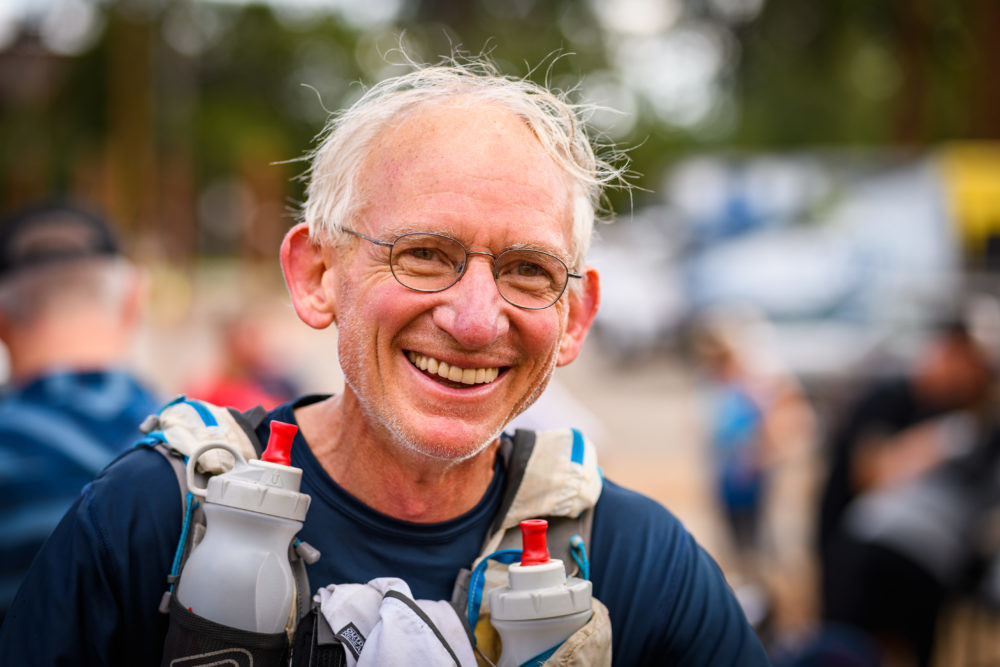
According to Dykes, the weather for Sunday’s race in Caumsett State Park was sunny, moderately windy, and not too hot, with temperatures hovering in the low 20s (Celsius) for most of the event. In a brief conversation with him after the race, he told Canadian Running (in a half-joking, half-serious manner) that he credits Canada’s late Ed Whitlock, one of the most decorated masters runners who ever lived, with his new 50K record.
“Thank you, Ed Whitlock, for never running a 50K,” he says.
Dykes is still aiming to take down Whitlock’s M70 marathon world record of 2:54:48, which he will attempt to do at this year’s London Marathon on October 3.
(06/14/2021) ⚡AMPby Running Magazine
Marathon great Wakiihuri ecstatic after receiving award from Japan
The Seoul Olympics marathon silver medalist was conferred “the Order of the Rising Sun, Gold and Silver Rays” for cementing international relations between Japan and Kenya through athletics and music.
In Summary
•Wakiihuri was the first Kenyan athlete to participate in Japan and paved the way for mass exodus of talented runners to the Asian country
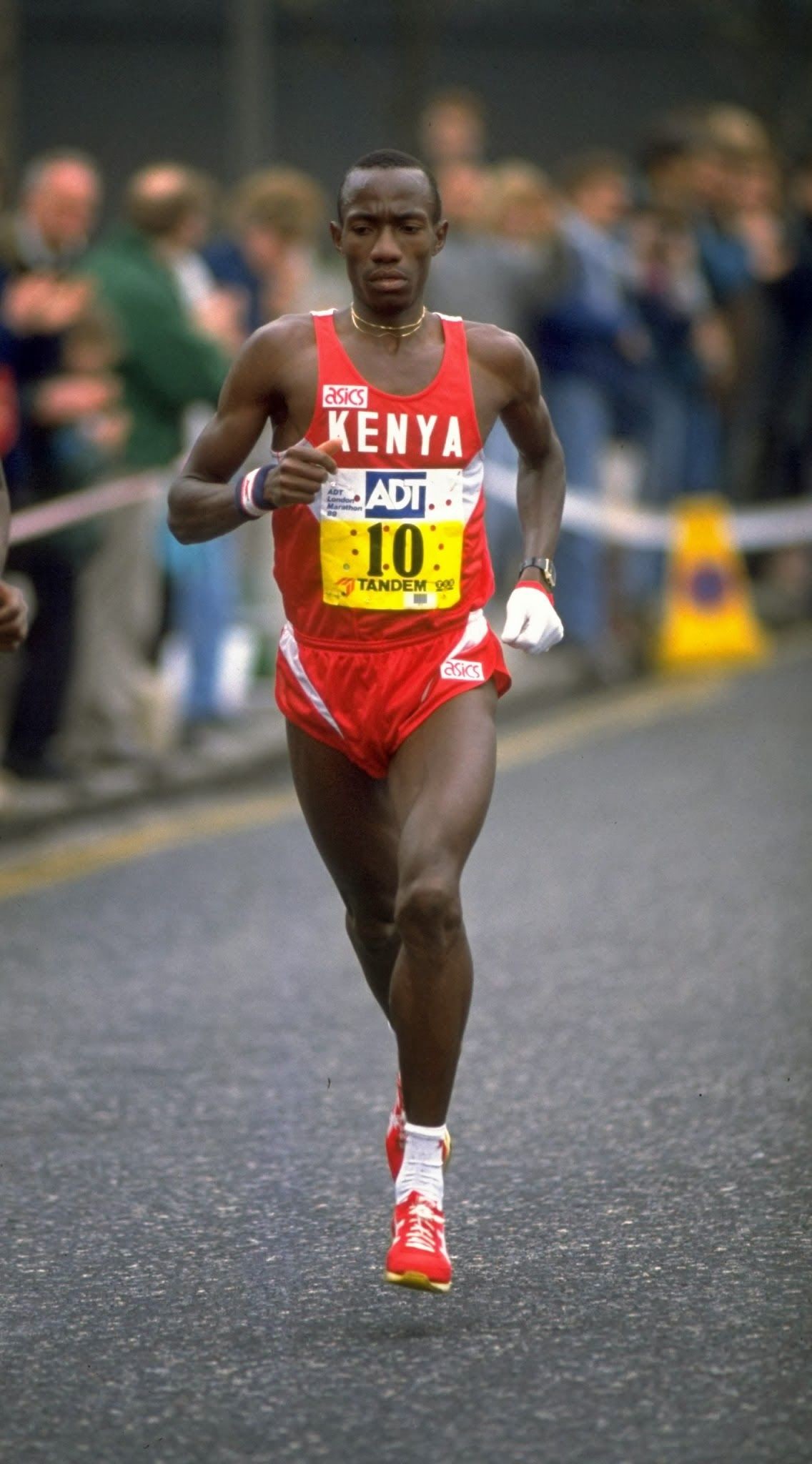
•The order is the highest one conferred to individuals who have helped cement international relations between Japan and other countries
•Japanese ambassador to Kenya says Wakiihuri's arrival in Japan and training with talented Japanese runners has uplifted athletics standards in the country
Seoul Olympics marathon silver medalist Douglas Wakiihuri was all smiles after he was conferred “the Order of the Rising Sun, Gold and Silver Rays” by the Japanese government during a ceremony at the Japanese Embassy on Friday.
The decoration was given in recognition of Wakiihuri's contribution to Japan-Kenya bilateral relations through athletics by paving the way for a steady exodus of talented Kenyan athletes to the Asian country.
“I was passed a tasuki (sash), a sign of responsibility from Japanese people to continue running in the race of life. This decoration is not only for me but for all of you who cheered for me all through the race. As I stand on the podium today, I extend my sincere gratitude for His Majesty the Emperor of Japan, the Government of Japan, Ambassador Horie, those who present here today and all the people who have supported me to date,” Wakiihuri said.
The order is the highest award conferred to individuals by the Japanese government and generally recognises those who have contributed to cementing international relations between Japan and other countries as well as promoting Japanese culture in their respective fields and talents.
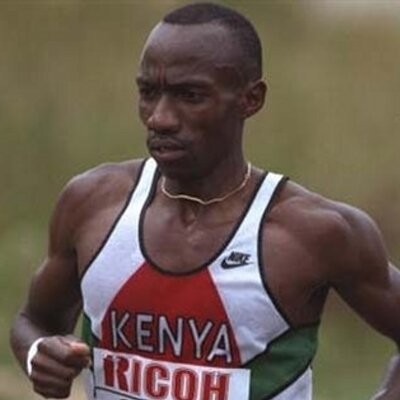
While conferring the award — on behalf of the Emperor of Japan — Japanese ambassador to Kenya Horie Ryoichi thanked the 1990 New York Marathon winner for uplifting the standards of Japanese athletics by opening up the country to other talented runners from Kenya.
"Being the first Kenyan to run in Japan, it has now become common practice to see foreign athletes training with young Japanese athletes who go on to become world’s leading marathon runners. This practice, till today, has provided a lot of stimuli and dreams for Japanese youngsters. Moreover, after his retirement, Mr. Wakiihuri has been positively engaging in boosting the bilateral cultural relationship between Japan and Kenya and extending cooperative support on various occasions, such as the organisation of the Nairobi Sotokoto Marathon," Ryoichi said.
He also praised Wakiihuri for his exceptional singing talent and incorporating elements of Japanese culture in his songs.
Also present at the ceremony were Sports Cabinet Secretary Amina Mohamed, Olympics Kenya acting secretary general Francis Mutuku and Athletics Kenya president Jack Tuwei.
Ryoichi said Japan is looking forward to welcoming Team Kenya for the upcoming Tokyo Olympics and wished them success in the quadrennial games — although he asked Kenyan runners to take it easy on their Japanese counterparts.
(06/14/2021) ⚡AMP
One of the Most Gruesome Steeplechase Mishaps Ever? You Decide
Ky Robinson’s face took a beating, but he gets faster every race.
Steeplechase is an event known for its spectacular falls. Combine barriers, a water jump, and tightly packed runners going at high speeds, and you’ve got an environment ripe for catastrophe.
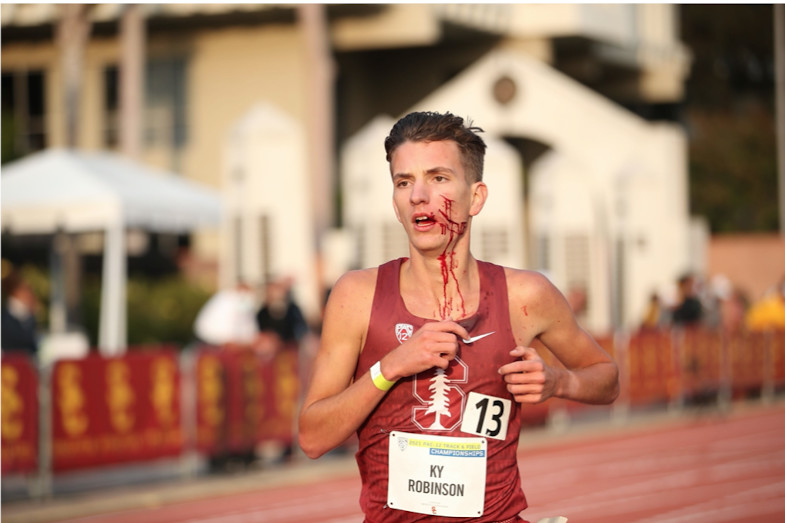
Still, even by the steeple’s high standards, what happened to Ky Robinson, a 19-year-old Stanford freshman, was ghastly.
It was early in the race at the Pac-12 championships at USC on May 15. Robinson’s trailing leg clipped a barrier, and down he went. He rolled. Straight into the path of a Washington runner.
Through no fault of his own, the Washington runner stepped on Robinson’s face with his spikes, dragging a path across Robinson’s left cheek. It could have been worse—the spikes didn’t puncture all the way through the cheek and more important, they missed his eye.
Robinson popped right up. “I didn’t realize how bad it was immediately,” he told Runner’s World. “I felt my face, my lip, I looked down and saw the blood.” He convinced himself that he had just cut his lip.
He managed to finish third in the race in a four-second personal best of 8:41.81. “The adrenaline rush took the pain away,” he said.
After the race ended, he went over to a teammate, D.J. Principe, who had been in a steeple for the first time. Principe just pushed Robinson over toward medical officials on the track.
One of them came to him with a towel, and Robinson, still unaware of how bad his wounds were, tried to brush off the help. The medic grabbed him by the arm and marched him off the track.
Another member of the medical staff on duty at the time happened to be a plastic surgeon. He gave Robinson 27 stitches to close the gashes, the deepest of which goes for several inches across his left cheek.
One of the toughest parts of the night for Robinson was FaceTiming his parents in Brisbane, Australia, to let them know what happened. He wore a mask. “When I was talking to my mum, I was like, ‘I can show you,’ and she said, ‘Don’t you dare take that mask off, I don’t want to see.’”
Robinson, however, never missed a day of training. And he’s only gotten faster in the three weeks since the fall. He set another PR, 8:40.45, at the NCAA West Regional, qualifying for the NCAA Championships.
“I had a little PTSD going over the barriers,” he said. “I found I was stepping on a lot more barriers instead of straight hurdling.” 

But by the time of his semifinal heat of the championships at Hayward Field in Eugene, Oregon, Robinson had cast most of the doubts from his mind. He won his heat in 8:36.29, another four-second best. (He did run to the outside of lane 1, or in the inside of lane 2, to get a clear look at the barriers, adding distance to his race.)
On June 11, in the final, Robinson finished sixth in 8:32.01, another large personal best. He set a Stanford school record, and broke his own Australian and Oceanian U-20 records. He has cut 13 seconds off his PR since being sliced in the face.
The wounds are still visible—and could be for some time. He’s using a scar cream and it might take as long as a year for the marks to subside.
This much is clear, though: There’s nothing wrong with his legs.
(06/14/2021) ⚡AMPby Runner’s World
Danish runner shatters Everesting world record with sub-11-hour result
Everesting originally started as a cycling challenge that saw athletes ride up one hill over and over again until they reached 8,848m of elevation gain. As the challenge grew more popular, it found its way into the world of running, and since then, 447 runners have completed it
For a run to count as an official Everesting attempt, runners must follow a few simple rules. Firstly, the run has to be on one hill, meaning an individual can’t run around a hilly region on multiple routes until he or she hits 8,848m of elevation gain. It doesn’t matter how steep or how long the hill is, and the official rules state that “Essentially anything that has a vertical gain can be used” for the challenge.
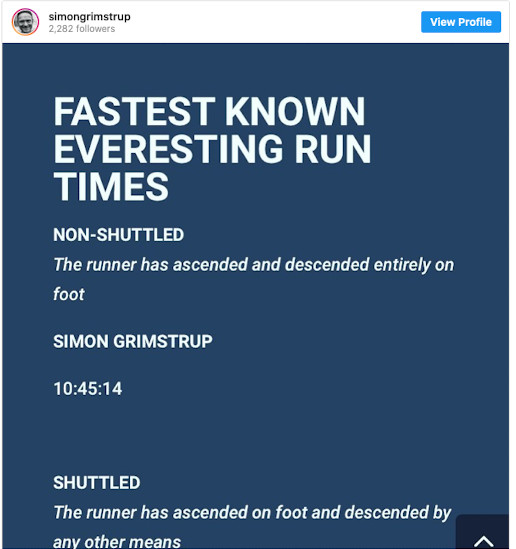
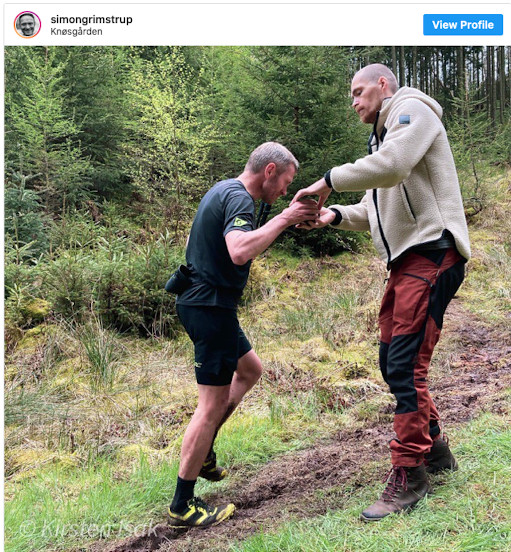
There’s also the matter of sleep, which is not allowed in Everesting attempts. While sleep is always an option for runners in long ultramarathons, it isn’t permitted for Everesting runs. If a runner takes a nap, the attempt is over. When it comes to ascending and descending the chosen hill, a runner can choose whether to run down after each lap or get a ride down (whether that’s in a car, a gondola on a bike or any other form of transportation). Because of this option, there are two separate Everesting run records: shuttled and non-shuttled.
Grimstrup’s run was non-shuttled, and he ran or walked down the hill every lap. This not only made the challenge much more difficult, as Grimstrup didn’t get the chance to rest after each ascent, but as he said in an interview with the Vietnam Trail Series (VTS), it also left him wondering if he would make it to the finish line.
“I was not sure I would get the world record until the last two laps,” he said. “I was worried that I would fall on the downhill.” Running down a steep hill (the one Grimstrup chose was 130m long and featured 44m of elevation gain) is difficult enough on tired legs, but the task was made tougher for Grimstrup due to rain. He told the VTS team that, due to the rain, he had originally planned to only run a half-Everesting attempt as a test run on the hill.
After he ran 100 laps, though, Grimstrup said his friends convinced him to keep going for the full run. He gave in, but he said the trail he followed only got worse and more torn up with each lap. Despite the sketchy terrain, he made it to the finish, beating the previous Everesting world record by 16 minutes.
“It was the hardest, stupidest, most epic thing I have ever done,” Grimstrup said.
In addition to running the Everesting attempt for the physical challenge, Grimstrup linked it to a fundraiser for Doctors Without Borders
(06/14/2021) ⚡AMPby Running Magazine
Sara Hall wins New York Mini 10k in Central Park
Sara Hall completed the New York Mini 10K with the fastest time by an American in the history of the women-only event.
Sara Hall won her second consecutive title at the Mastercard New York Mini 10K on Saturday, finishing the Central Park race in 31 minutes, 33 seconds. It was the fastest time by an American in the 49-year history of the women-only event.
Hall broke away from her nearest challengers late, holding off the Kenyan duo of Violah Cheptoo by six seconds and Monicah Ngige by 26.
“It feels so good to be back out here racing in New York City and have a real road race,” Hall said. “I’ve been looking forward to this so much. This is the momentum I needed for Olympic trials in two weeks.”
Lindsay Flanagan (32:09), U.S. Olympic marathoner Molly Seidel (32:13), and former New York City Marathon champion Edna Kiplagat (32:20) completed the top six.
Susannah Scaroni won her third straight event title in the wheelchair division, finishing in 22:44. Scaroni sprinted out early and cruised to victory ahead of flying to the U.S. Paralympic trials.
Five-time New York City Marathon champion Tatyana McFadden (25:22) was second for the third consecutive time and Yen Hoang (26:11), a college teammate of Scaroni and McFadden at Illinois, rounded out the podium.
There were about 3,000 runners in the field, the first regularly scheduled New York Road Runners race since the pandemic began.
(06/13/2021) ⚡AMPSome Veteran Pro Runners Are Making Less This Year, and They're Ditching the Sport
Many athletes are confronting a bleak financial reality. Some are quitting the sport entirely.
What do Noah Droddy, Ben True, and Andy Bayer have in common?
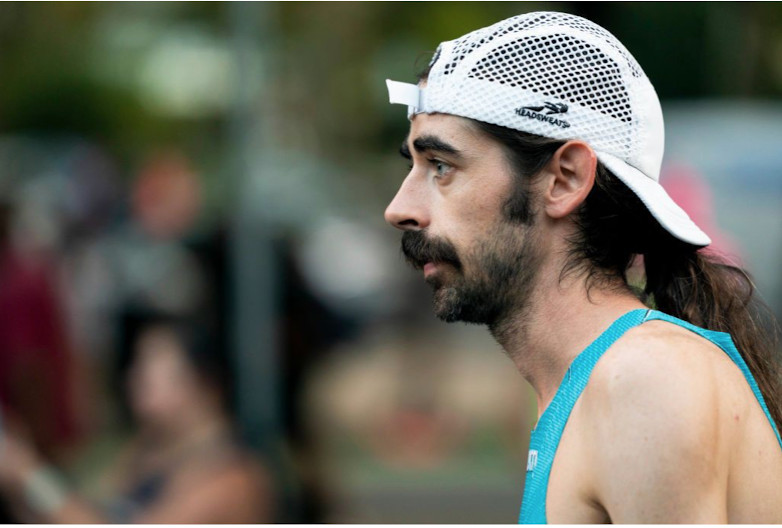
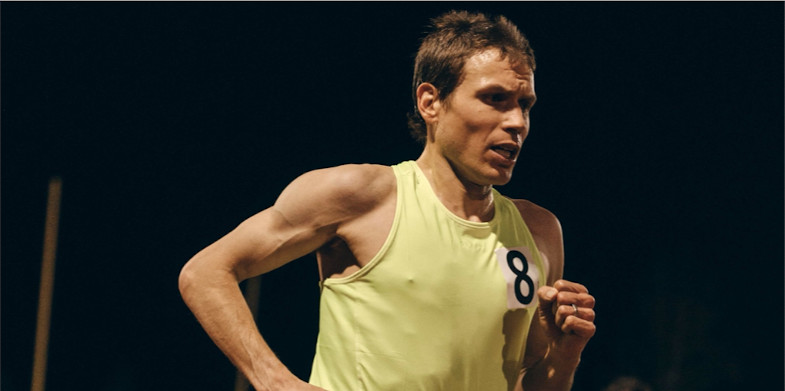
They’re all ranked among the top 10 Americans of all time in their events—Droddy in the marathon, True in the 10,000 meters, Bayer in the steeplechase.
How Much Do Pro Runners Make? For Some Veterans, It’s Less This Year
And they were all dropped by their sponsors at the end of 2020.
This news took a while to seep out—after all, athletes don’t tend to publicize it when their sponsors reduce their pay or stop supporting them altogether. But Droddy, 30, and True, 35, have been open about their status and confirmed it in calls with Runner’s World (both had been sponsored by Saucony), and Bayer told the Indy Star that Nike dropped him and he has left the sport, at age 31, for a job in software engineering.
Droddy—one of running’s most recognizable figures in races with his long hair, backward baseball cap, and habit of losing his lunch at marathon finish lines—summed up his situation in a tweet on February 19.
Is he right? Is it typical for top runners, at the height of their careers, to lose financial backing from shoe companies? Or is this an anomaly at the end of an unusual, pandemic-marred 15 months?
Runner’s World had conversations with eight athletes, four agents, two marketing employees at brands, and three coaches to get a sense of the current economics for athletes. They painted a complex picture.
Are most pro runners broke?
Many are just getting by. For years, America’s pro runners have been on shaky financial footing. With the exception of those who win global medals or major marathons, distance runners often struggle to earn enough money to pay for their essentials (rent and food), plus cover all their running-related expenses, such as coaching, travel to races and altitude camps, health care, gym membership, and massage.
Over the past year, the pandemic has erased lucrative racing opportunities. Additionally, shoe companies have been reevaluating their sports marketing budgets, from which runners are paid. Experts say that the result has been an increasing bifurcation between the sport’s haves and have nots.
The most successful, those destined for the Olympic team or starring on the roads, are earning generous base payments and bonuses for setting records or winning. Many of the rest are scraping by, with smaller contracts, if any, and they’re supplementing their shoe company earnings with jobs.
Running’s middle class, much like America’s, is shrinking.
The exception is runners who belong to a single-sponsor training group, like those in Flagstaff, Arizona (Hoka); Boston (New Balance); and Portland, Oregon (Nike). In those cases, coaching, travel, and training camp costs are absorbed by the club, easing the financial pressure on athletes and making it possible for them to pursue the dream.
Brands these days appear to be more eager to devote dollars to groups and the athletes who train with them, rather than individual athletes training on their own in different locations. That presents a quandary for midcareer runners who have achieved a level of success. Faced with the loss of a sponsorship, they aren’t always willing to pick up and move to a new town and a new coach.
What do contracts look like?
If you’re a top runner in the college ranks, and you’ve won multiple NCAA titles at the Division I level, shoe companies—Nike, Adidas, Brooks, Saucony, Hoka, and others—will usually come calling, offering more than $100,000 a year for multiple years, with a spot in a group or a stipend to pay your coach. Those companies are betting on those NCAA champions to be Olympians of the future.
Dani Jones, for instance, won three individual NCAA titles at the University of Colorado, and she signed with New Balance at the end of last year. Her agent, Hawi Keflezighi, said she entertained competing offers from other companies.
A midcareer athlete with a breakthrough performance—hitting the podium at a major marathon or making an Olympic team, for instance—might also be rewarded with a base contract worth $50,000 to $100,000.
The top sprinters earn even more (although their careers are typically shorter). Usain Bolt famously made millions, and Canadian sprinter Andre De Grasse was 21 when he signed a deal worth $11.25 million—before bonuses—from Puma in 2015, the Toronto Star reported.
The payouts drop significantly after that. Let’s say you’re a distance runner, but you haven’t been able to get a big win in college, although you’ve come close. The lucky ones are looking at deals for about $30,000 to $75,000 per year.
Your agent takes a 15 percent cut of that. And this base salary most often comes without benefits: no health insurance, no 401(k). As independent contractors, pro runners are paying all their own taxes. (In contrast, traditional full-time employees have half of their Social Security and Medicare taxes paid by the employer.)
Many young runners out of college join pro groups, and they’re not making anything beyond free gear and coaching. Others might get a stipend worth $10,000 or $12,000 a year.
The contracts typically sync with the Olympic calendar. At the end of 2020, many athletes’ contracts were expiring—even though the Olympics didn’t happen. That’s how Droddy, True, and Bayer were dropped. Shannon Rowbury, a three-time Olympian, told Track & Field News her deal with Nike was extended for one year, two if she makes the Olympic team this summer.
If an athlete has a good Olympics, the sponsoring company often has an option to extend the deal for an additional year, which includes the world track & field championships. It’s at the company’s discretion—not the athlete’s.
Parts of the sponsorship model appear to be changing, but slowly. When NAZ Elite announced a new deal with Hoka last fall, it included health insurance for the runners. Similarly, members of Hansons-Brooks in Rochester, Michigan, get health insurance if they work in the Hansons running specialty stores. And last May, Tracksmith brought Mary Cain and Nick Willis on as employees at the company—Cain in community engagement, Willis as athlete experience manager—with the plan that both would continue to train and race at an elite level.
Why doesn’t anyone know exactly how much runners are making?
As part of these deals, athletes have to sign non-disclosure agreements (NDAs), promising to keep the terms quiet. If an athlete violates the NDA, the sponsor can void the contract—or sue for breach of contract.
This is, in fact, similar to other sports. In basketball, LeBron James is being paid $39.2 million this season by the Los Angeles Lakers. But he also has an endorsement deal with Nike, and the exact structure of that is unknown.
In running, prize purses are publicized—$150,000 for winning the Boston Marathon, $25,000 for being the top American at New York in 2019, $75,000 for winning the Olympic Marathon Trials.
But as in other sports, the terms of the sponsor deals are kept mum. And appearance fees at major races, as well as time bonuses within those appearance fees, which represent a major source of income for road runners (mainly marathoners), are also mostly unknown.
Athletes feel that the silence around sponsor contracts and appearance fees puts them at a disadvantage—it’s hard to know their market value. Yes, they can—and do—have quiet conversations with peers about it. But lacking broad knowledge, they lack power.
And as a result, the industry is rife with rumors and assumptions. Athletes’ values are often inflated through the grapevine.
“I think it is very similar to the dynamic that would occur if no one knew the price of home sales,” Ian Dobson—a 2008 Olympian who ran for Adidas and Nike during his pro career, which ended in 2012—told Runner’s World. “How could you ever be confident in a sale price if you didn’t know what any other homes in your neighborhood were selling for? Granted, we don’t know every detail of every home sale in the neighborhood, but it’s certainly helpful to know in general terms the dollar amount that these are going for so that we can all understand what value our home might have.”
Also, athletes keep quiet when their circumstances change. They feel embarrassed. One athlete told Runner’s World, “No one in track wants to be the one to say, ‘I got dropped,’ or ‘I got reduced.’ It's all taboo.”
Even so, $30,000 is nothing to sneeze at—especially for a job that’s about pursuing individual goals.
No, it’s not. But not every contract is structured the same way.
Some pay that base amount, no matter what. Other contracts penalize athletes with reductions if, for instance, they don’t finish in the top three in the country in Track & Field News rankings, or if they get injured and can’t race a certain number of times per year.
That’s why numerous Nike athletes seemed to be eagerly seeking racing opportunities of any kind last summer amid the pandemic. Marathoner Amy Cragg raced a 400 meters at an intrasquad meet on July 31, and finished in 90.15 seconds—6:00 pace—presumably to check a box on her contract. On August 7, she ran 800 meters in 3:03.85. The record of those races are in her World Athletics profile.
A Nike spokeswoman, when asked about athletes racing in 2020 to meet contractual obligations, responded: “We do not comment on athlete contracts.”
Time bonuses, once seen as a reliable way to beef up athletes’ base payments, are also becoming less frequent or harder to hit, as shoe technology improves and fast times become more common, according to one agent.
What role do agents play?
For athletes who have never previously had a sponsorship deal, it’s almost impossible to secure one without the help of an agent, who can get in the door at all the major brands.
For American distance runners, there are nine main agents—all men—negotiating the deals (Keflezighi, Josh Cox, Paul Doyle, Ray Flynn, Chris Layne, Dan Lilot, Tom Ratcliffe, Ricky Simms, and Mark Wetmore). Karen Locke, one of the few female agents in track and field, represents a few distance runners among her roster of clients in field events.
Of course, all the prominent agents—who have multiple clients across multiple brands and at various stages of their athletic careers—have data about what athletes are worth. But they have a duty to each one to maintain confidentiality about the specifics of that deal.
Agents bring to their athletes a broad picture of the market and what each might command, providing advice to those considering offers: Yes, this a fair offer, a solid deal. Or no, you can do better.
They also help get athletes into competitive track races like the Diamond League and elsewhere, or into the World Marathon Majors. They can handle travel arrangements to meets and help to make sure records get ratified. Generally, their role is to go to bat for athletes, no matter what they need.
For their services, they take 15 percent of everything an athlete earns: sponsor deals, appearance fees, and prize money, no matter how small the race or winnings.
Agents are supposed to negotiate on behalf of each client individually, but athletes have no idea if that’s happening. Are they being used as part of a package deal? Thrown in at a minimal rate as a thank you to a brand for giving a generous deal to a superstar? Or, on the upside, getting a small appearance fee from a major marathon that they wouldn’t be able to get into on their own, because they have the same agent as a mega-star?
“Agents want to bring in the most money for their combined athletes—if they manage 20 athletes, they’re trying to bring in the maximum money they can across 20 athletes,” one athlete told Runner’s World. “That doesn’t necessarily mean they’re trying to maximize for each individual. The difference between earning $20,000 a year and $30,000 a year is profound in terms of your ability to actually train as a professional. But it translates into a small amount [$1,500] for the agent.”
Why is the market tricky right now?
The pandemic caused upheaval in marketing budgets. Also, the people who work in marketing at shoe brands can be inexperienced in the running industry, and turnover often runs high at those positions, jeopardizing relationships between athletes and brands that have lasted years.
The marketing budget questions are not limited to running, said Matt Powell, a sports business analyst and vice president for NPD.
“I think brands are taking a more circumspect view of endorsement contracts in general—whether it’s teams, leagues, or individual athletes,” he said. “They’re [questioning whether] they’re getting the return on that investment.”
Nike is rumored to have cut its marketing budget for running, amid layoffs at the company. Nike did not return an email from Runner’s World seeking clarification on the budget or the numbers of runners it currently sponsors.
Although Nike’s superstars are said to be fine and not facing any reductions in their deals, one Nike athlete, a 2016 Olympian, told Runner’s World, “It’s pretty much assumed that everyone is getting less.”
And it’s believed that several of these contracts are for shorter periods of time than they might have otherwise been: through the world championships in 2022 in Eugene, Oregon, instead of through the next Olympics in 2024.
In answer to questions from Runner’s World about True and Droddy—as well as rumors about a new Saucony-sponsored training group—Saucony responded with an emailed statement from Fábio Tambosi, Saucony’s chief marketing officer:
“At Saucony we believe you cannot have a sports brand without the inclusion and authentic connection with athletes. We are excited about the evolution of Sports Marketing as a brand pillar for years to come, and remain committed to building an athlete strategy that aligns with this goal.” 

Good news abounds, too
On the positive side for distance runners, Puma has re-entered the distance running market. Molly Seidel was lured from Saucony to Puma, and Aisha Praught Leer told Women’s Running she signed a “big girl contract” with Puma. Additionally, the company started a group in North Carolina, coached by Alistair Cragg and with three athletes so far.
The shoe company On has also invested heavily, starting a new team in Boulder, Colorado, coached by Dathan Ritzenhein and with athletes like Joe Klecker and Leah Falland.
Keira D’Amato, 36, signed her first pro contract, with Nike, after a string of impressive performances during the pandemic on the track and roads. She has kept her job as a realtor.
Keflezighi sees an opening for apparel brands that don’t have footwear to sponsor more athletes. Women’s apparel company Oiselle has done this for years, and Athleta is now sponsoring Allyson Felix. Could a menswear company be far behind? These arrangements leave athletes free to choose their own running shoes, which can be advantageous as shoe technology advances so quickly.
Why do brands have pro runners anyway?
Beyond the individual dollar amounts in contracts, brands seem to be rethinking what the role of a professional athlete is. Is it to inspire with performances, and hope those performances translate into shoe sales? Or is it to connect with fans on social media and promote product sales that way?
“You have to kind of look at it big picture,” True told Runner’s World. “These companies aren’t giving athletes money for charity; they’re doing it for a marketing investment and they’re looking for a return on their investment. And currently—and this is not ideal, in my mind—you look at the rise of social media and influencers. They are very inexpensive for marketers to go after and they get their products in front of a lot of eyeballs.”
A 2:20 male marathoner who also has a drone and a great Instagram account or YouTube channel might be gaining followers, True said, while a 2:05 marathoner is training hard and devoting his craft toward the next race.
“The average person, they don’t understand that 15-minute difference,” he said. “One historically will cost that company a lot of money. The other does not cost much at all and will get a whole lot more eyeballs on the product. You have to understand that.”
In his nine years with Saucony, True, training on his own in Hanover, New Hampshire, was part of only one ad campaign the company ran. The company preferred to use models for its ads and catalogs.
In February, True ran 27:14 for 10,000 meters, a personal best and faster than the Olympic standard. He wore Nike spikes and a plain yellow singlet. If all goes according to plan, he’ll race the U.S. Olympic Track and Field Trials in June and try to make his first team. His wife, professional triathlete Sarah True, is pregnant and due in July. And after that, he’ll run a fall marathon. True intended to debut at the marathon last fall, before the pandemic canceled all the races.
He’s moving ahead and training hard, despite the financial uncertainty. “I would have loved to have spent my entire career with Saucony,” he said. “I very much enjoyed working with them. I’ve been fortunate enough that I have had probably a lot more support than many other people in my position. That’s been nice.”
At this point, he is hoping another company will pick him up to take him through the next few years. “If a company just gave me a bonus structure that is fair for the result, I’d be happy with that,” he said. “It’s not like we’re looking for huge amounts of money. I’m very pragmatic and very realistic. I don’t think you should be paid for potential; I think you should be paid for results.”
(06/13/2021) ⚡AMPby Runner’s World
Olympic organizers estimate 225,000 fans per day at Tokyo venues
The Tokyo Olympics and Paralympics organizing committee said Friday it has sold tickets for 42 percent of the venues' capacity and expects to see up to about 225,000 spectators per day in the Japanese capital if all ticket holders attend.
With the organizers set to draw up a plan this month on what to do regarding domestic spectators, Hidemasa Nakamura, the committee's games delivery officer, suggested the risk of having spectators could be limited, given that the number of ticket holders set to enter venues is estimated to be smaller than those visiting or commuting to the capital.

Speaking at a press conference, Nakamura said 70 percent of the tickets for events taking place in Tokyo and neighboring Chiba, Saitama and Kanagawa prefectures have been sold to people living in those areas.
The Japanese organizers and the International Olympic Committee have waited to decide on venue capacity for spectators in Japan after barring fans from overseas. However, medical experts have expressed concern that allowing fans could lead to the spread of the coronavirus as people travel to and from the venues.
On Friday, infectious disease expert Shigeru Omi, Japan's top COVID-19 adviser who has been critical of staging the Tokyo Games, told a parliamentary committee he will assess the risk of allowing spectators.
Omi, who heads a government subcommittee on the coronavirus, said the public will most likely be asked to follow anti-virus mitigation steps, including refraining from traveling to other prefectures, during the Olympics as they coincide with summer vacation.
With about 40 days to go before the Olympics opening ceremony, Tokyo has been under a state of emergency since late April to bring down the number of infections. Omi has said he plans to put together recommendations on staging the Olympics by June 20, the final day of the emergency.
Separately on Friday, Tokyo Gov. Yuriko Koike said a vaccination center will be set up at the metropolitan government building to inoculate officials and workers related to the Olympics.
About 2,500 shots will be administered per day starting June 18 to referees and staff working at games facilities including the athletes' village, Koike said.
The center will use Pfizer Inc. vaccine doses provided by the IOC for Japanese athletes and officials related to the games.
(06/13/2021) ⚡AMPDouble delight for Mu, Sturgis and Cockrell on final day of NCAA Championships
US teenager Athing Mu wrapped up her 2021 collegiate season with a pair of record-breaking performances on the final day of the NCAA Championships in Eugene on Saturday (12).
The Texas A&M student, who is undefeated outdoors over 400m and 800m this year, opted to focus on the shorter event in Eugene. After a comfortable 51.04 heat victory on Thursday, she dominated the final and won by more than a second, breaking her own collegiate and North American U20 record with 49.57.

Fellow U20 runner Talitha Diggs, representing the University of Florida, finished second in 50.74, while Canada’s Kyra Constantine of USC was third in 50.87.
“I’m really happy to win; I’ve been dying to have the 400m title since the indoor season,” said Mu, whose only loss this year came at the NCAA Indoor Championships.
Just 80 minutes after winning the individual 400m title, Mu teamed up with Tierra Robinson-Jones, Charokee Young and Jaevin Reed to win the 4x400m in a collegiate record of 3:22.34. Mu’s anchor leg of 48.85 is the fastest split ever recorded at the NCAA Championships.
“It’s amazing,” said Mu. When we checked in, I said, ‘we’re going to get the collegiate record’ so we knew it was coming.”
Mu, who turned 19 earlier this week, will now turn her attention to the US Olympic Trials, where she’ll be among the leading contenders over 800m, having clocked a North American U20 record of 1:57.73 earlier this year.
“I’m glad to be moving back to ‘my’ race (the 800m) for the trials,” she said. “I just want to go out there and try my best and hopefully make the team.”
Mu was one of three women to win two titles on Saturday.
Cambrea Sturgis of North Carolina A&T State University produced the performances of her life to win the 100m and 200m double. She blasted out of the blocks in the 100m and, despite the best efforts of USA’s Twanisha Terry, could not be caught, flying to a marginally wind-assisted 10.74 (2.2m/s). Terry, the world U20 silver medallist, was second in10.79 while Tamara Clark (10.88) and Kemba Nelson (10.90) were next across the line.
Clark was Sturgis’s toughest opposition in the 200m. Clark, a student at the University of Alabama, got off to a strong start and was slightly ahead of Sturgis as they came off the bend. But the diminutive Sturgis, drawn two lanes outside of Clark, clawed back the deficit in the closing stages and crossed the line in a lifetime best of 22.12 (0.2m/s). Clark was second in 22.17 while Anavia Battle of Ohio State was third (22.42).
Anna Cockrell, the 2016 world U20 400m hurdles champion, became just the second woman in collegiate history to win the hurdles double at the NCAA Championships. She took the 100m hurdles title in 12.58 (0.4m/s) after setting a PB of 12.54 in the heats. Collegiate leader Tonea Marshall ran 12.48 in the heats but withdrew from the final.
Just 45 minutes later, Cockrell was back on track for the 400m hurdles. The USC student ran a controlled race and negotiated the barriers well, cruising to a 54.68 PB to win by more than a second. Arizona’s Shannon Meisberger took the runner-up spot in 55.70.
Texas A&M’s Tyra Gittens secured a full set of medals. The all-rounder from Trinidad and Tobago had placed second in the long jump on Thursday, then went on to dominate the heptathlon on Friday and Saturday, winning with 6285 to beat Miami’s Michelle Atherley by 218 points.
In between the last two disciplines of the heptathlon, Gittens contested the high jump and finished third with 1.87m in a competition won by Rachel Glenn with 1.93m.
The women’s steeplechase proved to be one of the closest and most exciting races of the championships. Mahala Norris of the Air Force Academy was in third place as she approached the final barrier. Despite losing some momentum, she managed to regain her stride to outkick Auburn's Joyce Kimeli and Washington's Katie Rainsberger to win in a big PB of 9:31.79. Kimeli finished just 0.05 behind with Rainsberger taking third in 9:32.12.
Elsewhere, Dutch thrower Jorinde van Klinken, representing Arizona State, won the discus with a final-round throw of 65.01m, breaking the championship record in the process. And North Carolina State’s Elly Henes won the 5000m in 15:28.05, 30 years after her mother and coach Laurie won the title.
(06/13/2021) ⚡AMPby World Athletics
Kenya's Faith Kipyegon thinking about a Tokyo double
Fresh from breaking her own 1,5000m Kenyan record at Florence Diamond League, in Italy, on Thursday, Faith Chepng’etich is spoilt for choice on which races to run at the Tokyo Olympic Games beckon.
Chepng’etich, who is the reigning Olympics 1,500m champion, has the liberty of either defending her title or going for 800m honours at the Tokyo Games due on July 23 to August 8 at the Japanese capital.
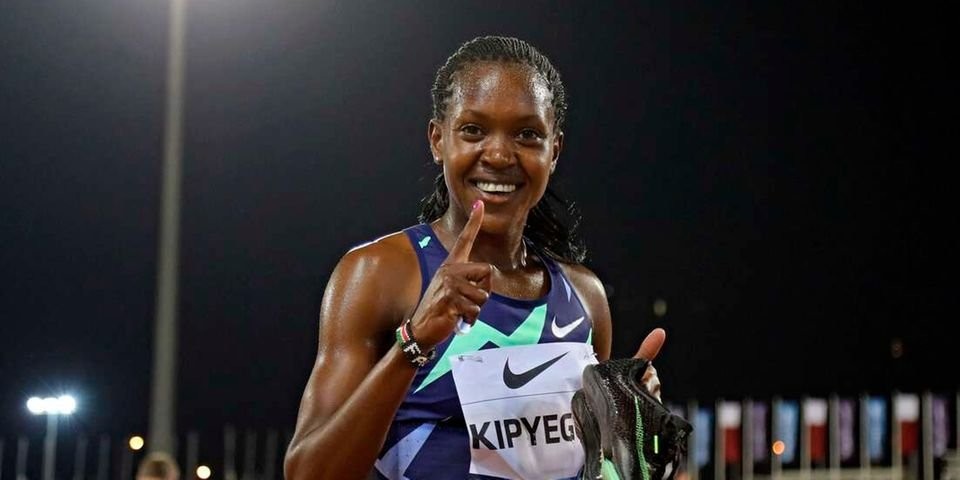
Pundits are also floating another idea of the world 1,500m silver medallist doubling up in 1,500m and 800m in Tokyo.
Incidentally, Kenya won its maiden medal from the Olympics through Wilson Kiprugut at the 1964 Tokyo Games in the 800m.
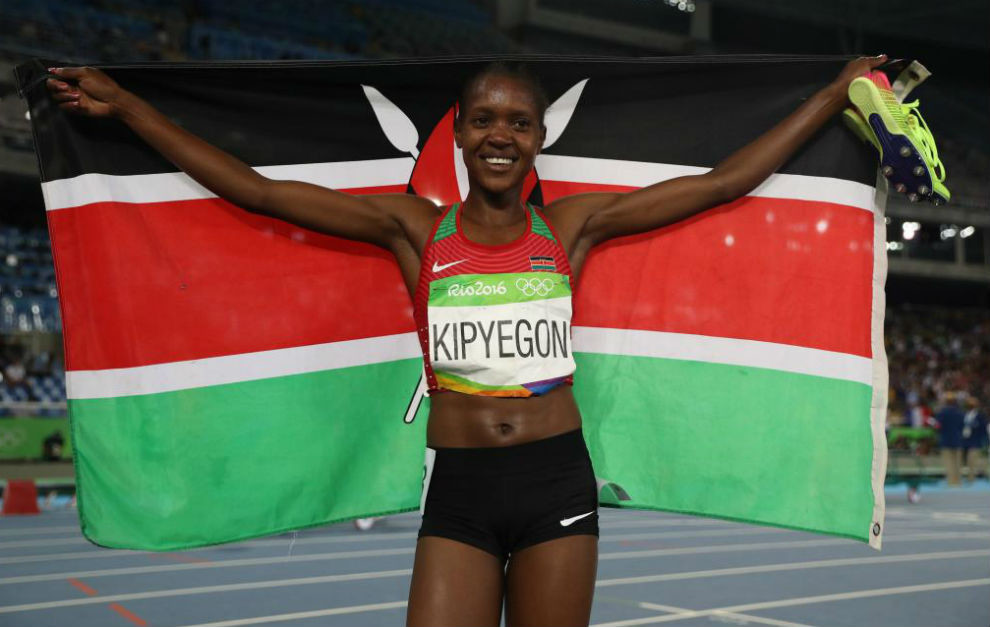
“It poses something to think about and I am yet to decide,” said Chepng’etich when asked whether she will consider doing a double in Tokyo.
Chepng’etich cruised to a Kenya record time of three minutes and 53.91 seconds to finish second behind Sifan Hassan from the Netherlands in Florence.
“It was a good race and it gives me a hint on where to work on with my coach,” said Chepng’etich, who had attained the Tokyo Olympics qualifying standard with a winning time of 1:58.26 at the Doha Diamond League on May 28.
Hassan, who had freshly set a short-lived new world record in 10,000m at her home country, clocked a world lead and meet record 3:53.63 in what was a replica of the 1,500m final at the 2019 World Championships in Doha.
It was at the world event where Chepng’etich claimed a national record of 3:54.22 in 1,500m after settling for silver as Hassan won in a European and Netherlands record of 3:51.95.
Running both the 1,500 and 800m will be tricky for any athlete.
The 800m heats will be held July 30 followed by the semi-finals the following day and the final on August 3. The 1,500m heats will be staged on August 2 followed by the semis on August 4 and final on August 6.
(06/12/2021) ⚡AMPby Ayumba Ayodi
Tokyo 2020 Olympic Games
Fifty-six years after having organized the Olympic Games, the Japanese capital will be hosting a Summer edition for the second time, originally scheduled from July 24 to August 9, 2020, the games were postponed due to coronavirus outbreak, the postponed Tokyo Olympics will be held from July 23 to August 8 in 2021, according to the International Olympic Committee decision. ...
more...Makenna Myler has always been a great runner, and she didn't let pregnancy slow her down
In October 2020, Utah runner Makenna Myler made headlines after dropping a 5:25 mile at nine months pregnant. A little over a week later, she gave birth to her daughter, Kenny-Lou, and by April of this year, Myler was back, not just running, but racing. Since giving birth, she run four races, hit three PBs and qualified for the U.S. Olympic Trials in the 10,000m. While one would assume Myler received nothing but support throughout the past year, that’s not the case, and she has faced criticism ever since her 5:25 mile last fall.
The mile
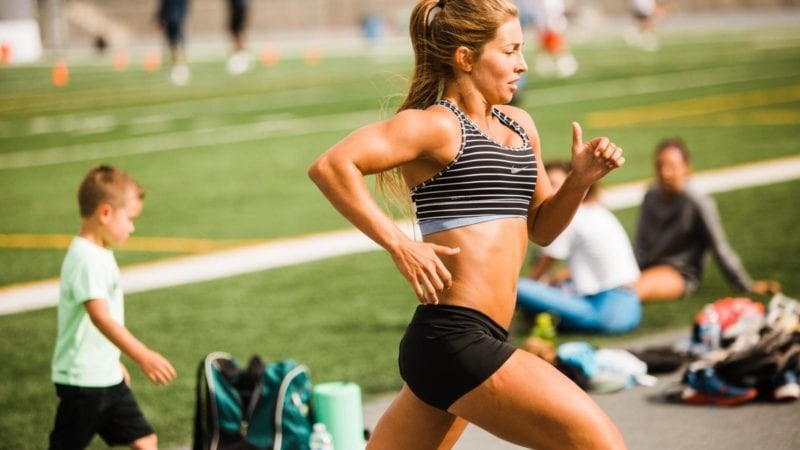
The morning of Myler’s wedding, she ran a mile. She says it only made sense to do so, as she officially became a Myler later that day when she married her husband, Mike. After her wedding day run (which she completed in 4:45), she decided to make it a tradition to run an all-out mile at significant times in her life. When she got pregnant, Myler told her husband she would run a mile in the final month of her pregnancy.

“I said, ‘Mike, I think I could run a seven-minute mile,’” Myler says. “He laughed and said he thought I’d pee my pants and have the baby right there if I did that.” Mike proceeded to bet Myler that she wouldn’t even break eight minutes, and with the challenge set, she got to work.
“Initially when you get pregnant, your times just absolutely slow down,” Myler says. “You think it’s going to be this straight trajectory of slowing down because you’re so tired, but your energy picks up later.” As her pregnancy progressed, Myler’s training continued to go well, and by the nine-month mark, she was ready to put her fitness to the test. She ran a mile time trial, shattering the bar of eight minutes that Mike had set months earlier, and her 5:25 result (which Mike shared in a video on TikTok) went viral.
Facing the critics
Most people who saw Myler’s run were in awe, and the overwhelming response was positive. However, like most things online, some people viewed Myler’s run in a negative light, and they took it upon themselves to tell her how wrong she was to run while pregnant.
“At first I was surprised,” she says. “I thought people understood that it would be OK, but you realize people haven’t done the same research you’ve done.” Before embarking on her pregnancy running journey, Myler consulted multiple doctors, one of whom has worked with many elite female athletes. That doctor gave Myler simple advice, telling her to listen to her body, just as she had in her entire career as a runner.
“I was a little offended at first when I saw the comments online, but we had a good laugh about it and kind of embraced it a bit more,” Myler says. “We realized these people don’t know me at all and they’re judging me off a two-second video.” Despite the fact that Myler gave birth to Kenny-Lou, who is healthy and was in no way affected by her mother’s training, that negativity and the criticism hasn’t stopped, but Myler says she wasn’t surprised by it this time.
“I was ready for the negativity,” she says. “I’ve received a lot of body image comments that weren’t super positive, and others on me coming back too fast. I kind of expected them.” She has even had people comment on her Instagram posts bashing Mike, as they seem to have themselves convinced that he’s forcing her to train as hard as she does.
“People don’t think I’m this intense person and instead they think that my husband is driving the whip,” she says with a laugh. “No, this is my decision and he’s just been so supportive through it all.”
Running as a new mom
Myler has run a mile, two 5,000m races and a 10,000m so far this year. The mile was at BYU, Myler’s alma mater, but she says she didn’t treat it as a race, and it was more of a workout. The two 5,000m races were in California, and she broke her PB on both occasions, first running 15:45.48 in mid-April and then bettering that with a 15:34.36 finish a month later.
Finally, her most recent race came at the end of May at the Portland Track Festival. There, she ran her 10,000m PB of 32:03.62, a time well under the U.S. Olympic Trials standard of 32:25.00. The Trials will be her next race, she says, and she hopes to spend the next while trying to “sneak in a little more fitness” before the June 26 event.
It’s easy to look at Myler and think that she’s special — that she was a great runner before pregnancy and that’s the reason she managed to train so consistently throughout those nine months and get back to running so soon after giving birth. But that’s not the case, and she says she believes that every mother-to-be and new mom can do what she has done.
(06/12/2021) ⚡AMPby Ben Snider-McGrath
Are you faster than Colin Farrell?-How does your marathon time compare to the Hollywood actor’s?
How does your marathon time compare to Hollywood legend Colin Farrell's?
Farrell took part in the Brisbane Marathon last weekend, placing 222nd out of 683 total participants, with a not at all shabby time of 03:53:14. The race was reportedly the Irish actor’s first marathon.
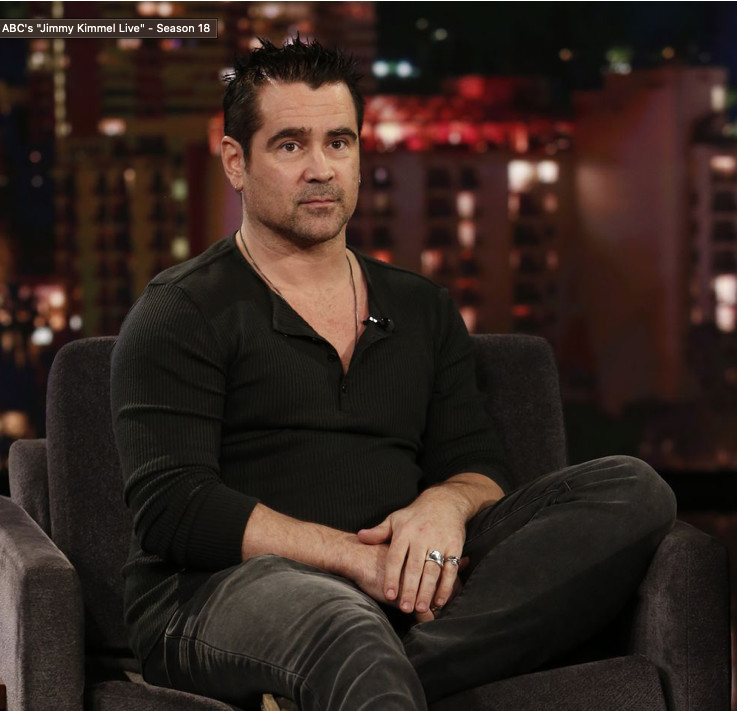
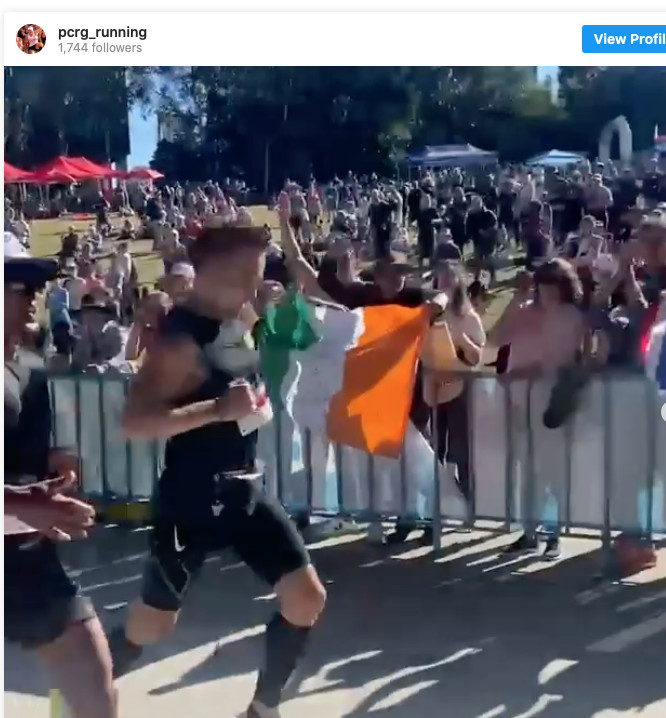
Pat Carroll, one of the event’s MCs, told Australia’s NCA NewsWire that Farrell was relatively new to running: 'His security guard told me he'd only been running for three months in preparation so it's not a bad effort,' he said.
According to Carroll, Farrell’s security requested that his participation in the race be kept quiet, although they did approve a bit of fanfare as he approached the finish line. 'I was talking to his 24/7 security guard while he's been in Australia, and I asked if we could go a bit crazy when he came down the finish line and he said: "Okay" so that's why we gave him a bit of a reception as he came down the home straight,' Carroll said.
In a video posted to his Instagram page, Carroll is heard saying: 'Ladies and gentlemen, Colin Farrell is entering the home straight. Let’s give it up for Colin Farrell, famous Hollywood actor.'
He added that another MC asked Farrell for a chat following the race, but he declined. Carroll said: 'His exact words were: "Nah, I'm knackered", which is understandable when you've just run a marathon.'
Farrell did pose with fans for pictures after the race, however. Instagram user @lettuceloveyou posted a picture with Farrell, saying, 'What a bloody buzz that experience was. It’s safe to say I might do another'.
Farrell is currently in Australia filming Thirteen Lives, a Ron Howard-directed drama about the 2018 Tham Luang cave rescue in Thailand. Actor Viggo Mortensen, who is also starring in Thirteen Lives, came along to cheer Farrell across the finish line with an Irish flag in hand, Carroll told NCA NewsWire.
(06/12/2021) ⚡AMPby Runner’s World
British runner breaks Backyard Ultra world record
John Stocker ran 337 miles in 81 hours at the Suffolk Backyard Ultra event this weekend
A British ultrarunner has broken the Backyard Ultra world record.
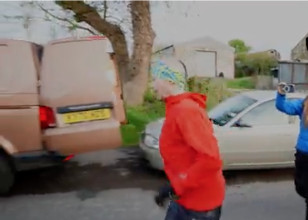
John Stocker, from Oxfordshire, ran more than 337 miles in 81 hours at the Suffolk Backyard Ultra beginning on Saturday.
Runners taking part have to complete a 4.167 mile lap of Suffolk’s Knettishall Heath every hour until they can’t carry on any longer. Participants must arrive back to the start in time for the next loop or they are knocked out.
According to race organisers, Stocker and fellow runner Matt Blackburn both beat the previous record of 312.5 miles in 75 hours, set by Belgian Karel Sabbe at Big’s Backyard last October. Sabbe told Runner’s World last year that his secret to resting was to 'give into sleep deprivation', turning his headlamp low and walking with his eyes closed so that he was ready for sleep by the time he returned to base.
Stocker and Blackburn both completed 80 laps, before Blackburn pulled out during the 81st lap. As no winner would be declared if he did not complete the lap, Stocker continued to run, completing the lap in 52 minutes, his slowest time.
That final lap was particularly difficult, Stocker told Runner's World. As he came out of the 'Spooky Woods' area of the course, he tripped and landed hard on his ribs. He thought he had "just lost it all", he said, before his resolve hardened. "I knew I just had to finish no matter what."
He said: "You could say the whole race flashed before my eyes, but with every small step I started walking along the road, then limping and onto running towards the finish and the win."
Race director Lindley Chambers told the BBC: 'What these guys have achieved is pretty incredible.'He added: 'I knew we had the calibre of people taking part and I personally thought we'd do 50 or 60 loops but these guys have gone beyond my expectation and have gone further than anyone else in the world competing in this format.'
Stocker and Blackburn reportedly completed each lap in around 45 to 50 minutes, leaving 10 to 15 minutes after each lap to rest and refuel before heading out for the next lap.
American runner Courtney Dauwalter told the BBC why this race format appealed to her in April: 'It’s a fun mental challenge,' she said, adding that backyard ultras are about 'finding out what’s possible rather than a race that you want to win. If we don’t limit ourselves, it’s pretty cool what can happen.'
(06/12/2021) ⚡AMPby Runner’s World
Timothy Olson Is Attempting a FKT on the PCT-The record he needs to break? 52 days
Ultrarunner and Adidas Terrex athlete Timothy Olson will attempt to set a fastest known time (FKT) on the 2,650-mile Pacific Crest Trail, starting at the California-Mexico border and finishing at Washington-Canada border. His goal? Break the current FKT of 52 days and change.
Timothy is a two-time winner and former record holder of the Western States 100-Mile Endurance Run. But he has a special connection to the Pacific Crest Trail, sections of which he’d run from his house in Ashland, Oregon, where he began his ultrarunning career a decade ago. Timothy has been training to set a FKT on the PCT for two years (last year’s attempt having been postponed by the COVID-19 pandemic). A self-professed “lover of life and explorer of nature,” Timothy’s goal on the attempt is to “live consciously” as he runs through the mountains. “I’m not trying to conquer nature,” he says. “I’m trying to move through and appreciate it.” Timothy wants his effort to be a celebration of our post-pandemic return to life. “I see this as a time for us all to reemerge from our cocoons,” he says. “I want to set a marker for what is possible.” Here's what he's up against—and how we plans to tackle it section by section.
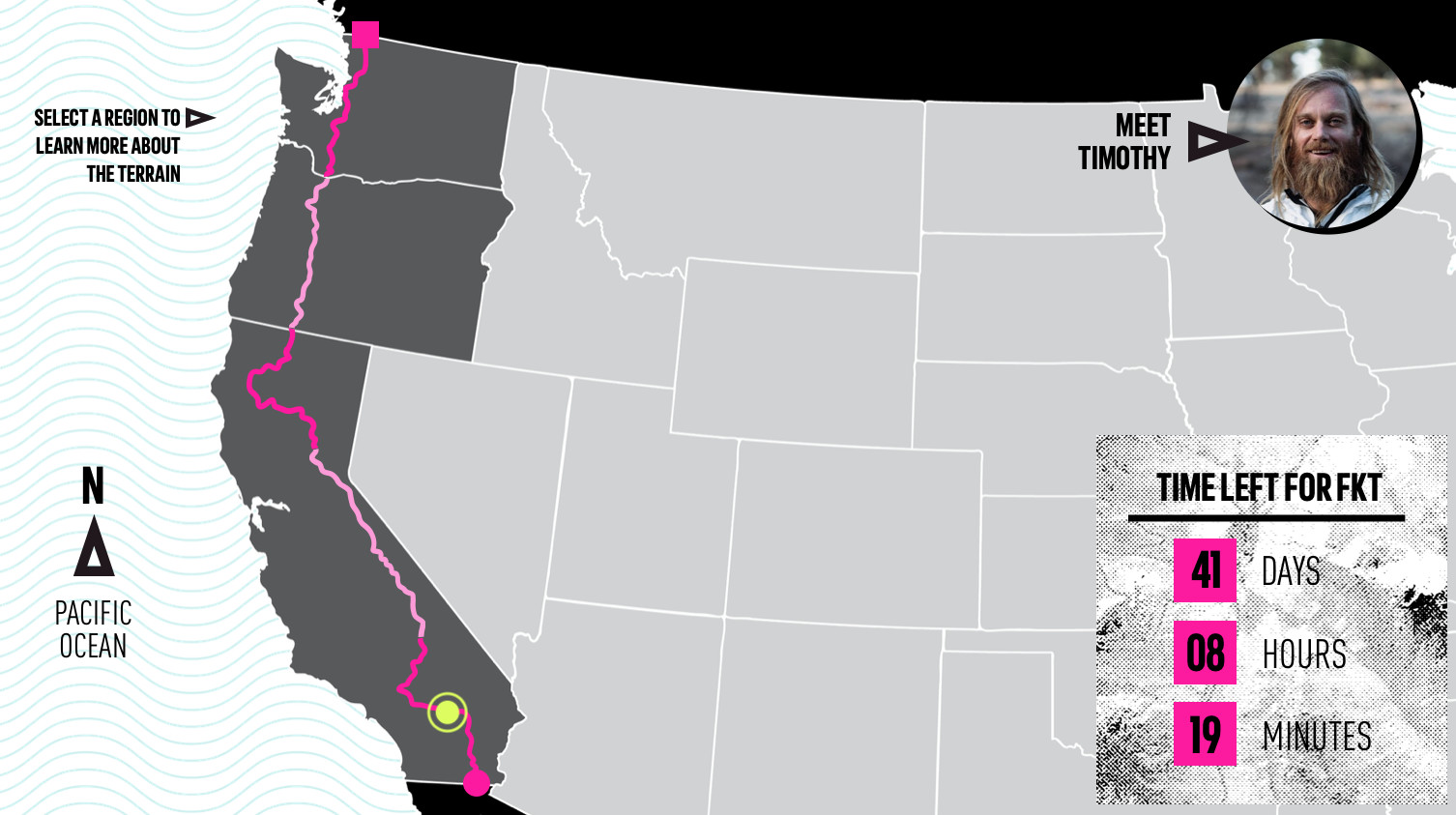
Region 1: Southern California
Campo to Walker Pass: Miles 0-652
The southern terminus of the PCT is near the aptly named California town of Campo. A shoulder-high monument a few yards from the wall marking the Mexican border is the official starting point. From there, the trail forges north through the Sonoran Desert, through the Laguna Mountains and into the Mojave. Daytime temps here can spike to the hundreds in June, so Timothy plans on predawn starts. And because there can be up to 30 miles of trail between water sources, he will rely on midday water resupplies from his team at road crossings and trailheads.
Region 2: Central California
Walker Pass to Donner Pass: Miles 652-1,157
From Walker Pass, near the town of Kernville, the trail dips to the South Fork of the Kern River, the geographic start of the Sierra Nevada. Arguably the PCT’s most difficult section, the trail through the High Sierra spends considerable time above 10,000 feet, includes eight passes over 11,000 feet, and peaks at 13,153-foot Forester Pass, the PCT’s high point. Timothy calibrated his early-June start time to reach the High Sierra when most of the snow should be melted, so he won’t have to lug heavy gear like crampons and ice axes. The crux of his effort will be the remote section from Sequoia National Park through Yosemite National Park, where the PCT merges with the famously majestic John Muir Trail for 160 miles. Timothy likely won’t see his resupply team for several days in this section.
Region 3: Northern California
Donner Pass to Oregon Border: Miles 1,157-1,689
This Northern California section begins where Interstate 80 crosses Donner Pass and continues through the High Sierra, but then gives way to the drier volcanic peaks and plains of the southern Cascades. From there to the Oregon border, the skyline is dominated by the Mount Shasta stratovolcano. Three to four weeks into the six-week effort, Timothy will need to listen to his body to stave off overuse injuries; he may have to sleep an extra hour or two or shorten his days to let his feet, knees, or shins heal. But with his experience and abilities, says coach Koop, “he can be three days off the record in this section and make it up in a single day.”
Region 4: Oregon
California Border to Washington Border: Miles 1,689-2,144
The easiest section of the trail, the PCT through Oregon contains fewer significant elevation changes, though the route is no less stunning, winding through old-growth forests, skirting alpine lakes, and connecting snowcapped volcanoes—including Mount Washington, Mount Jefferson, and the iconic Mount Hood—that dominate the skyline. But while the run should be easier physically, Timothy will likely be getting trail weary by this point. That’s where meeting up with his family at trailheads and road crossings will be a boost. “A hug from [my son] Kai and I’ll be energized to run all day,” he says.
Region 5: Washington
Washington Border to Canadian Border: Miles 2,144-2,650
Beginning at the trail’s lowest elevation, the Bridge of the Gods (180 feet) over the Columbia River, the Washington section rises past the talismanic peaks of mounts Adams and Rainier and then northward into the rugged and remote north Cascades, probably the PCT’s second most difficult section. In addition to presenting extreme elevation gains and losses and intense, dangerous river crossings, the north Cascades can be the PCT’s wettest section, with frequent summer storms that should test Timothy’s resolve and gear. “I’ll go several consecutive 60- and 50-mile days without seeing my crew—and may arrive at the border alone if the access from Canada is still closed.”
(06/12/2021) ⚡AMPby Outside On Line
Dina Asher-Smith aims for new peak in Tokyo
Dina Asher-Smith had just reached the peak of the mountain when she was plunged into the unknown.
Fresh from her triumph in the 200m, and a silver medal in the 100m, at the 2019 World Athletics Championships in Doha, where she was confirmed as one of the fastest women in the world, Asher-Smith had just begun her run into the Tokyo Olympic Games in 2020 when the whole world came to a screeching halt, her and her sport included.
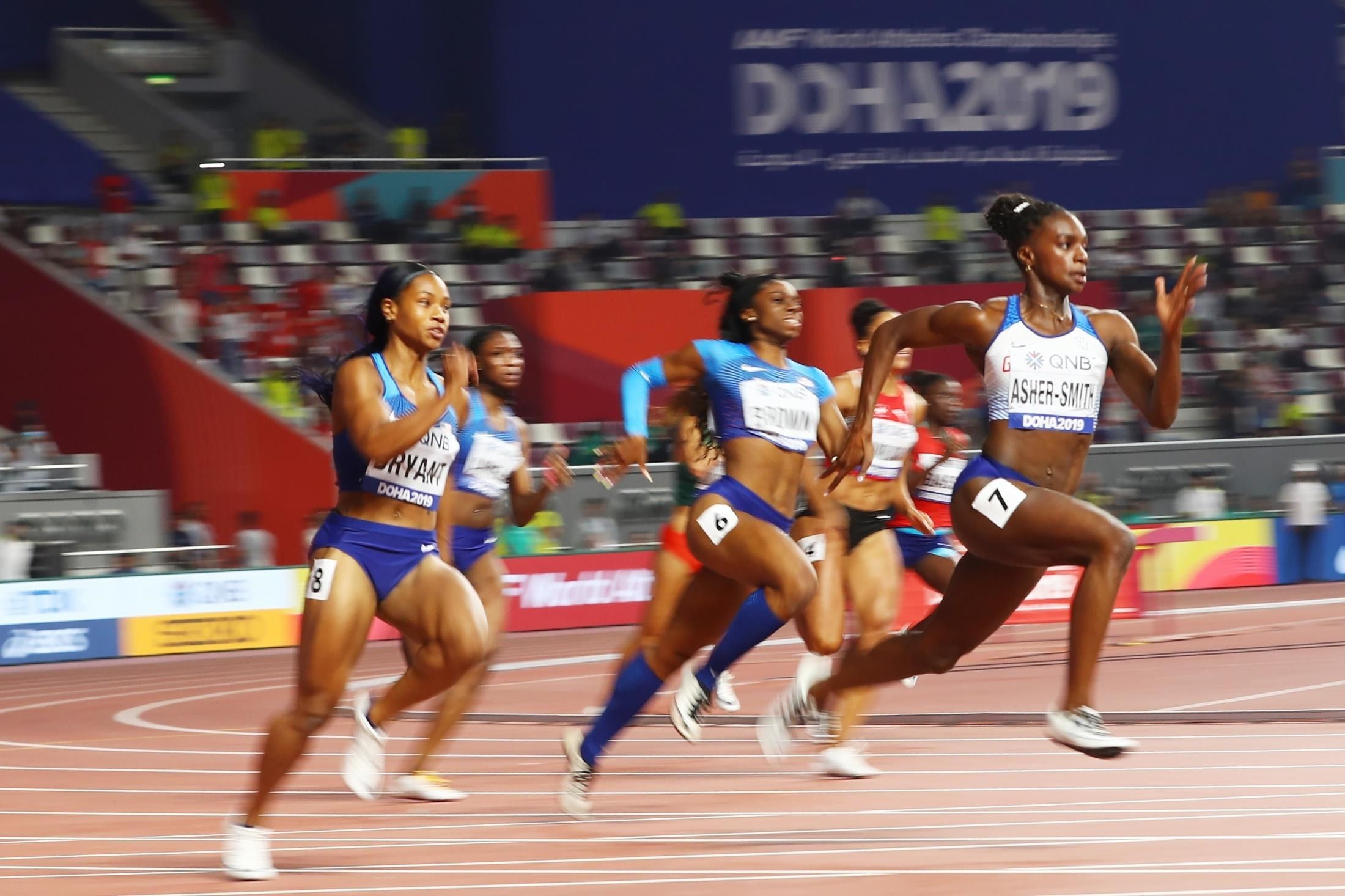
The 25-year-old Londoner could never have imagined voluntarily sitting out a year of international competition before the pandemic hit but that is what she elected to do when the world changed in March last year.
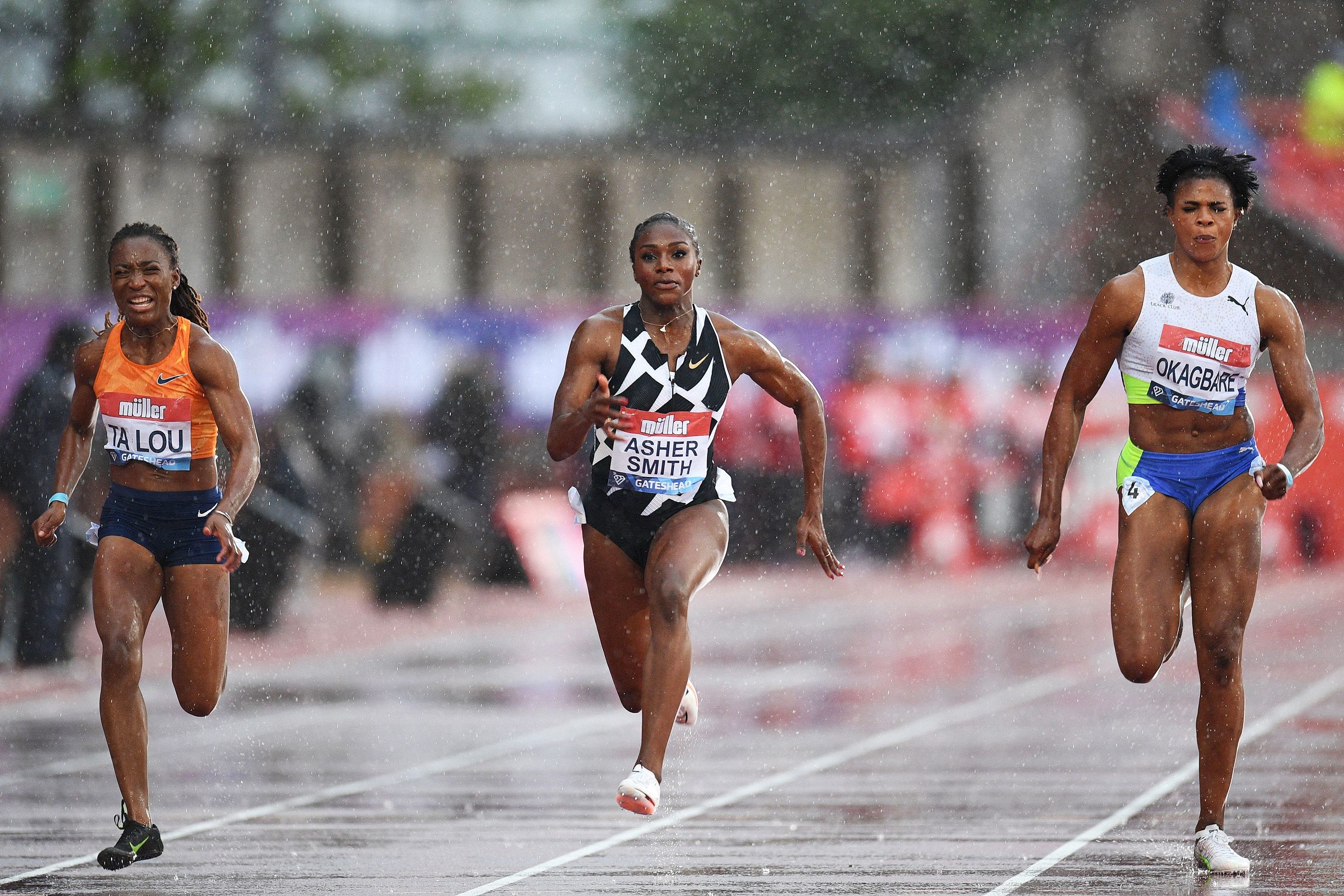
"We were in a situation that nobody around the world has been in before and I know that I was no different from anyone else," she reflected, after a triumphant return to the 200m in the Wanda Diamond League in Florence on Thursday (10).
"Every day I was worried for my parents’ health, my grandparents’ health. With that in mind, I was thinking, is it right for me to be bouncing around the world and doing that? I don’t know. That was my emotional frame.
"But also, from a more athletic point of view, we just saw it as: Okay, the Olympics have been postponed. If you had been given, or were forced, to have an extra year (of preparation), what would you do? For us, it was to get stronger, it was to improve my technique, it was to improve my mentality, my nutrition, my sleep, everything. So we really used the time to go up another level and I really hope that I can perform and show that’s what I was doing."
Asher-Smith admits it felt more like a risk than an unexpected gift at the time, stepping away from the known path to glory, sitting out while her rivals returned to racing in the latter part of last year. But she and her coach John Blackie believed it was the right approach for her and she trusts that the benefits will show when she finally arrives in Tokyo next month.
So far, it looks like a good decision.
Asher-Smith returned to the international scene last month, running, and winning, the 100m at the Gateshead Diamond League meeting against a stacked field that included the new American threat Sha’Carri Richardson and the dual Olympic champion Shelly-Ann Fraser-Pryce, and in appalling weather.
"You have to take the good performances when they come, so I was really happy to do well and do well in front of a home crowd," she said afterwards.
"I think psychologically it was good that I was able to focus in the circumstances - the fact that it was my first 100m, the fact that it was at home. It was suddenly a very big race for my first 100m against some incredibly talented women with some incredibly fast PBs, some incredibly fast times already run in the season and then the weather. I was just happy that despite all of those things happening in the background I was just able to focus on me and perform the way that I wanted to, at the end of the day."
She found better conditions at the FBK Games in Hengelo, a World Athletics Continental Tour Gold meeting, last week, where she registered her first sub-11 second clocking (10.92) of the season, before turning her attention to the 200m in Florence.
At the press conference before this meeting, she confessed she still felt a little race rusty, but it didn’t show as she dominated an international field to win in 22.06, just a touch slower than Shaunae Miller-Uibo’s world-leading time of 22.03 for this year.
"My team and I know I’m in good shape and I’m happy to come out and run that today but I know I can go quicker so I’m excited to be able to go again," she said.
What is already clear is that she will need to be better than ever to triumph in Tokyo. Richardson set the early season pace with a 10.72 clocking in April, then Fraser-Pryce blasted to 10.63 in Jamaica last week, the fastest time in the world for more than 30 years.
The British Championships and Olympic trials (June 25-27) are next on Asher-Smith’s agenda and then she has more international racing lined up, finishing with the second Diamond League meeting to be held in Gateshead on July 13, to bring her to a new peak in Tokyo.
(06/12/2021) ⚡AMPby World Athletics
Jakob Ingebrigtsen sets new European 5000m record
A 12:48.45 by 20-year-old Jakob Ingebrigtsen from Norway takes down a loaded men’s 5,000m field in Florence Italia and he records a new European record in the process!
2. Hagos Gebriwhet 12:49.02
3. Moh Ahmed 12:50.12
4. Mohammed Katir 12:50.79
5. Justyn Knight 12:51.93 PB
6. Joshua Cheptegei 12:54.69 - first 5K loss since July 2019
Imagine running a 12:51 5000 and it’s only good for 5th!
So yeah, how good is he?
Jakob Ingebrigtsen becomes the first man to simultaneously hold European records in both the 1500 and the 5000.
1500m 3:28.68
5000m 12:48.45
since 1966 by France's Michel Jazy
(06/11/2021) ⚡AMPChina will file criminal charges against 27 officials after deadly ultra marathon
China reported on Friday that it will file criminal charges and take disciplinary measures against 27 leaders and public officials who were found responsible for a disaster in a recent marathon, in which 21 runners died after an abrupt change in weather conditions.
After revealing the findings of an investigation, authorities in the northwestern province of Gansu mentioned, among the officials sanctioned, some leaders of the Communist Party and the administration of the county and city where the tragedy took place on May 22.
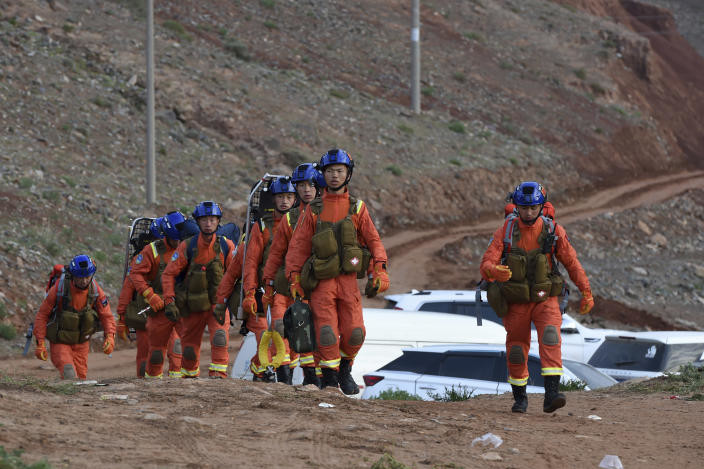
They emphasized that the incident occurred as a result of poor quality and unprofessional management.
The Gansu Government opened an investigation into the incident, as the marathon covered 100 kilometers and some parts of the route recorded temperatures close to zero degrees.
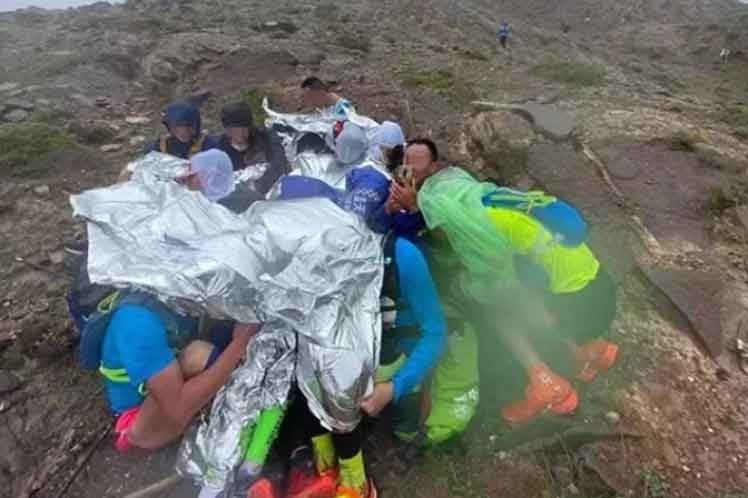
The mountain race was taking place in a forest in Baiyin County with 172 participants, but a spate of hail, freezing rain and gale force winds suddenly lashed a 20-30 kilometer section of the event, which included a high-altitude stage.
Organizers stopped the marathon when they found that many runners suffered physical discomfort and loss of body heat due to low temperatures, while some went astray. However, 21 died, including Asian champion Liang Jing and Paralympic star Huang Guanjun.
As a result of the incident, China suspended other similar competitions until it checked its safety mechanisms, as it detected flaws in their organization and logistics to respond to emergencies.
(06/11/2021) ⚡AMPby Prensa Latina
Tulsa’s Patrick Dever breaks record at NCAA Championships in Eugene
An exciting men’s 10,000m saw 10 athletes finish inside the 42-year-old meeting record of 28:01.30, led by Tulsa’s Patrick Dever who kicked to victory in 27:41.87, as NCAA Championships action got under way in Eugene, Oregon, on Wednesday (9).
Wesley Kiptoo had led a large group through half way before Alex Masai moved to the fore and pushed the pace. It was NCAA cross country champion Conner Mantz who put in a kick at the bell but he was joined off the final bend by Robert Brandt, Abdihamid Nur and Dever, who then found a gap on the inside. Passing the trio, he surged down the home straight to follow in the footsteps of his fellow Briton Marc Scott who had won the 2017 title, celebrating with his arms spread wide as he reached the finish line.
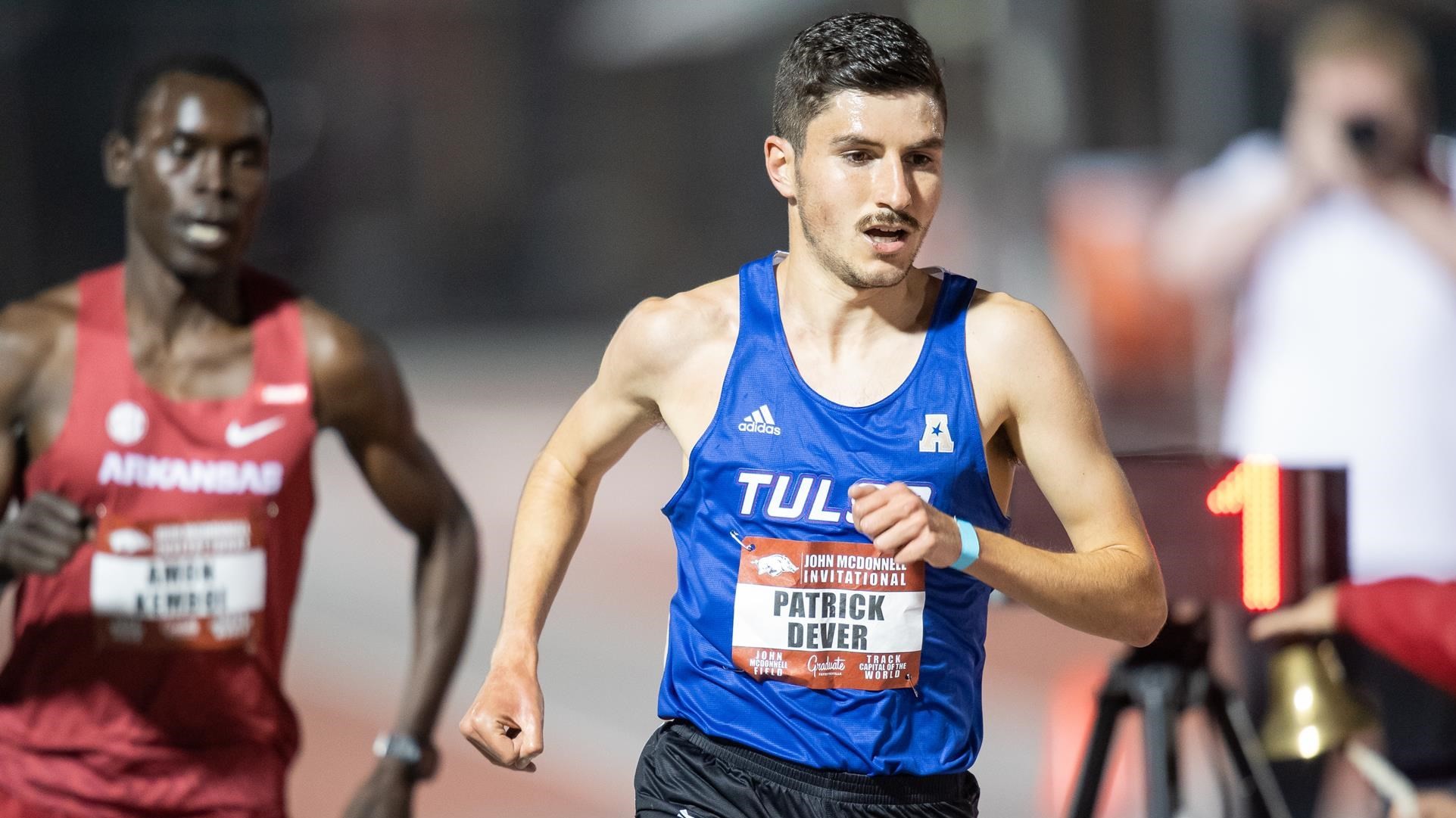
“There was a lot of moving around and a bit of jostling in the pack and it was just a case of keeping calm,” said GB international Dever, speaking on the broadcast coverage. “I really wanted to save something for the home straight because I figured if it were to come down to that, I would need to be ready.”
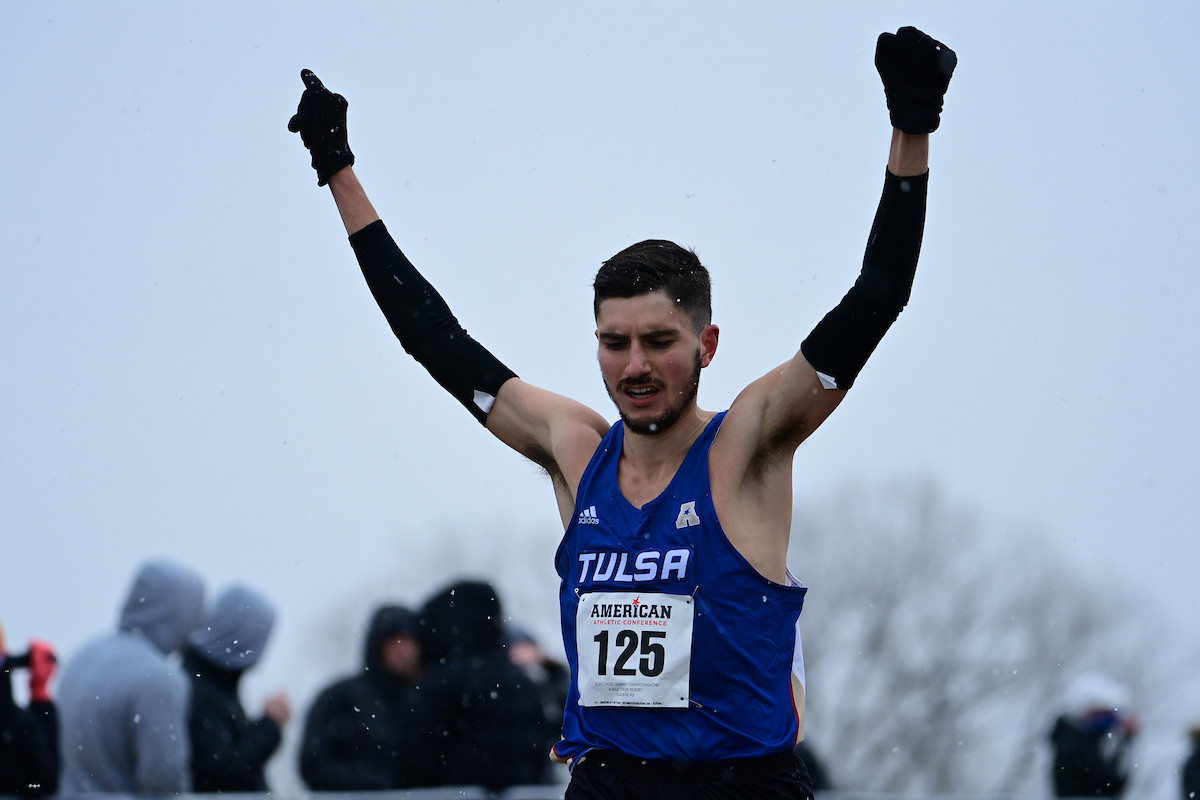
It was only his third ever track 10,000m following his debut in May, and he took 46 seconds off his previous best. He is also set to race the 5000m in Eugene on Friday.
Mantz was second in 27:42.46 and Nur third in 27:42.73. Dever’s 19-year-old compatriot Charles Hicks joined those dipping under the old meeting record with a time of 27:47.63 in seventh place.
LSU’s JuVaughn Harrison was also among the athletes in action on day one and the double NCAA indoor champion leapt 8.27m (1.9m/s) to win the long jump and will return to contest the high jump on Friday.
Branson Ellis won the pole vault with a 5.70m clearance, while Tzuriel Pedigo threw 76.98m to claim the javelin title. Indoor champion Turner Washington threw an outdoor PB of 21.10m to win the shot put and Thomas Mardal recorded 76.74m to lead the hammer results.
(06/11/2021) ⚡AMPby World Athletics
Sifan Hassan will tackle the mile at Müller British Grand Prix on July 13
Dutch endurance running phenomenon races over the classic distance at Wanda Diamond League event in Gateshead on July 13.
Sifan Hassan is the world record-holder in the mile and she is coming to the North East of England on Tuesday July 13 to race over that distance at the Müller British Grand Prix.
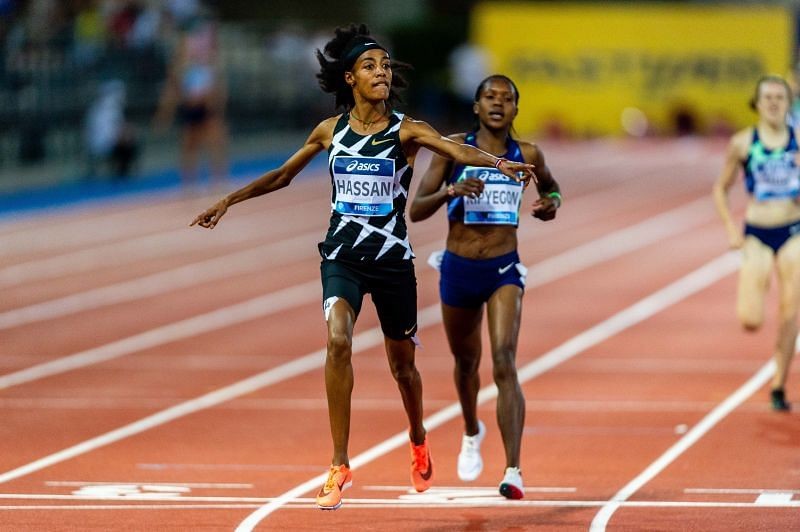
The 28-year-old’s mile record is 4:12.33 and she has been in terrific form this summer with a world 10,000m record in Hengelo on Sunday (June 6) and a big win in Florence over 1500m on Thursday (June 10) against Olympic 1500m champion Faith Kipyegon and European champion Laura Muir.
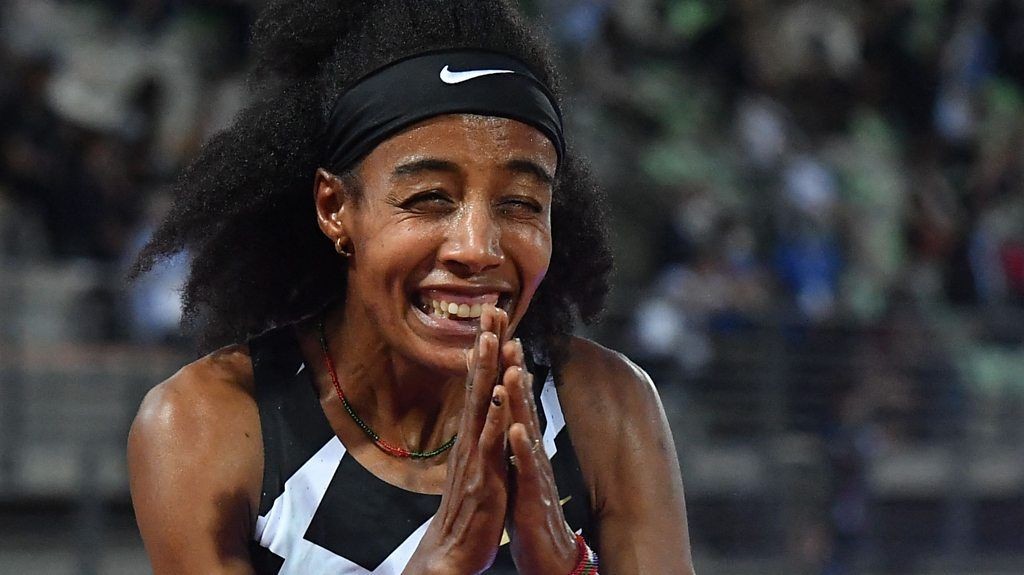
Hassan’s world record for 10,000m of 29:06.82 only survived two days before being beaten by Letesenbet Gidey of Ethiopia. But nevertheless she is also the world champion at 1500m and 10,000m, having beaten Gidey over the longer distance to take the global gold in Doha in 2019.
Hassan said: “I’ve raced several times in the past at events in the UK – at the Anniversary Games in London, meetings in Birmingham and Glasgow and of course the 2017 World Championships and 2018 World Indoor Championships. There is always a warm welcome, a great atmosphere and the fans have good knowledge of the sport.
“Running over one mile in Gateshead on 13th July gives me a chance to test my speed ahead of the Olympic Games. Maybe I can run a good time too although much will depend on the weather. Hopefully it will be warmer and drier than it was for the Diamond League in Gateshead last month!”
Hassan was born in Ethiopia but moved to the Netherlands as a refugee aged 15. She first made her mark internationally when winning the European under-23 cross-country title in 2013 and since then has developed into one of the world’s top endurance runners with incredible ability that ranges from 1:56.81 for 800m through to a European half-marathon record of 65:15. What’s more, she holds world records for the one-hour run with 18,930m and women’s only 5km of 14:44, plus European records at 1500m, 3000m, 5000m and 10,000m.
Gateshead staged the first Wanda Diamond League event of 2021 after it was moved from Rabat in Morocco to the North East of England and now, on July 13, the same venue will host the seventh Diamond League of the season after it was moved from its original home of London.
(06/11/2021) ⚡AMPby Athletics Weekly
Jakob Ingebrigtsen sets new European 5000m record
A 12:48.45 by 20-year-old Jakob Ingebrigtsen from Norway takes down a loaded men’s 5,000m field in Florence Italia and he records a new European record in the process!
2. Hagos Gebriwhet 12:49.02
3. Moh Ahmed 12:50.12
4. Mohammed Katir 12:50.79
5. Justyn Knight 12:51.93 PB
6. Joshua Cheptegei 12:54.69 - first 5K loss since July 2019
Imagine running a 12:51 5000 and it’s only good for 5th!
So yeah, how good is he?
Jakob Ingebrigtsen becomes the first man to simultaneously hold European records in both the 1500 and the 5000.
1500m 3:28.68
5000m 12:48.45
since 1966 by France's Michel Jazy
(06/11/2021) ⚡AMPBudget cuts force Quebec 2021 City Marathon cancellation
Gestev events and the Quebec Running Events Corporation announced Thursday that the annual Quebec City Marathon has been cancelled. The announcement comes on the heels of the Quebec City municipal authority’s decision to withdraw support for fifteen major events, including the marathon, which was set to take place from October 1-3 this year.
The government of Quebec’s reopening plan, announced on May 18, gave the green light to sporting activities as of June 25, and organizers of the marathon were committed to delivering a safe and secure event in the strictest compliance with public health measures. Without funding from the city, however, the event cannot go on.
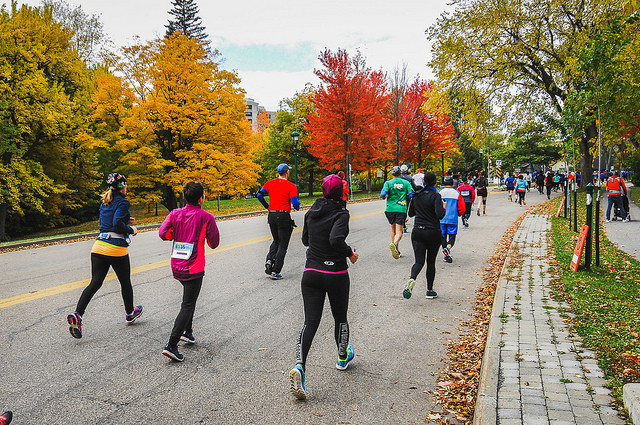
The Quebec City Marathon has been held every August since 1998 until COVID-19 forced the 2020 event to be cancelled for the first time in the event’s history. At its peak, the marathon weekend has attracted up to 12,700 participants across the marathon, half-marathon, 10K, 5K and children’s race. The marathon is a point-to-point race that has runners begin on the south shore in Levis and finish on the north shore in Old Quebec.
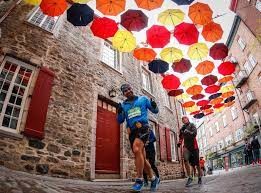
For anyone who has already signed up, registered entrants will have the option to transfer their registration to the Lévis Half-Marathon, scheduled for the weekend of August 28–29. The race is being held over two days instead of one to comply with the province’s public health regulations, making it possible to accommodate a maximum of 5,225 entrants across the half-marathon, 10K, 5K and 2K kids’ race. Entrants who do not wish to transfer their registration will also have the option to receive a full refund.
The Quebec City Marathon is a favorite among both Quebec runners and participants from other provinces, and runners across the country will be saddened to hear that it will not take place for the second year in a row. The good news is, the race is not cancelled forever and organizers are assuring Canadian runners that the marathon will return in October 2022.
(06/10/2021) ⚡AMPby Brittany Hambleton
Marathon SSQ Quebec
The revamped marathon route retains its urban, postcard character and focuses on the most beautiful attractions of Quebec City, a world heritage site. The route, although recently modified due to the preparatory work for the future tramway, crosses three boroughs and nine districts. It is a condensed tour of the city and a excellent sporting challenge with the most beautiful...
more...A university student in China serving as a Cameraman, beats sprinters to the line in 100m race
A university student in China has gone viral, thanks to a video that shows him running ahead of sprinters in a 100m race while filming the action.
The student, who has yet to be named, stole the show at the race, and while he did have a head start of a few metres, his run was still incredibly unexpected and impressive.
Not much has been said on the cameraman’s run yet, although the outlet that first posted the video, Shanghai Eye, wrote that his camera weighed four kilograms, or about eight pounds. Running with something of that size could easily disrupt one’s stride, and that’s not even taking into account the fact that the student made sure to keep his arm outstretched and the camera pointed at the racers all the way to the finish.
He also didn’t appear to be dressed for a run (it looks like he was wearing jeans and a jacket), making his performance even more spectacular.
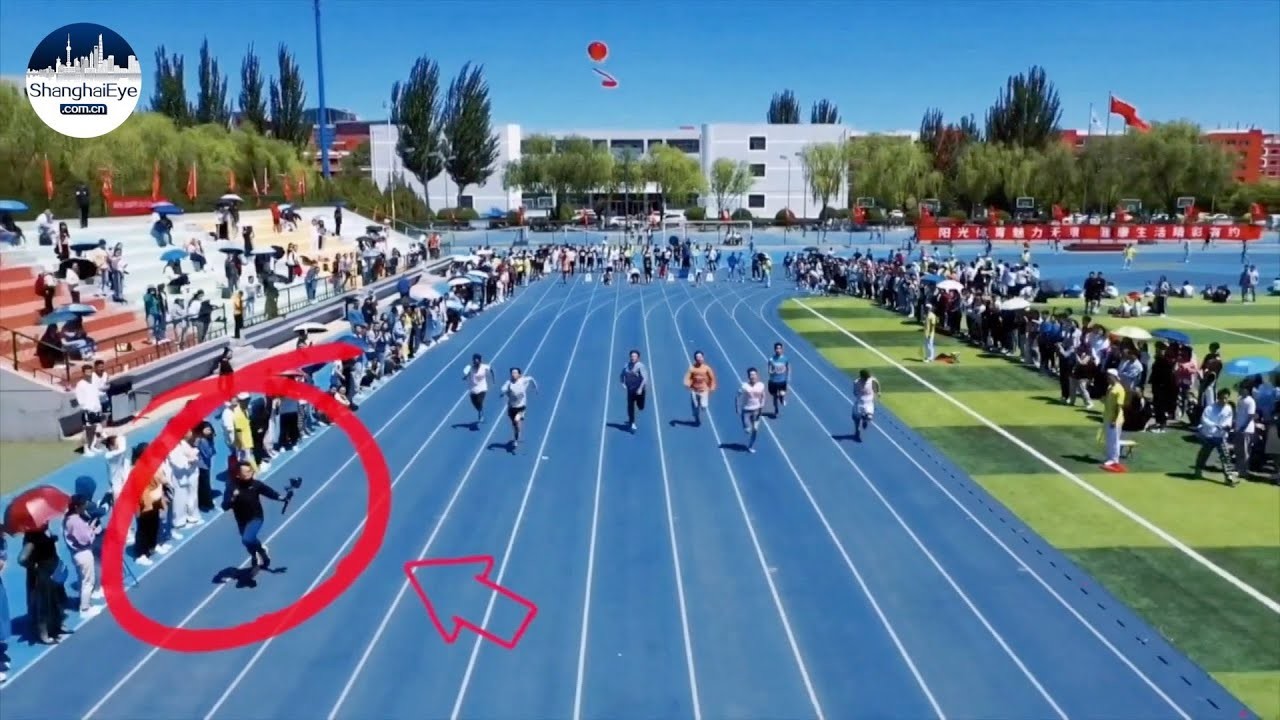
Powerade once produced an ad quite similar to this video. The commercial starts in the final stretch of a 10,000m race as the announcer names the three runners who are fighting for the win. As the shot pans forward, a cameraman can be seen sprinting alongside the leaders, running stride for stride with them.
“Is that our cameraman?” the announcer shouts. “He’s run the entire race with that camera on his shoulder.” The cameraman crosses the line in first place, and then a bottle of Powerade appears on the screen. It’s a funny ad, and life appears to have imitated art in this instance. That commercial can be viewed here.
This race in China is real, though, and it’s a must-watch video. There’s no word on whether the student’s footage was usable (it could have been pretty shaky), nor why he decided to go so hard for the shot. Maybe he needed extra credit in a film class.
(06/10/2021) ⚡AMPby Ben Snider-McGrath
Barred from competing in her preferred event of the 800m, Burundi´s Francine Niyonsaba has now qualified for the Tokyo Olympics in both the 5,000m and 10,000m
Burundi’s Francine Niyonsaba, the 800m silver medallist at the Rio Olympics, qualified for the 10,000m at the Tokyo Games on Tuesday after running under Olympic standard at the Ethiopian Trials in Hengelo, the Netherlands.
The race was Niyonsaba’s first at the distance, but her 31:08.51 finish beat the Burundian national 10,000m record by 20 seconds. Longer races are still quite new to the previously middle-distance specialist, but a 2019 World Athletics ruling now prevents Niyonsaba and other athletes with DSD (differences of sexual development) from competing in any event between 400m and the mile, as officials determined that the higher-than-usual (but natural) testosterone levels in these athletes gives them an unfair advantage over their competitors.
Niyonsaba has had an amazing past few weeks. World Athletics’ DSD athlete ruling gave her three options: compete in races shorter than 400m, jump up to events longer than the mile or take medications to lower her testosterone levels. She picked the long route, and after not racing at all in 2020 and the first half of 2021, she jumped into the first 5,000m race of her career in late May at an event in Spain.
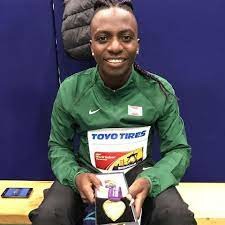
At that race, Niyonsaba came close to the Olympic standard of 15:10.00, running 15:12.08. Just over a week later, she was back in action, this time in France, where she not only managed to beat standard, but also broke 15 minutes with a 14:54.38 run. Both of Niyonsaba’s 5,000m races broke the Burundian national record in the event.
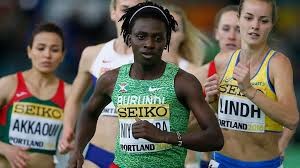
She wasn’t done there, though, and although it was a big jump from the 800m up to the 5,000m, Niyonsaba took another leap on Tuesday and committed to a 10,000m race. With her ticket to the Tokyo Games already booked and nothing to lose, she stunned everyone with yet another Olympic-qualifying run, dipping well under the standard of 31:25.00 with her 31:08.51 finish in Hengelo (in the same race that Letesenbet Gidey broke the 10,000m world record with her 29:01.03 performance).
As listed on Niyonsaba’s WA profile, her two latest races bring her national record tally to seven. She has competed in eight different events throughout her career as an elite runner, and she failed to run a Burundian record in only one of them, the 600m. She is without a doubt one of the greatest athletes Burundi has ever produced, and she’s still fighting for more as she races toward the Tokyo Olympics.
(06/10/2021) ⚡AMPby Ben Snider-McGrath
Tokyo 2020 Olympic Games
Fifty-six years after having organized the Olympic Games, the Japanese capital will be hosting a Summer edition for the second time, originally scheduled from July 24 to August 9, 2020, the games were postponed due to coronavirus outbreak, the postponed Tokyo Olympics will be held from July 23 to August 8 in 2021, according to the International Olympic Committee decision. ...
more...2021 Richmond Marathon will return to normal downtown, in-person format this fall
The Richmond Marathon will be back Nov. 13 and it will look just like any other year, except for 2020 of course.
The 26.2 mile race, along with the half marathon and 8k will all be in-person and start in downtown Richmond.
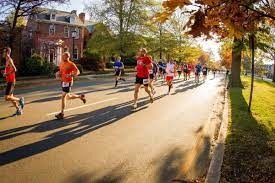
Interested runners can sign up for the events online now, the price will increase on July 1.
“We are excited to return to our traditional format for the VCU Health Richmond Marathon and join together to celebrate all the aspects of race weekend that participants look forward to when running Richmond,” said Jon Lugbill, Executive Director of Sports Backers. “Events like this help make the Richmond region a vibrant place to live, work, and visit, and we can’t wait to welcome everyone back to downtown Richmond in November.”
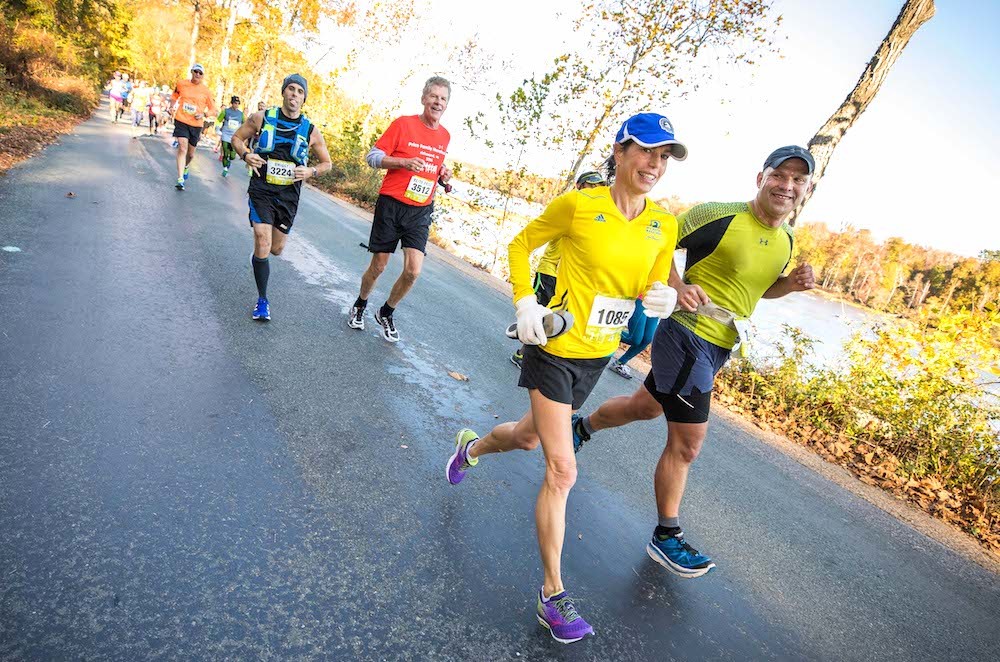
The marathon will end near Tredegar Street.
Last year the marathon was spread out over multiple days but runners were still able to cross a finish line.
Many people participating in the marathon and half marathon join a training team. The Sports Backers’ Marathon Training Team starts in-person group training this weekend.
(06/10/2021) ⚡AMPby Emma North
Anthem Richmond Marathon
Haven’t run Richmond yet? What are you waiting for?! The Anthem Richmond Marathon has a scenic course that winds through the city’s most historic and beautiful neighborhoods and runs over and along the James River. We love to show off the river so much that we even moved our finish line and post-race party to the riverfront. We’ve earned our...
more...Olympics athletes will be monitored by GPS at Tokyo Games
Athletes at this summer's Olympics will be subject to GPS monitoring, says Tokyo 2020 organising committee chief Toshiro Muto.
The system will not be used to track their real-time movements but to trace them retroactively if issues arise around Covid-19.
International members of the media will also be subject to monitoring.
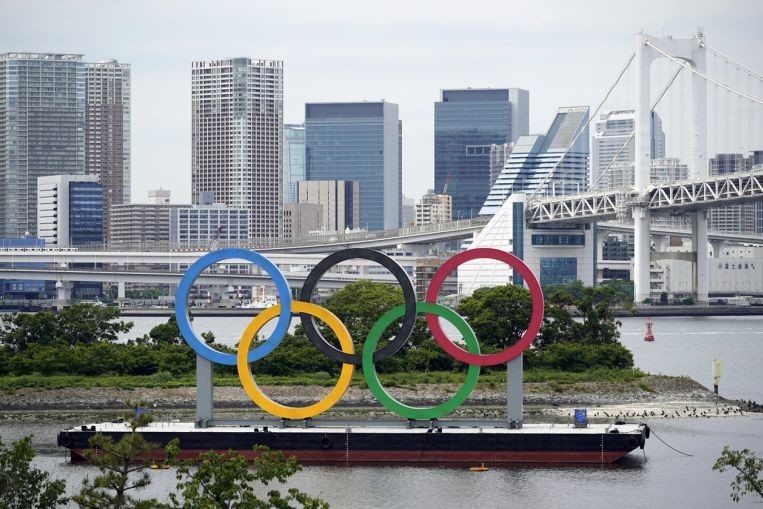
Muto said it had not yet been decided if alcohol would be allowed in the athletes' village.
Tokyo remains under a state of emergency amid a surge in Covid-19 cases, with the start of the Olympics just over six weeks away.
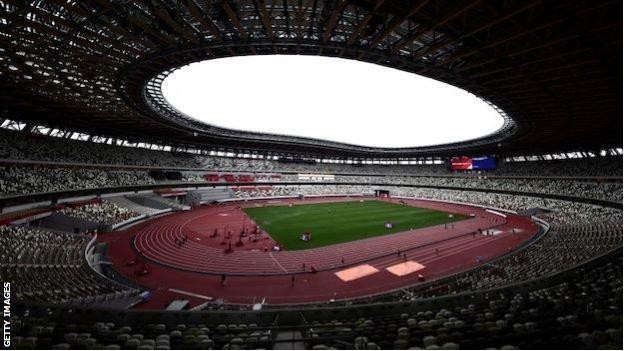
They are set to run from 23 July-8 August, with the Paralympics following from 24 August-5 September.
Muto said it would be of "great regret" if athletes from some countries where the Delta variant of coronavirus is spreading were unable to participate.
Border controls have been strengthened in recent weeks in Japan, but insiders said they would not impact "Games-related entries".
Earlier this week it was decided people arriving from the UK would need to quarantine on arrival for six days rather than three.
However, the British Olympic Association says it has not been told of "any further restrictions facing the British delegation" beyond those outlined in the playbook for the Olympics.
(06/09/2021) ⚡AMPTokyo 2020 Olympic Games
Fifty-six years after having organized the Olympic Games, the Japanese capital will be hosting a Summer edition for the second time, originally scheduled from July 24 to August 9, 2020, the games were postponed due to coronavirus outbreak, the postponed Tokyo Olympics will be held from July 23 to August 8 in 2021, according to the International Olympic Committee decision. ...
more...Olympic champion Conseslus Kipruto eyes perfect debut in Diamond League
Olympic 3,000m Steeplechase champion Conseslus Kipruto will compete for the first time this year in Thursday's Florence Diamond League in Italy.
The third leg of this season's Diamond League will see less Kenyan athletes in action with many preparing for the Olympic Games national trials slated for June 17-19 at Kasarani.
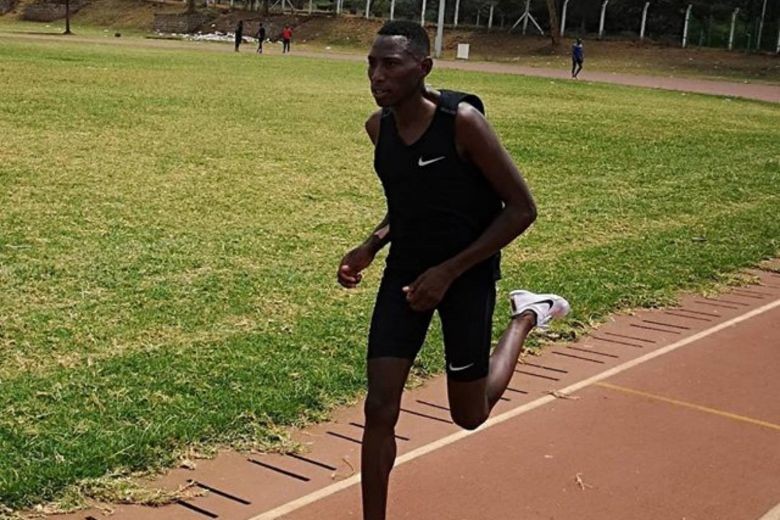
Kipruto will battle world bronze medalist Soufiane El Bakkali from Morocco, Ethiopia’s Takele Tadese, his compatriot Wilberforce Kones, Uganda’s Albert Chemutai among others in the 3,000m Steeplechase race.
The Kenyan started training late after a long break that was caused by the coronavirus pandemic, which saw the suspension of sporting events.
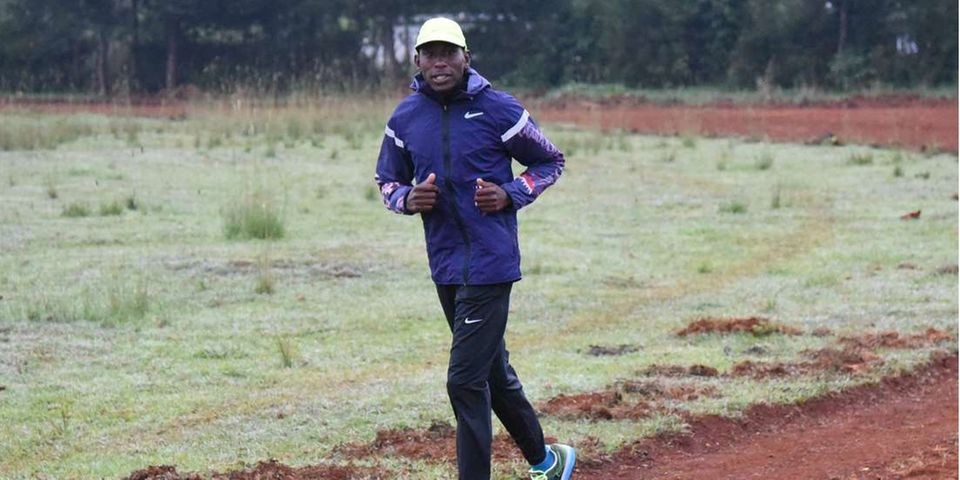
Speaking to Nation Sport via phone, Kipruto revealed that he will run to see if he is fit ahead of next month's Tokyo Olympic Games, which he has already qualified for.
“I started training recently and my preparations are not perfect, but I will be running today (Thursday) just to see where I need to improve ahead of the Olympics Games. I’m using the 3,000m race to improve on my speed,” said Kipruto, who has been training in Mosoriot, Nandi County.
After the Florence meet, Kipruot will head back home to prepare for the Olympic national trials where he hopes to defend his title over the distance.
Another Kenyan in action Thursday night is Olympic 1,500m race Faith Chepng'etich, who line up in her specialty as she seeks to improve her performance ahead of the trials next week.
She will renew hostilties with her rival Dutch’s Sifan Hassan, Great Britain’s Lura Muir, Ethiopia’s Hailu Lemlem, Winnie Nanyondo from Uganda, among others.
Faith is in form this season, having clocked a best of 1:58.26 in the 800m at the Doha Diamond League meet last month.
Robert Kiprop will be the sole Kenyan in the 5,000m race, which has favorite Uganda’s Joshua Cheptegei, Ethiopia’s Edris Muktar, siblings Jakob Ingebrigtsen and Henrik Ingebrigtsen from Norway among others.
(06/09/2021) ⚡AMPby Bernard Rotich
Time is running out for Caster Semenya as African Championships have been cancelled
The African Athletics Championships in Lagos have been cancelled because of the COVID-19 pandemic, removing another avenue for South African runner Caster Semenya to qualify for the Tokyo Olympics.
The event was scheduled for Lagos later this month after Nigeria had stepped in at the last moment to replace Algeria as hosts, but the Nigerian government has disallowed the event due to COVID-19 concerns.
Semenya, who is hoping to qualify for the 3000m and 5000m races, is waiting on a ruling from the European Court of Human Rights over her testosterone-related ban from her preferred races of 800m and 1500m.
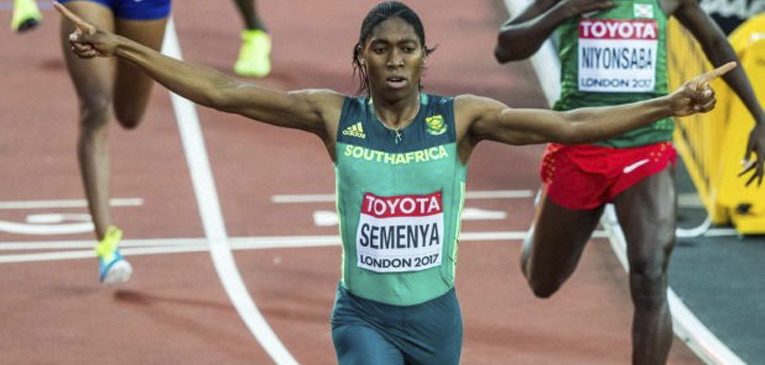
She had been intending to use the African Championships to qualify in the 5000m, after failing to do so at a recent meet in Pretoria.
The Confederation of African Athletics (CAA) said on Tuesday: "It is with great regret that we announce the cancellation of the Senior African Championships which were scheduled in Lagos from June 23-27.
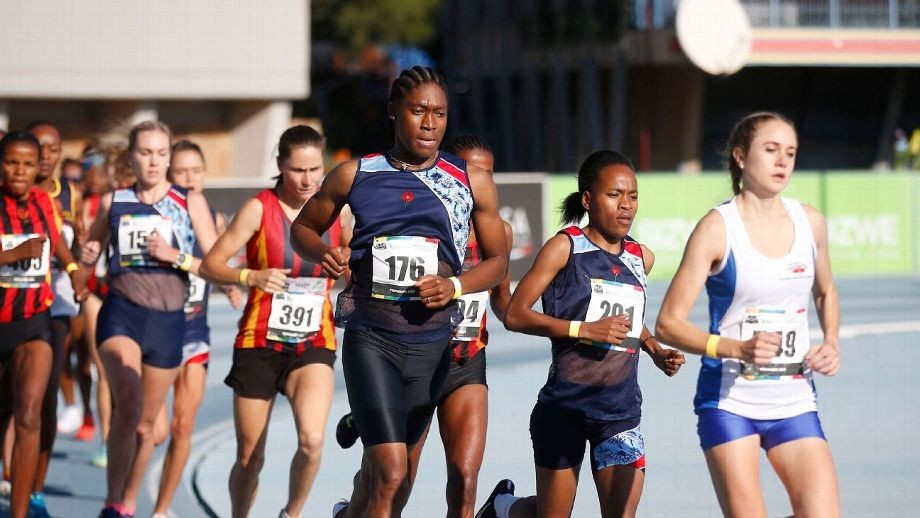
"Unfortunately, Nigeria, which pledged to host, has since told us their authorities have not given permission to host such a large-scale competition."
While there are no other plans for continental meetings to allow athletes to obtain the required qualification standards for Tokyo, South African athletes still have a number of opportunities to qualify before the cut off date of June 29.
James Moloi, president of Athletics South Africa, said on Tuesday: "Most of Africa and indeed, the major part of the world, is still being held hostage by the pandemic.
"It's a pity, therefore, that our athletes will not be benefitting from the great competition that the African Champs offer and it's unlikely that there will be another opportunity to host the continental event before the Olympic Games.
"However, this is not entirely a lost course for our athletes who are still looking for competition to qualify for the Games as there are several competitions that are available in our domestic calendar at our ASA provinces."
He added of Semenya's races: "KZN Athletics, for instance, will include the 5000m events in their Middle Distance Meeting [on 18 June]."
Travel restrictions make it difficult for athletes to go to meetings in Europe or the US, leaving many African athletes with few options over the next three weeks.
(06/09/2021) ⚡AMPby Lindsay Du Plessis
Tokyo 2020 Olympic Games
Fifty-six years after having organized the Olympic Games, the Japanese capital will be hosting a Summer edition for the second time, originally scheduled from July 24 to August 9, 2020, the games were postponed due to coronavirus outbreak, the postponed Tokyo Olympics will be held from July 23 to August 8 in 2021, according to the International Olympic Committee decision. ...
more...New world record for women’s 10,000m
Ethiopian Letesenbet Gidey lowered the women’s 10,000m world record, two days after Sifan Hassan broke it on the same track in Hengelo, Netherlands.
Gidey, who on Oct. 7 broke the 5000m world record, clocked 29:01.03 at the Ethiopian Olympic Trials (yes, the Ethiopian Trials are being held in the Netherlands). She took 5.79 seconds off Hassan’s record from Sunday.
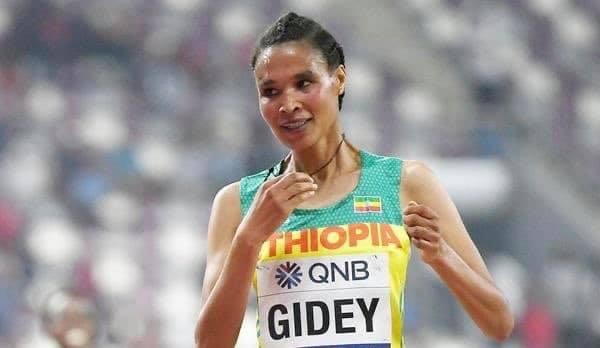
Hassan, an Ethiopian-born Dutchwoman, brought the record down 10.63 seconds from Ethiopian Almaz Ayana‘s winning time at the 2016 Rio Olympics.
In total, 30.75 seconds have been taken off the world record starting with Ayana in Rio. Before that, the mark of 29:31.78 set by dubious Chinese runner Wang Junxia had stood since 1993, and nobody else had run within 22 seconds of it.
All four men’s and women’s 5000m and 10,000m world records have been broken over the last 10 months. Runners have benefited from technology — new spikes and pacing lights on the track.
In 2019, Gidey took 10,000m silver at the world championships. In 2020, she took 4.5 seconds off countrywoman Tirunesh Dibaba‘s 12-year-old 5000m world record.
Gidey, 23, was previously briefly expelled from school for refusing to run in physical education classes.
(06/08/2021) ⚡AMPCanadian Stephanie Simpson to attempt Canadian 100-mile record on June 12 at the Montreal 24-hour Endurance Challenge
Canadian ultrarunner Stéphanie Simpson will be attempting to break the Canadian 100-mile (160 km) record this weekend at the Défi 24 heures Endurance (24-hour endurance challenge) in Montreal, Que. The current Canadian record, held by Michelle LeDuc of Russell, Ont., is 15:19:45, and Simpson’s goal is to not only beat that time, but to complete the distance in 14:45.
Simpson began running in 2008 as a way to deal with stress when her mother was sick. She started the way many of us do, running shorter distances like 5K’s and 10K’s, eventually working her way up to half-marathons and marathons. She completed her first 50-kilometer ultramarathon after the birth of her first child in 2015 and never looked back. She was relatively unknown in the world of ultra trail running until last October when she became the Canadian winner at Big’s Backyard Ultra, running for 43 hours to lead Team Canada to a third-place finish.
So what does the training for a record attempt like this look like? For Simpson, it’s been fewer really long runs and more speedwork.
“I haven’t run really long distance since the Backyard,” she says. “Since then, I haven’t done anything above 50, but I’ve still been doing big weeks of 200 kilometers. I’ve been doing more speed lately, because you need some kind of speed to run for that long at that pace.”
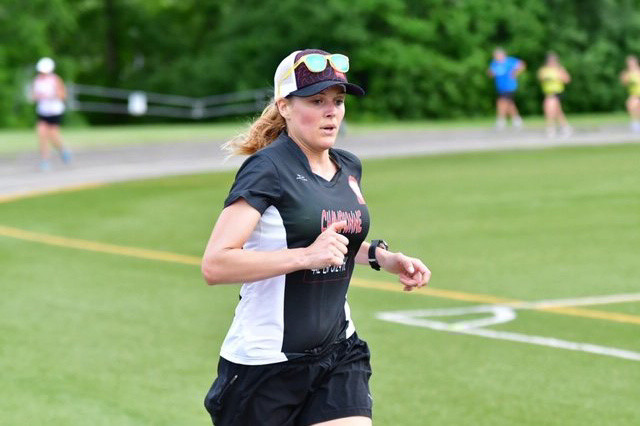
To run her goal time, Simpson will need to maintain a pace of 5:29 per kilometer. Because the event is a 24-hour race, her plan is to get through 100 miles in her goal time, then see what happens with the rest. The Canadian 24-hour record is 238 kilometers, and while that record isn’t her main goal, two records in one race isn’t out of the realm of possibility. Regardless, in order to achieve her goal, Simpson says mindset and confidence are the two main keys to success.
“A hundred-miler at that pace is really mental, so you have to be really really ready,” she says. “I’ve been visualizing everything that could happen, and when you run those kinds of distances, you have to be really confident in your plan — that’s the only way you’re going to get through 100 miles.”
Simpson will be running with seven other local runners around the outdoor track at McGill University. The race is set to begin at 8 am this Saturday, June 12, and if all goes according to plan, she should reach the 160-kilometer mark just before 1 a.m. on Sunday.
(06/08/2021) ⚡AMPby Brittany Hambleton
Study suggests that Increasing your stride rate will decrease your risk of injuries
When stride rate first entered the running conversation, the main focus was performance, with the idea that increasing your stride rate would make you run faster. In recent years, that focus has shifted to injury prevention, and studies have correlated a quicker stride rate with a decreased risk of injuries.
A recent study of Division 1 university cross-country runners has added more evidence to support this theory, finding that a low step rate was a risk factor for bone stress injuries.
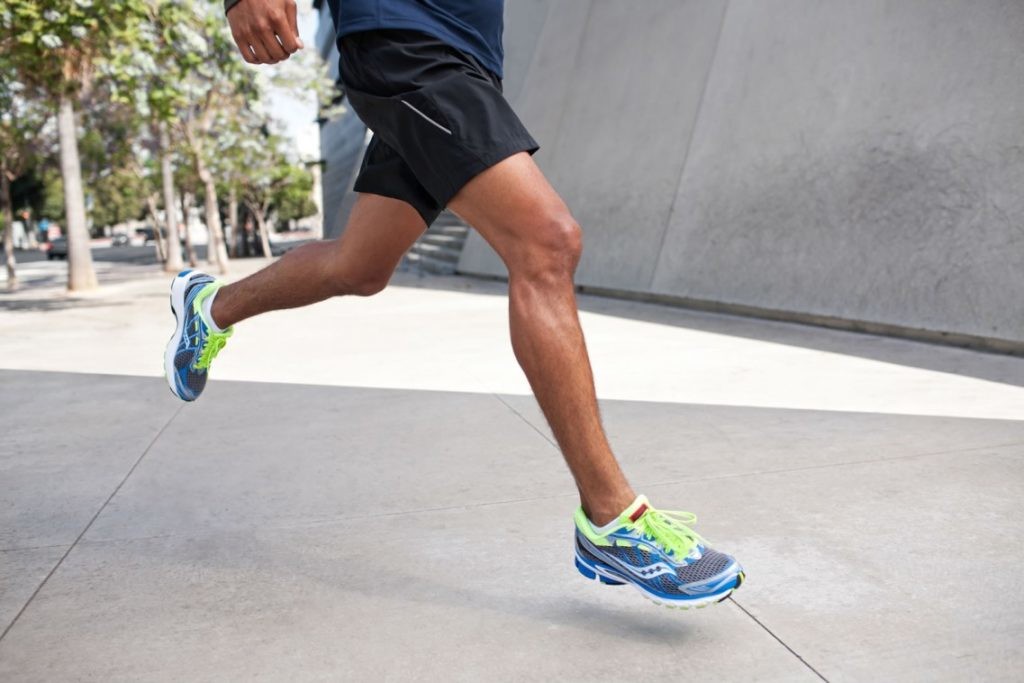
The study
The researchers conducting this study (which was published in the British Journal of Sports Medicine) observed 54 healthy collegiate cross country runners over three consecutive seasons. They collected a variety of different measurements, including whole-body kinetics, ground reaction forces and bone mineral density using motion capture on an instrumented treadmill and total body densitometer scans. They then tracked how many of those athletes developed a bone stress injury up to 12 months after that data was collected.
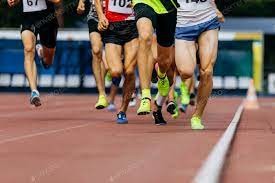
The result? Athletes with a higher step rate were less likely to develop a bone stress injury (like a stress fracture). In fact, for every increase of one step per minute, the athletes’ risk of bone stress injuries was decreased by five per cent. In conclusion, “Low step rate is an important risk factor for BSI among collegiate cross country runners and should be considered when developing comprehensive programmes to mitigate BSI risk in distance runners,” the researchers wrote.
Apply this to your running
So what does this mean for the everyday runner? Increasing your stride rate (i.e. — shortening your stride) can help decrease your risk for injuries, particularly bone injuries. Before you do this, however, you need to know what your current stride rate is. To figure this out, all you have to do is count your steps. On your next run, once you’ve settled into your normal pace, count your steps for 30 seconds, then multiply that number by two to determine how many steps you take per minute.
To increase your stride rate, Nova Scotia runner and physiotherapist Robbie MacDonald suggests running with a metronome app. This way, you can set how many steps per minute you want to take, and try to match your stride to that cadence. MacDonald recommends runners try to maintain a stride rate between 170 and 190 steps per minute. If you enjoy running to music, try choosing songs that fall within that beat range, and try to sync your steps with the music.
(06/08/2021) ⚡AMPby Brittany Hambleton
Tata Consultancy Services to become the title partner of London Marathon from 2022
This year’s ambition is for 50,000 runners to take part in the mass participation event from Blackheath to The Mall
Tata Consultancy Services (TCS) will become the title partner of the London Marathon from 2022, following this year’s race on October 3.
TCS has a historic track record with major marathons across the world, including New York, Amsterdam, Singapore, and Mumbai. London will be the second Abbott World Marathon Major where TCS is the title partner and the fourth where TCS is the partner, as well as its seventh title partnership globally.

TCS plans to use digital innovation to further enhance the event experience for all future races which will continue to be a hybrid of physical and virtual events. This year’s ambition is for 50,000 runners to take part in the mass participation event from Blackheath to The Mall, and a further 50,000 in the virtual event.
“The London Marathon was founded on the core belief that the family of mankind can be united. TCS is building innovative and impactful technology solutions to help realize this belief, and inspire people to believe in themselves,” said Amit Kapur, Country Head, TCS UK & Ireland. “We are pleased to take on the role of title partner and lead the way in driving the future success of physical and virtual London Marathons.”
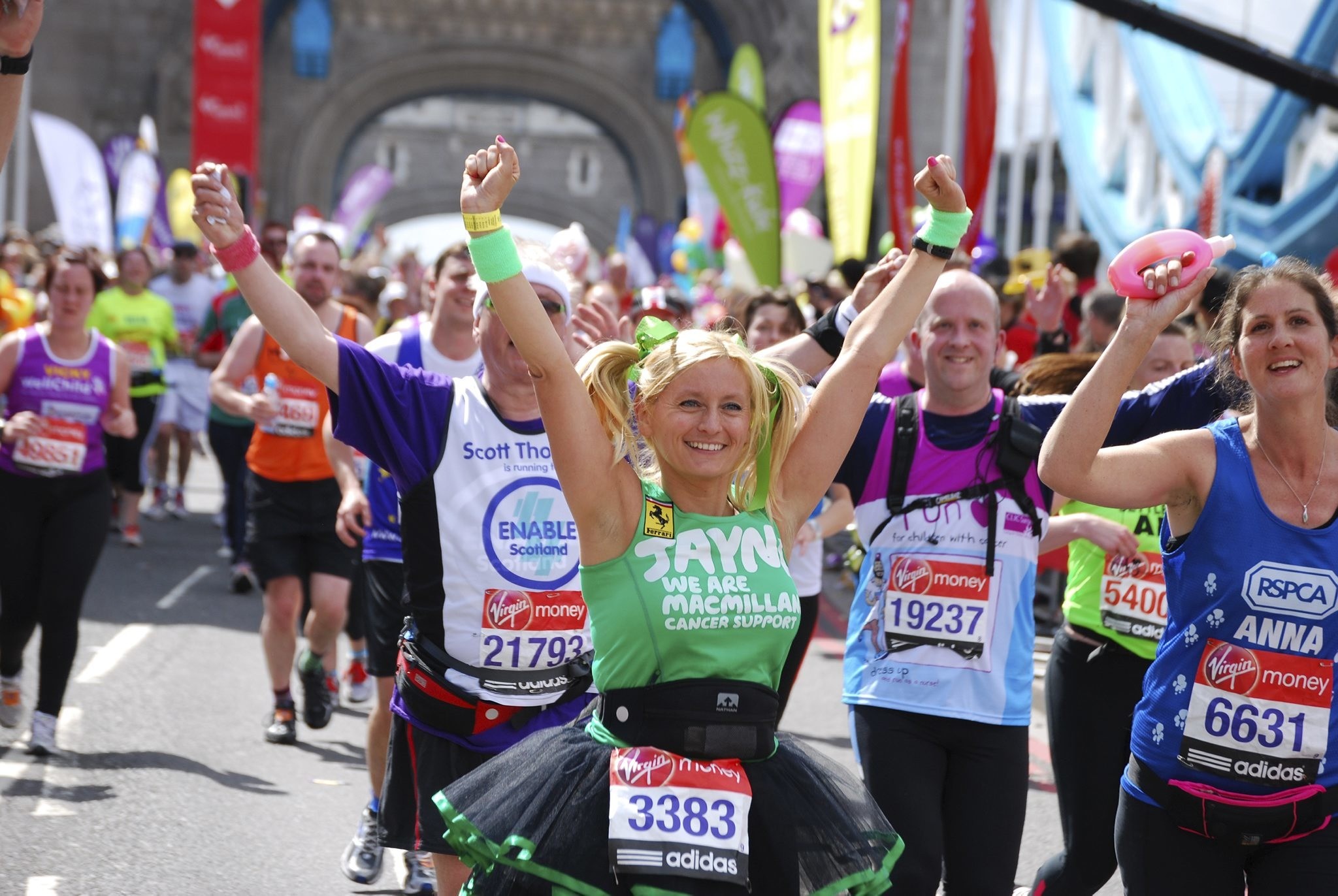
“We are delighted to welcome TCS as the new title partner of the London Marathon from 2022. This is a landmark day in our history, and we look forward to working with TCS to evolve and grow our digital reach, inspire millions more to become active and develop opportunities to raise even more for charities. TCS has been an integral part of the Marathon for the past five years, delivering the latest technology to enhance the marathon experience for participants and spectators.
This new title partnership marks the dawning of a new era in what we can achieve together,” commented Hugh Brasher, Event Director of the London Marathon.
(06/08/2021) ⚡AMPTCS London Marathon
The London Marathon was first run on March 29, 1981 and has been held in the spring of every year since 2010. It is sponsored by Virgin Money and was founded by the former Olympic champion and journalist Chris Brasher and Welsh athlete John Disley. It is organized by Hugh Brasher (son of Chris) as Race Director and Nick Bitel...
more...American Record Holder and former United States Olympian Alan Webb is set to Run Grandma's Marathon
Once, and perhaps still, a household name in short-distance running, former United States Olympian Alan Webb will make his 26.2-mile debut later this month at the 2021 Grandma’s Marathon.
Webb, who still owns the American record in the mile with a time of 3:46.91, competed in the 2004 Athens Olympics in the 1500-meters and also won three gold medals at the USA Outdoor Track and Field Championships.
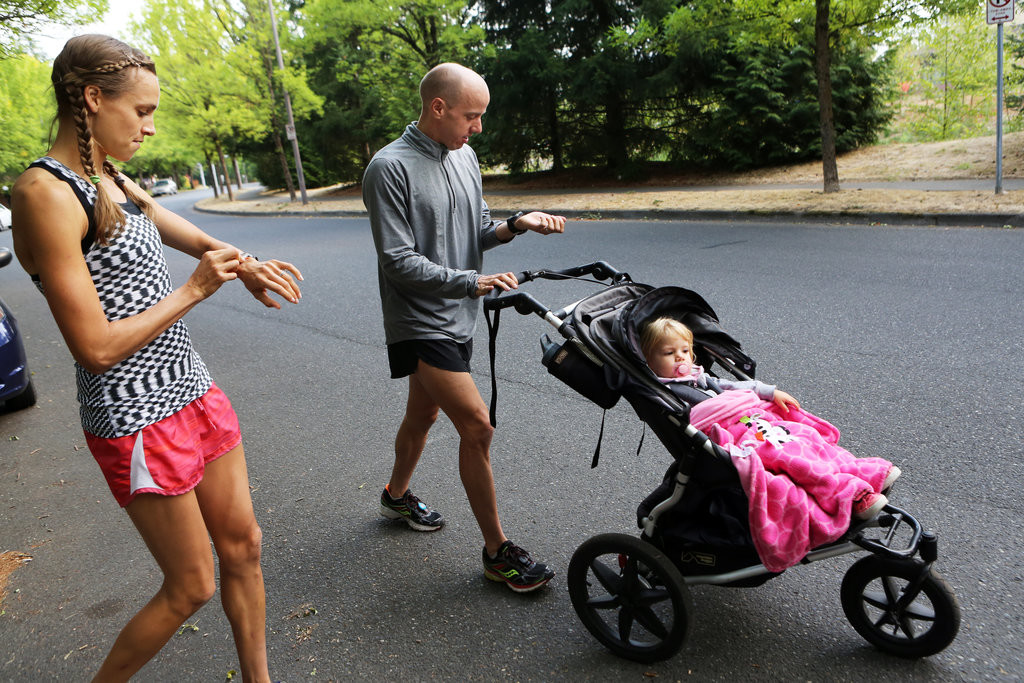
Now an assistant cross country and track and field coach at the University of Arkansas Little Rock, he says the timing is right to try the longer distance.
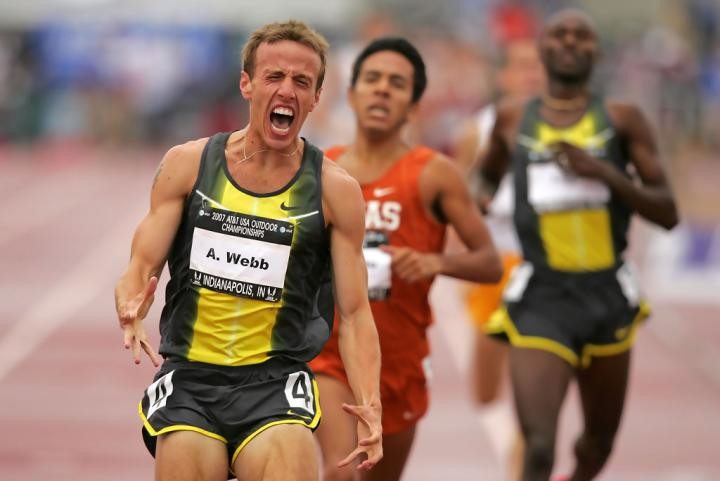
“I’ve always heard good things about Duluth and about Grandma’s Marathon,” Webb said. “I’m not so much running now to be competitive, I’m running because I love to do it and because of what the sport has meant to me my whole life. The timing of Grandma’s works well for my coaching schedule, and I’m excited to come to Minnesota and to run on this beautiful course.”
Webb made his half marathon debut on May 29 at the Great American River Run in Memphis, Tenn., finishing in fourth place with a time of 1:13:14.
Webb and his wife, Julia, are currently living in Little Rock, Ark. and have three children.
The 45th annual Grandma’s Marathon weekend will be held June 17-19, 2021.
(06/08/2021) ⚡AMPby Running USA
Grandmas Marathon
Grandma's Marathon began in 1977 when a group of local runners planned a scenic road race from Two Harbors to Duluth, Minnesota. There were just 150 participants that year, but organizers knew they had discovered something special. The marathon received its name from the Duluth-based group of famous Grandma's restaurants, its first major sponsor. The level of sponsorship with the...
more...Organizers hope up to 35,000 can run this September 2021, Berlin Marathon
Organizers hope that up to 35,000 runners can take part in the Berlin marathon this September as part of a pilot project as Germany eases Covid-19 restrictions.
In a joint press conference Monday, Berlin's senate and marathon organizers outlined plans to first hold two test events, a 10km race in July and a half marathon in August.
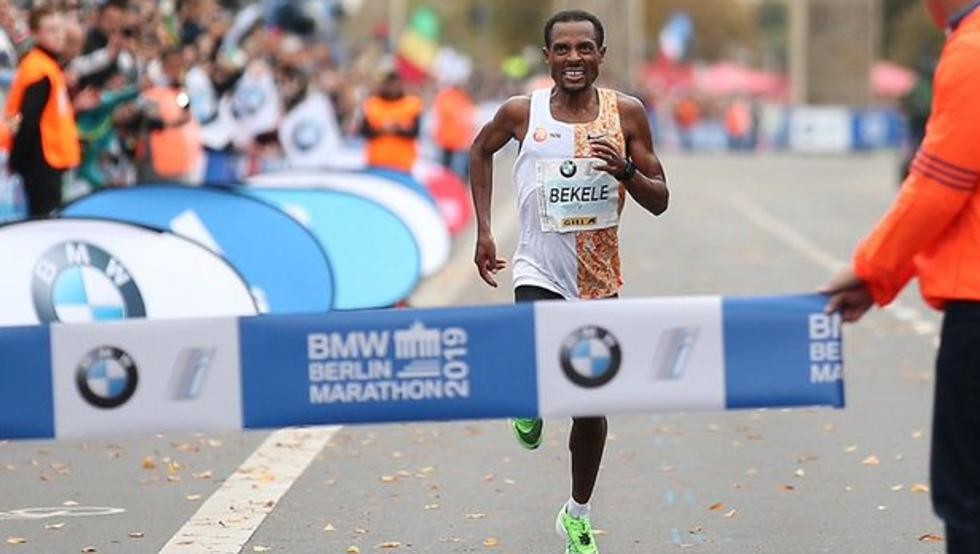
Providing all goes well and the rate of infection remains low, the Berlin marathon would take place on September 26.
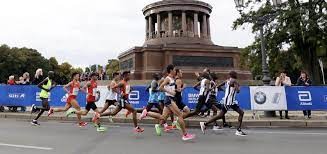
Runners would either have to prove they are fully innoculated or undergo a PCR test as part of a hygiene programme still to be approved by Berlin's health authority.
"There is no certainty that the Berlin Marathon can take place, but the probability is there," said Berlin senator Andreas Geise.
"If the incidence rates continue to fall, approval of the pilot project is conceivable."
A maximum field of 35,000 would be 10,000 down on the 45,000 who took part in the 2019 Berlin marathon, the last one before the 2020 race was cancelled due to the pandemic.
The official world record for the men's marathon was set in Berlin in 2018 when Kenya's Eliud Kipchoge ran the 42.195kms (26.2mi) in two hours, 1:39 minutes.
The top three fastest race times for the men's marathon have all been run in Berlin.
(06/07/2021) ⚡AMPby France 24
BMW Berlin Marathon
The story of the BERLIN-MARATHON is a story of the development of road running. When the first BERLIN-MARATHON was started on 13th October 1974 on a minor road next to the stadium of the organisers‘ club SC Charlottenburg Berlin 286 athletes had entered. The first winners were runners from Berlin: Günter Hallas (2:44:53), who still runs the BERLIN-MARATHON today, and...
more...Unconventional and creative ways that you never thought could help you in shape
They tell us that keeping in shape is all about hard work, dedication, and sticking to a strict diet. This is only somewhat true, as indeed this will give you a fit and healthy body if you are persistent enough, though that is not the only way of doing it. A bit unconventional, but there are things you can do to stay in great shape that does not fit into the previous list of activities.
Things like eating more, clubbing, and sleeping don’t come to mind when thinking about fitness, yet they can indeed help us get and maintain a lean body if applied correctly. See what else you can do below, and we’re sure you haven’t thought of at least one of those on the list.
A Corset-Like Figure

A very famous silhouette, showing up every few centuries but having its peak in the female corset of the Victorian era, reminds us mostly of an hourglass figure. Or a pigeon breast and a wasp waist, if you will. This idealized body is of course unobtainable naturally, and can only be achieved by wearing tight-fitting clothing or via some surgery. But considering how a narrowed waist helps stabilize the spine, there is a certain benefit here.
Heavy weightlifters carry a similar type of clothing – a weight belt, that helps keep the back straight during deadlifts and squats. Wearing similar narrow-waisted clothing will not only give you proper posture but will also push your stomach in a bit thus restricting your appetite. Just make sure to keep the chest unbound, as restricted breathing is not a good thing.

Sleep Your Way to a Fit Body
While we sleep, a lot is happening to our bodies, even though we are presumably only resting and lying down. Sleep is needed for our muscles to recover after heavy exercise or labor, and for our mind to rest from all the thinking we’ve been doing.
Though depending on how old you are and what you do, you will need different amounts of sleep to become fully rested. You can try out this sleep calculator to see what fits you best. Getting too little sleep is detrimental to your health and should be avoided. As we sleep or rest, the muscle tissue that has been micro torn during physical activity regenerates to build bigger and stronger muscles. So exercising too much and having too little rest will not bring you any good body-wise.
Eat More!
Absurd as it may sound, there are scenarios where eating more is good for staying in shape. There are two cases for this, different but with some overlap. If you are underweight, as was the case with people for many centuries until the current age, then eating sufficiently is not only good for your organism to get all the nutrients and energy it needs, but to build up a pleasant-looking outside too. Proteins in food help build muscles and organs and are therefore essential in any diet. It would be very difficult to completely avoid proteins in a normal diet because finding protein-rich food is rather hard. But turning to tuna, chicken breasts, or lean beef – you can get plenty of protein in and your body will naturally start placing the proteins where they need to go, thereby keeping you nicely toned. And even vegans have alternative solutions for this, as some plants can have huge amounts of protein in them as well.
Setting a Clock Diet
Diets that restrict what we eat are the most common thing we turn to when we have to lose some weight. Paleo, low-carb, vegan, and so forth. But a clock diet is different, in that it is made so that you can eat whatever you want but are restricted to when you can eat it. Not perfect in itself, it does have some very compelling arguments for it.
Our digestive system has evolved to follow a certain rhythm of life, day and night, and so forth. And although our eating habits have considerably changed, some parts of the digestive system are still the same. It takes a lot of time to digest some foodstuff, mainly meat, so timing your meals to have enough space between them is very beneficial for the body. Restricting yourself to not eat anything from, say, 7 PM to 6 AM gives you plenty of time to fully digest everything in your stomach and use it as it needs to be.
Make House Chores An Exercise
Chores await us every day in various amounts and don’t magically disappear just because we ignore them. And even though most of us would rather spend the time hanging out with friends or going for a walk – some things just need to be done sooner than later. But why not make it useful in more ways than one?
Studies show that doing household chores could improve your health, equaling in some cases to the same benefit as regular exercise. Not only that – they can also be an exercise on their own, giving you a workout when you would otherwise be bored. Squatting while taking out the dishes, planking while vacuuming, running for groceries… the number of possibilities is endless.
Dance Until You Drop
Clubbing is mostly associated with having fun and meeting new people, not staying in shape, but did you know that dancing burns a lot of calories? And dancing is what going to clubs is all about. Certain gigs will get you pumped up for jumping more than others, but even slow-paced music allows for long and graceful dancing that makes you break a sweat.
Of course, many people will also be drinking alcohol, which is very caloric, and will eat some fast food afterward, which is even more caloric! But limiting for yourself these two things can work wonders in terms of staying fit while also having fun partying.
These six unconventional and creative ways of keeping you in shape are what everyone needs when they normally don’t have the time to work out or the willpower to go on a diet. They are easy to do and only require a bit of organizing. So good luck with them and you’ll see results in no time.
(06/07/2021) ⚡AMPby Colorado Runner
Sifan Hassan breaks the world 10,000m record in Hengelo
There was little about Sifan Hassan’s run at the FBK Games in Hengelo on Sunday (6) that gave the impression she was being patient. Eyes firmly fixed on the track ahead, her arms pumping and legs turning with incredible consistency, she looked like a person who had places to be – and fast.
But, at the same time, she seemed calm and in control. Despite traveling at a pace of 2:55 per kilometer for the majority of her 10,000m, there was no fluster or signs of the tiredness that she later revealed had gripped her in the early stages. Hassan was flowing towards the finish line, where – 29 minutes and six seconds after she started – her world record ambition would be realised. Inside, the Dutch 28-year-old was giving herself a stern talking to.
“Having travelled from America, I had jet lag and I felt terrible at the beginning,” Hassan revealed. “Everything felt heavy, but I just tried to hang on to the lights. Sometimes I accidentally passed them, and I thought ‘no, calm down! Be patient.’”
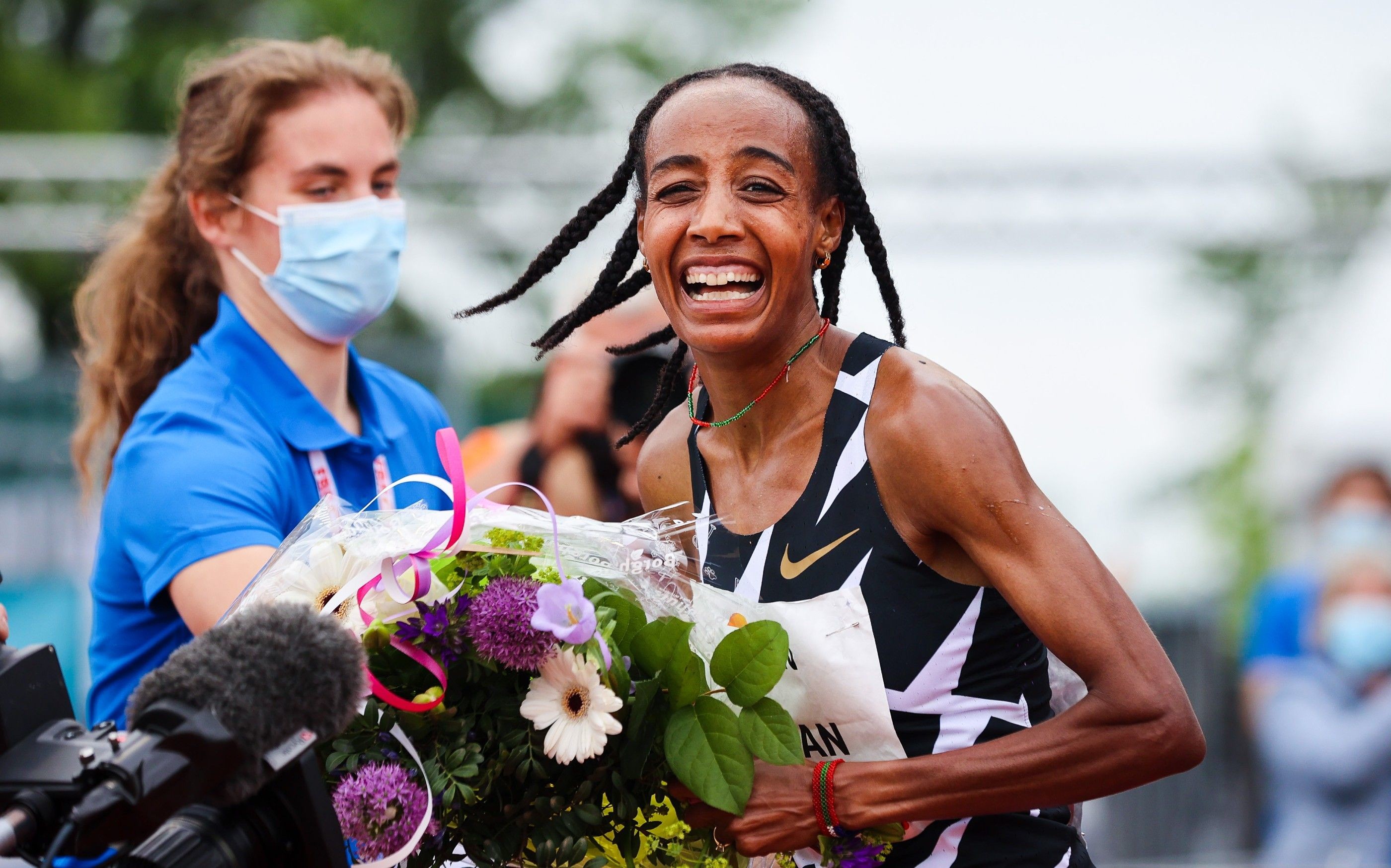
The lights she describes formed part of the Wavelight technology used at the Fanny Blankers-Koen Stadion during the World Athletics Continental Tour Gold meeting in the Dutch city, programmed to highlight the pace needed to improve the world 10,000m record of 29:17.45 which had been set by Ethiopia’s Almaz Ayana at the 2016 Olympic Games in Rio.
The blue lights showed world record tempo, while the green indicated the speed of Hassan’s own European record of 29:36.67 run on the same track eight months earlier. Ultimately, the double world champion’s patience paid off, as she waited until the final kilometre to move away from those bulbs. Then it was Hassan’s turn to light the way.
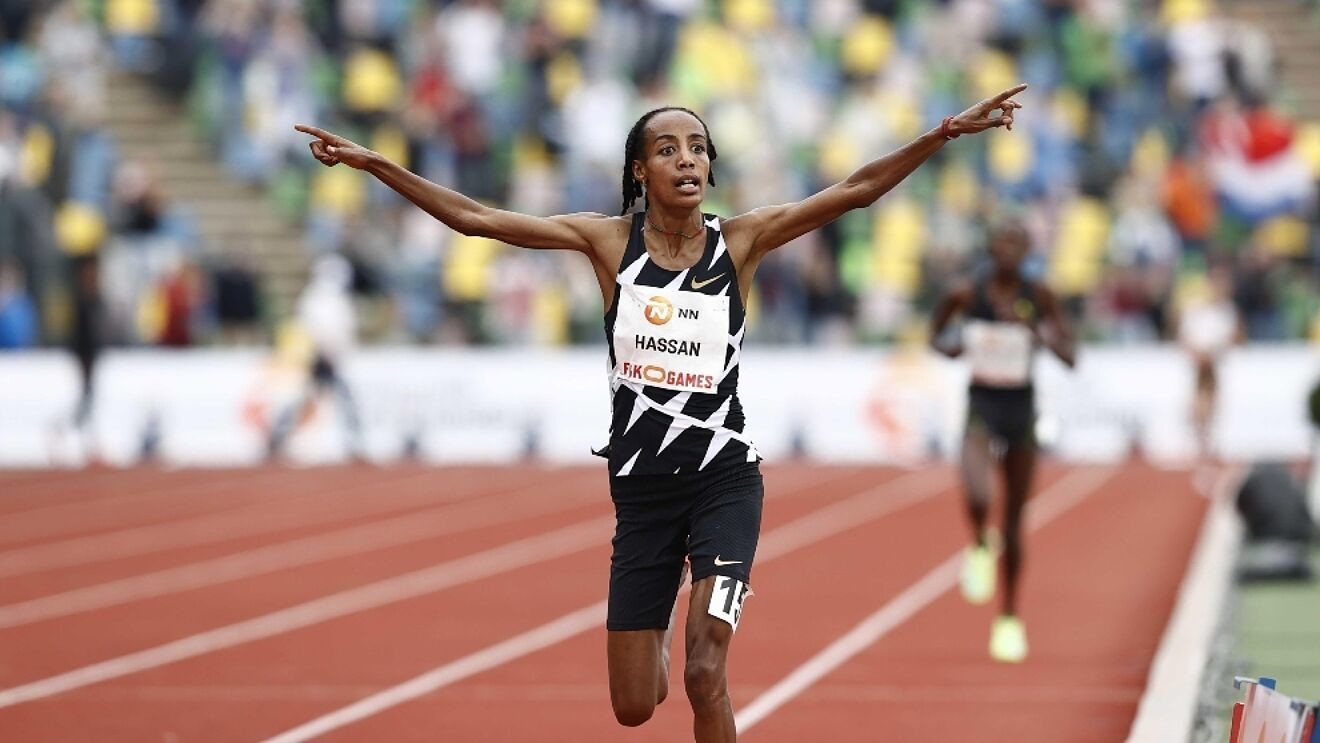
After kilometres of 2:56.12 and 2:56.07 behind pacemakers, Hassan ran splits of 2:55.72, 2:55.42, 2:55.42, 2:55.69, 2:55.93, 2:55.48 and 2:55.20 before upping the tempo and completing the final 1000m in 2:45.77.
As she reached her destination, the clock read 29:06.82 – a time more than 10 seconds faster than Ayana’s world record mark. What makes the performance all the more remarkable is how it forms part of a CV which also boats world records for the mile (4:12.33), women-only road 5km (14:44) and one-hour event (18,930m), plus European records in the 1500m (3:51.95), 3000m (8:18.49), 5000m (14:22.12) and half-marathon (1:05:15).
And then there’s the fact that Hassan feels she can go even quicker still.
“I know I am in shape to go under 29 minutes,” said the Tim Rowberry-coached runner, who has trained in Kenya and Utah, USA, in recent months. “But my coach said ‘no, we train for under 29 so you can run 29:17’. Yesterday I had confidence, I was like ‘I want to go 29:10’ but he said he wanted me to go exactly with the pace.”
Having started her season with a 14:35.34 5000m and then run 2:01.54 for 800m in May, she added: “I am not the sort of person who always runs a fast time in my first race. I know my training has been amazing, but I didn’t know how it would be in my competition. When I got to the last mile or the last 1500m I thought ‘okay you can do this, you can hold it’.”
The path for that performance had been paved in Hengelo last year. “I was scared in October,” she explained. “I was tired in the last couple of laps.
“I learned a lot from that race. That race taught me to hold myself back. I was telling myself that I have time to go under 29 minutes, I am just young – now I should just get the world record.
“Patience,” she added. “I learned patience.”
Her manager Jos Hermens, himself a world record-breaker, also believes that quicker times are to come.
(06/07/2021) ⚡AMPby World Athletics
Grandma’s Marathon will bring back celebration of spectators
A loosening of the state’s public health guidelines, announced recently by Minnesota Gov. Tim Walz, has paved the way for the return of two traditional and popular pieces of Grandma’s Marathon weekend.
The 45th annual Grandma’s Marathon weekend will be held June 17-19, 2021.
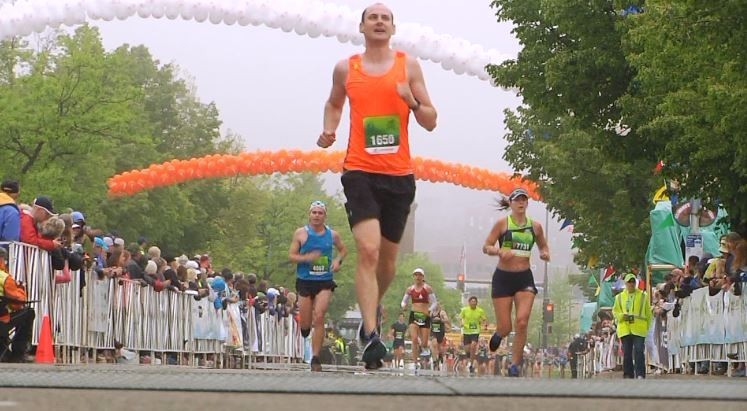
Based on the governor’s expected timeline of eliminating capacity limits and distancing requirements, organizers say they will now be able to welcome spectators on race weekend and host a post-race celebration.
“Those things were crossed off pretty early in our planning process based on the previous guidelines, and the result was going to be a very different feeling come race weekend” executive director Shane Bauer said. “Bringing those pieces back will not only amplify the experience of our participants, but it’s great for our community members who wait all year to be part of Grandma’s Marathon weekend."
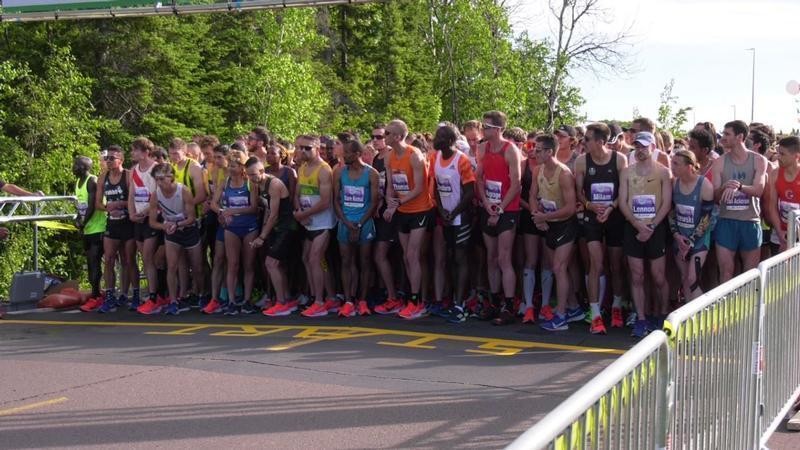
Spectators were originally discouraged from attending this year’s Grandma’s Marathon, but the updated guidance will now allow those who wish to watch the races to do so.
The post-race celebration will be in a new location this year, moving from near the finish line in Canal Park to Bayfront Festival Park. Live musical acts will be featured throughout race day, and admission will be free for all ages in celebration of the 45th anniversary of Grandma’s Marathon.
Amid the excitement of what the new guidelines allow, organizers want to remind anyone planning on participating, volunteering, or attending Grandma’s Marathon that personal responsibility will still play a major role in the weekend’s overall success.
Masks or face coverings, according to the expected guidelines, will be required in all race-controlled areas with more than 500 people in attendance.
Organizers expect that to include the start and finish areas, Bayfront Festival Park, the Michelina’s All-You-Can-Eat Spaghetti Dinner, and the Essentia Health Fitness Expo.
As in the originally released plan, participants will not be required to wear a mask or face covering while actively participating in their race.
Five local groups will take the stage at Bayfront Festival Park on Saturday, June 19 as part of the 45th annual Grandma’s Marathon weekend.
The all-day celebration, which is free and open to all ages, was moved to Bayfront this year from its traditional place near the finish line in Canal Park.
(06/07/2021) ⚡AMPby Aitkin Age
Grandmas Marathon
Grandma's Marathon began in 1977 when a group of local runners planned a scenic road race from Two Harbors to Duluth, Minnesota. There were just 150 participants that year, but organizers knew they had discovered something special. The marathon received its name from the Duluth-based group of famous Grandma's restaurants, its first major sponsor. The level of sponsorship with the...
more...When It’s Time to Rethink Your Hydration
Here are 5 of the most common hydration mistakes—and how to avoid them.
It should go without saying that proper hydration results in a better chance of crushing your performance goals. But too often, people fall into some surprising hydration traps before, during, and after their workouts that keep them from performing their best when it counts most. To help set you on a path to hydrating like a pro, we teamed up with a Honey Stinger athlete and pro sports dietitian to bring to light the hydration mistakes you may be making and the fixes that will make sure your fluids are perfectly topped up.
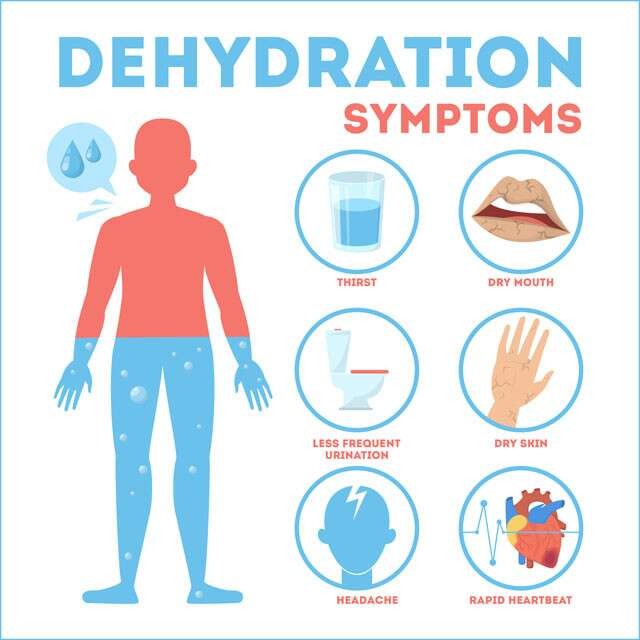
You wait too long to drink
For professional double-amputee runner and Honey Stinger athlete Brian Reynolds, the hydration window for a big run actually begins the night before. “If I try to drink too much right before a race it leaves me with a belly full of water sloshing around and a bloated feeling that is not comfortable for the first few miles.” Instead, Reynolds, who has broken multiple world records for double below-the-knee amputees in the marathon (3:03:22 PR) and half-marathon (1:17:05 PR), takes in two bottles of Honey Stinger Rapid Hydration Mix (“Prepare” Formula) the night before, then a modest 4 to 6 ounces of fluid the morning of his workout.
Allison Maurer is a professional sports dietitian for Honey Stinger and Major League Baseball’s Pittsburgh Pirates. She also supports Reynolds’s night-before “hyperhydration” strategy.
“It’s best to start early with your hydration using an electrolyte drink instead of panicking shortly before a race and trying to drink too much to make up for the lost time,” she says. If you find yourself needing to pee about an hour before your workout, it’s a good sign you’re well-hydrated.
There is only water in your bottle
“Until I settled on Honey Stinger, I used to suffer on my long runs by not taking in enough carbohydrates and electrolytes,” Reynolds confesses. He now brings along a 14-ounce water bottle spiked with Honey Stinger “Perform” Formula and supplements this with fluids from aid stations during races.
Maurer says plain water lacks the electrolytes to improve muscle function and help stave off cramping, and the fast-absorbing carbs to fuel the working body. “The combination of carbs and sodium helps your body hold onto more water for better hydration.”
She says the honey used in Honey Stinger Rapid Hydration Mix absorbs quickly for improved digestion and more efficient fueling without gut rot, while its sodium can help replace a portion of the sodium lost on the run—as much as 1,700 milligrams of sodium per liter of sweat.
You don’t train your gut
It took Reynolds years of trial and error to fine-tune his run hydration and fueling to a method that works for his system. “I suffered through numerous stomach issues until I figured out that the Honey Stinger products settled things down and helped me perform at my best.”
Maurer agrees with taking a highly individualized approach to sports nutrition. “You need to train your gut to see what works specifically for you, in the conditions you’ll face.”
In other words, there is no universal fluid, electrolyte, and carbohydrate guideline to use during workouts. Maurer explains you need to test your hydration strategy during training to gauge tolerance instead of trying something different during a big event. 

You gulp it all down at once
Reynolds has learned that lots of little sips spread throughout works better than guzzling back large amounts less frequently when it comes to midrun hydration. “Drinking small amounts every mile or two is easier on my stomach and keeps my mouth from drying out.”

Maurer stresses that your goal is to avoid the sluggish, ground-down feeling brought on by dehydration and low fuel stores instead of trying to correct the dreaded bonk after it occurs.
Frequently consuming a well-designed hydration product like Honey Stinger Rapid Hydration Mix ("Perform" Formula) will keep you charging hard, as studies have suggested that drinking a predetermined amount of fluid at set times can deliver greater performance gains than simply consuming liquids based on thirst.
You overlook postrun hydration
From experience, Reynolds knows that his hydration needs don’t grind to a halt once he crosses the finish line. “I make a plan to drink 16 to 24 ounces of fluid with the electrolyte-based Honey Stinger Rapid Hydration Mix ("Recover" Formula) shortly following a big run and then keep on hydrating throughout the day.” He knows his recovery will suffer if he doesn’t rehydrate properly.
But Maurer says to space out your rehydration efforts instead of drinking huge amounts of fluids at once. “Drinking too much can make you feel full, which is counterproductive to eating enough to properly refuel.”
Research shows that a honey drink can improve recovery by increasing hydration and replenishment of spent energy stores, leading to better performance during your next workout.
(06/06/2021) ⚡AMPby Runner’s World
Fraser-Pryce blazes 10.63 100m to go No.2 all-time in Kingston
Shelly-Ann Fraser-Pryce has become the second-fastest female 100m sprinter in history with a sensational 10.63 (1.3m/s) run in Kingston, Jamaica, on Saturday (5).
Racing at the aptly-named JOA/JAAA Olympic Destiny Series meeting, Jamaica's two-time Olympic and nine-time world gold medallist further proved her intention to add another title to that tally in Tokyo later this year. Powering out of the blocks, the 34-year-old made it look easy as she hit top speed and surged away from her rivals to run hard through the line before clapping and raising her arms in celebration.
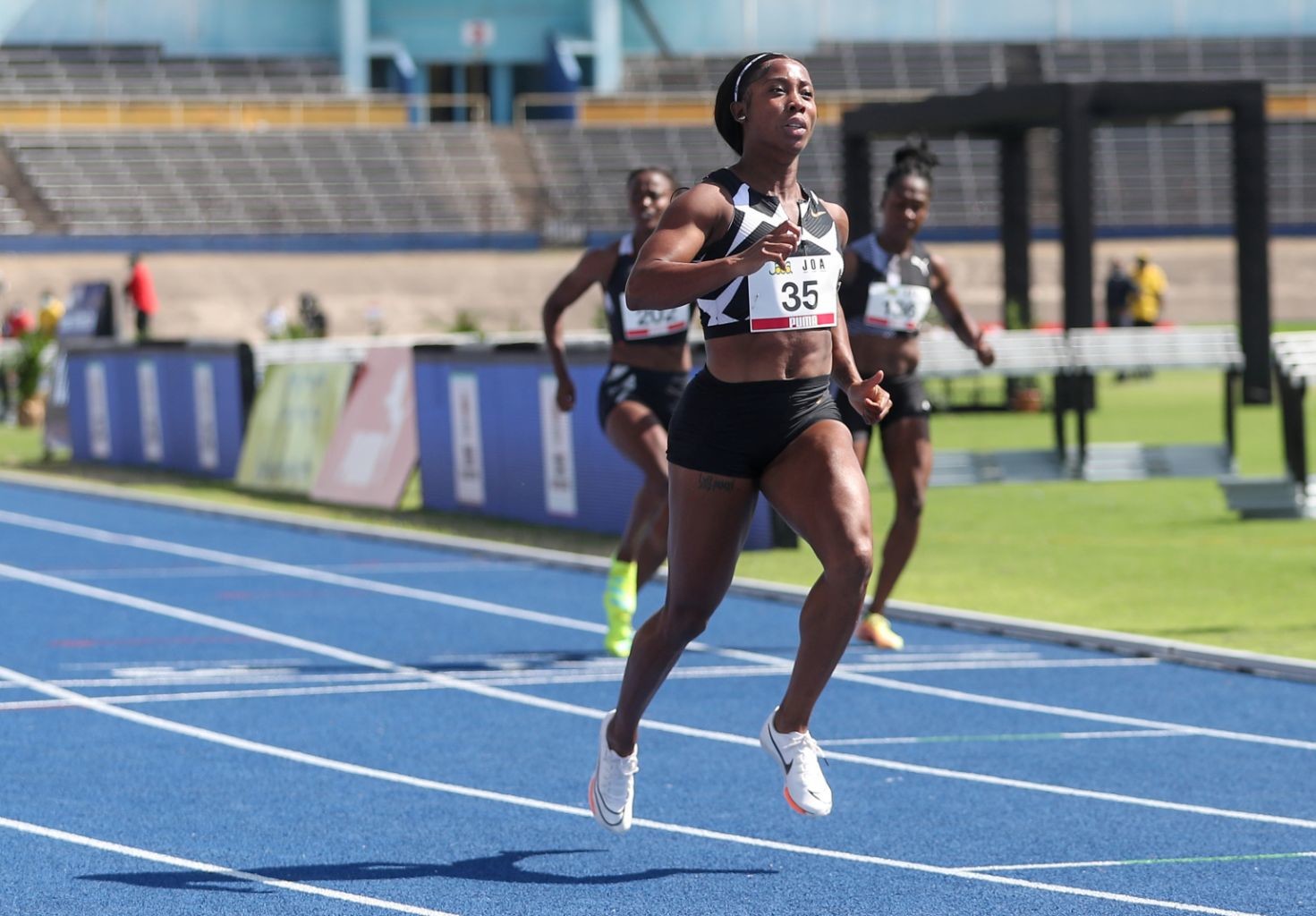
The fastest time in almost 33 years, only Florence Griffith Joyner has ever gone quicker with her world record of 10.49 and runs of 10.61 and 10.62, also achieved in 1988.
"When the hard work finally pays off!" Fraser-Pryce wrote on social media after the race. "So much accomplished, yet so much more to go."
Behind Fraser-Pryce was Natasha Morrison who finished second in 10.95.
The competition was Fraser-Pryce’s third this season and it followed the 10.84 she ran to win at the Wanda Diamond League meeting in Doha as she works towards Tokyo, where she will aim for a third Olympic gold after her 100m wins in 2008 and 2012. Her incredible CV also includes four 100m titles as part of her world championships haul, with her most recent claimed in Doha in 2019 following the birth of her son Zyon in 2017, with Fraser-Pryce having gone into labour while watching the world 100m final that year.
The day before the race in Kingston, she had posted an update on social media which read: "'Mommy' is the best title I could have ever earned."
Fraser-Pryce’s previous best had been 10.70 from 2012, a Jamaican record time which Elaine Thompson-Herah equalled in 2016.
Her performance at the Olympic Destiny Series meeting launches her to the top of the world rankings ahead of the USA's Sha'Carri Richardson, who ran 10.72 in April, and Thompson-Herah, who clocked 10.78 at the start of May.
Also in Kingston, world champion Tajay Gayle jumped a wind-assisted 8.56m (2.5m/s) to win the long jump, while O'Dayne Richards won the shot put with a 19.49m throw.
Others to triumph included Janieve Russell in the 400m hurdles (54.88) and Stephenie Ann McPherson in the 400m (51.06).
(06/06/2021) ⚡AMPby World Athletics
Olympian Amy Cragg Officially Retires and Joins the Puma Coaching Staff in North Carolina
She won bronze in the marathon at the 2017 world championships and ran 2:21:42 at the 2018 Tokyo Marathon—her lifetime best.
Amy Cragg, who represented the U.S. at the 2012 and 2016 Olympics, is officially retiring from professional running. She is now coaching the Puma-sponsored training group alongside her husband, Alistair, in Chapel Hill, North Carolina.
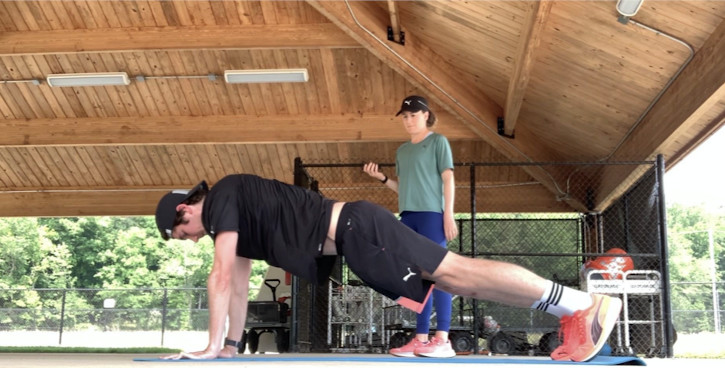
Her career highlights include winning the 2016 Olympic Marathon Trials, finishing third in the marathon at the 2017 world championships, and running a 2:21:42 PR in the 2018 Tokyo Marathon.
Cragg withdrew from the 2020 Olympic Marathon Trials last February, citing illness.
Amy Cragg—who won the 2016 Olympic Marathon Trials, took the bronze medal in the marathon at the 2017 IAAF World Championships, and ran the 2018 Tokyo Marathon in 2:21:42, making her the sixth-fastest American in history at the distance—announced she is retiring from competitive running.
She is now officially a coach with the new Puma-sponsored training group based near Chapel Hill, North Carolina. Her husband, Alistair, is the group’s head coach.
Cragg, 37, said in a phone call with Runner’s World that she took the time she needed to make the decision. “It was definitely time [to retire],” she said. “It’s been great. I’m definitely enjoying life on the other side.”
She had suffered from persistent fatigue over the past couple of years, which kept her from competing at the 2020 Olympic Marathon Trials. Now, she says, she’s feeling well again and running between two and four miles, several times a week, “just to get out there and enjoy it.”
In the summer of 2020, Cragg and her husband drove across the country from their home in Portland, Oregon, where she had trained with Bowerman Track Club for years. They looked at various locations along the way, trying to figure out where to establish Puma’s new training base.
Although they considered different spots at altitude, they ultimately decided the Research Triangle area of North Carolina was ideal for its weather, ease of travel to European track meets and American road races, and the 22-mile, crushed gravel American Tobacco Trail, which has every quarter mile marked. (The Craggs took a wheel out to measure 10 miles of the trail, and the quarters were spot on.)
They also considered medical support in the area, affordability, and job prospects for runners’ significant others.
“I’ve lived in places where people didn’t have a social life or their significant other didn’t have a social life or couldn’t work, and they were depressed,” Cragg said, “and that doesn’t lead to longevity in the sport. We want to create an environment that leads to longevity in the sport. For a lot of people, it takes them a little longer to get there. However long it takes you, we want it to be a good place for that.”
The team currently has Taylor Werner and Fiona O’Keeffe, both of whom are qualified for next month’s U.S. Olympic Track and Field Trials; Steven Fahy, a steeplechaser who currently is nursing a foot injury; and Emmanuel Roudolff-Levisse, a French marathoner. The Craggs—believers in the powers of group training—expect their numbers to grow, albeit slowly.
“We aren’t in a rush to get people,” she said. “We want to get the right people. We’re hoping these are 10-year athletes, not two- or three-year athletes.”
Cragg’s career flourished when she was in her 30s, and she was involved in some of the more memorable moments in Trials history. In 2012, she narrowly missed making the team in the marathon, finishing fourth at the Trials in Houston behind Shalane Flanagan, Desiree Linden (then Davila), and Kara Goucher.
But Cragg (then Hastings) turned her attention back to the track and won the 10,000 meters at the 2012 track trials to earn her first trip to the Games. At the Olympics in London, she finished 11th in 31:10.69, her personal best.
Four years later, at the 2016 Olympic Marathon Trials in Los Angeles, Cragg and training partner Flanagan ran stride for stride together, breaking the race open before the halfway point. But by the 23rd mile, Flanagan was struggling in the heat. Cragg slowed to stay with her, urging her onto the finish. With less than two miles to go, and Linden lurking in the background, Cragg finally left Flanagan and won the race in 2:28:20, waving her visor as she broke the tape.
Linden was second, in 2:28:54, and Flanagan willed herself across the line in third in 2:29:19, where she collapsed and was carried off the course. In Rio, their finishing order was reversed: Flanagan was sixth, Linden seventh, and Cragg ninth, the best collective performance by any country’s three athletes in the event. (The 2016 gold and silver medalists are currently serving suspensions for anti-doping violations.)
Training at times up to 130 miles per week with the Bowerman Track Club in Portland, Cragg qualified for the world championships in 2017 in London. At the race, she moved into third place with 400 meters and sprinted to a bronze medal.
Cragg said that was her top moment as a professional runner. “It kind of just made my entire career worthwhile,” she said.
Seven months later, in Tokyo, she ran her lifetime PR, 2:21:42, taking nearly six minutes off her previous best and putting her among the country’s top runners in history.
Cragg’s world championships bronze marked a renaissance of sorts for American women’s distance running. In Chicago in 2017, Jordan Hasay ran 2:20:57, Flanagan won the New York City Marathon in 2017, and Linden won Boston in 2018.
But after Tokyo, Cragg experienced a series of health setbacks and never was able to regain her top form for a marathon. She ran 15:54 5K in New York in November 2018 and finished third at the U.S. 5K championships, but she raced only twice in 2019. Both races—a 10K and a half marathon—were far from her best. She had planned to run the Chicago Marathon, but pulled out in the summer.
In an interview with Runner’s World at the time, Cragg talked about the fatigue she felt. “I think we just went too hard for too long,” she said. “I ‘cooked myself’ is what I’ll say. Took some time off when we realized it wasn’t coming around for Chicago. Now I’m feeling a lot better and ready to go.”
But citing illness, she withdrew from the 2020 Olympic Marathon Trials in February in Atlanta.
Her only race results from 2020 were pandemic-era intrasquad meets put on by her Bowerman Track Club at a high school track in Portland. Cragg ran a few 400s and 800s at slow paces—seen as fulfilling contractual obligations.
Her peers had nothing but praise for her.
“I’m thrilled for Amy. She’s had a tremendous career,” Linden, who first met Cragg when they were undergraduates at Arizona State University, told Runner’s World in a text message. “If people could have eavesdropped on our long run conversations during our ASU days, they would have laughed at how audacious our goals were. It’s been incredible to watch her check them all off one by one and then accomplish even more. I’m grateful that while being in a hyper-competitive career, Amy’s been able to remain a friend, and I know we’ll have many more conversations about her future goals.”
Shalane Flanagan wrote in a text, “I’m so happy for her. She was a wonderful teammate and one of the toughest athletes I got to train alongside. I treasure all the time spent together chasing big goals and dreams.” 

(06/06/2021) ⚡AMPby Runner’s World


